#how many of you plp would be interested in this
Explore tagged Tumblr posts
Text


The snurge reactor is back (with a small update) I'm giving this one a shot in the skin contest for thunder crack but if It doesn't win I'm making this accent happen either way >:)
#how many of you plp would be interested in this#flight rising#fr skins and accents#thundercrack carnivale
2 notes
·
View notes
Note
002 orleans, 001 peyronan, lets GO
001 | Peyronan
when I started shipping it if I did: Funnily, it went under my radar for YEARS, because I. Did not care about Lazare at ALL. Did not even L I K E him. And the 1789 fandom, as a whole, was VERY anti-Ronan. You could not say ANYTHING positive about Ronan at that time. Then, during a stream of Zuka 1789 in June 2017 (THREE YEARS. WHAT THE FUCK? HOW HAVE THREE YEARS PAST?), I was like “Oh? O H? O H ?” and so It began. I started off with the idea of creating a contained series of drabbles, highlighting the two of them over the course of the musical. The idea was that it would essentially be PWP, disconnected, plotless, researchless, no feelings involved, no softening of Lazare, and would probably end at Ronan’s death. But, as I began working the concepts further, I realized that wouldn’t work, and within a few months of beginning the project, I started to call it “The Abomination”, due to it warping far, far out of my control. These days, a LOT of what I’ve written ties back to those original ideas for The Abomination, and a lot of the concepts used in Between the Waves started there (Printing Press being one of them.)
my thoughts: THE BOIS. THE B O I S. My favorite totally canon ship. The two of them really do balance one another out really well, they’re the classic fire and ice combo (though, underneath Lazare’s ice, there’s fire, and underneath Ronan’s fire, there’s ice.) Ronan’s character arc begins and ends with Lazare, and there’s SOMETHING about him going to Paris with this idea of “Okay, I’m going to kill the Comte, take back my lands, and dance on the ashes of the old world” and then meeting Lazare and being like “...okay, new plan: Save this fucking disaster from himself”. There’s something about his arc going from hatred to love. And could this be done with Olympe as well? Yes, it could be. But, for me, I like the full circle happening with Lazare, since he did start this. Both of them have a Hell of a lot to learn from one another, there’s going to be a lot of grappling when it comes to establishing equality, a lot of sniping back and forth, but I also do think, legitimately, they could make one another happy. (And, Hell, even if they didn’t, that doesn’t mean it can’t be a fun ride.)
What makes me happy about them: The general idea that the Comte de Peyrol, a cold-hearted, professional guard dog who probably never really even THOUGHT of love as something he could have, could melt for this revolutionary, no matter HOW slightly, enough to risk everything for a relationship. That, despite everything else, Ronan could love him back. That, even if only for a few months, they got to be HAPPY with one another.
What makes me sad about them: The ending. The things that were left unresolved. It’s doubly sad in, say, the PLP universe, where Lazare really DID love Ronan with his entire heart, but Ronan really died without KNOWING the extent that Lazare was invested. And that Lazare will have to live the rest of his life, HOWEVER long that will be, thinking of how he destroyed the one person who ever gave a damn about him outside of what he could do for them.
things done in fanfic that annoys me: Given that the fandom mainly consists of me + the various friends I’ve kidnapped into the fandom, there really ISN’T all that much? Like, I feel like the 1789 fandom, as a whole, is a fairly chill space (knock on wood.)
things I look for in fanfic: Existing is a lovely start.
Who I’d be comfortable them ending up with, if not each other: I don’t MIND Camille/Ronan, Ronan/Olympe, or Olympe/Lazare. They aren’t FAVORITES in the same way, but I would probably read fanfic for it. And I have read fanfic for Ronan/Robespierre as well.
My happily ever after for them: Lazare chooses to leave the Army after realizing that it’s destroying him, the two of them escape the worst of the Revolution together and go away, either to London or America (I. Doubt. That someone as high profile as Lazare could slink away to the country like a ton of other aristocrats did.) They live together more or less openly, Lazare deciding against taking a wife for convenience’s sake, and society is left to deal. In theory, they keep two separate bedrooms, but in practice? Yeah, that peasant boy is spending all his time in Lazare’s bed, and Lazare has no complaints.
who is the big spoon/little spoon: See, I WANT to say “Lazare”. This has been my official stance for YEARS. That Ronan routinely cuddles up to Lazare (who had a very difficult time admitting that he, in fact, needs cuddles), and Lazare pulls his arm over him, protecting him, since we KNOW that Lazare tends to feel a deep sense of duty re: protecting the things most important to him, whether that’s the Crown or Ronan. BUT CONSIDER. BIG SPOON RONAN attacking from behind and Lazare getting to feel safe and secure for ONCE.
what is their favorite non-sexual activity: Ronan likes Lazare reading to him. Lazare has a very warm, smooth voice, when he isn’t barking out orders. Ronan loves getting to cuddle against his shoulder or on his lap, Lazare stroking his hair with one hand and holding the book in the other, letting his voice flow over him. Lazare will sometimes (gently) chastise him for not listening to a single word he says, but it’s worth it to see Ronan at peace (and, in the case of at least a few of the works, it isn’t a particularly great loss, anyway.)
002 | Orléans
How I feel about this character: Thotty, ambitious bastard who should NOT be this charismatic and yet somehow IS. Also right for a solid 60% of the musical. I’m trying to articulate all my thoughts but they are just variations on “SON” and “PROBLEMATIC”.
All the people I ship romantically with this character: Margrid Arnaud. Arnaud, Margrid. The sister of Marie Antoinette. Street Gremlin. I can KIND of see Antoinette, in a very, very odd way. Less “I love you so now I’m going to destroy you” like the Hungarian did, more “We were friends, there were Undercurrents to it, Things happened to make them have some mutually hurt feelings, and being stung like that set up this Mood for things later on.”
My non-romantic OTP for this character: I’m actually really interested in Louis & Orléans, as a relationship. Like, they were COUSINS. Something went deeply, deeply bad in their relationship at some point, and it totally ruined both of their lives. In another life, they might have been closer, but, with a throne between them....there was really no other way for it to end.
My unpopular opinion about this character: The LOVELY thing about a fandom that consists of, like, three people on a good day is that IT’S MY SANDBOX. But, one thing that I do think is that it wasn’t really a straightforward Mnaipulator-Manipulatee relationship with Margrid. She signed on knowing fully well that she would get her hands dirty, Orléans TOLD her as much, and she wanted it, at the time. It didn’t really benefit him to conceal what they would be doing. The two of them just happened to drift to two different places over time. I’ve seen a certain....tendency to baby Margrid over her choices, because she DOES have a traumatic backstory, but...she can still be rather reprehensible as a human being herself. In the early stages of the musical, HE’D be more likely to hold her back from doing something awful as opposed to vice versa. I also do think that...he didn’t GO OUT intending to supplant Antoinette. That was formed after years of seeing her bungle ruling the country. You can even see it in M cast when Antoinette turns down Rohan’s attempt to make nice, where he has this very distinct “Oh....she DIDN’T....she did” face. That isn’t the face of someone who’s THRILLED that things are going according to plan, that’s the face of someone who’s realizing that there’s only one way for this to happen and for France to remain in one piece, and it’s for him to take the throne.
One thing I wish would happen / had happened with this character in canon: The problem with Orléans, as a character, is that at least in the Toho production, I DO think he’s fairly well done. It’s hard for me to REALLY see....what I wish could have happened. Because you kind of realize that there were only ever a few ways for this to end, and as the musical progresses, the available options just get narrower and narrower. It isn’t GOOD, but like....you UNDERSTAND how it happens. I do wish that he had more scenes with Margrid, obviously from a self-indulgent ship perspective. Not even in terms of “canonical makeout session” (since I almost feel like a canonical makeout session would ruin it), but in terms of him finding out that Marie was her sister and that THAT was where he went wrong, but also....I’m not sure how MUCH it would have ended, and there’s something to be said for the tragedy of him just never KNOWING why she betrayed him. That hurt, furious look on his face as he’s led away really is probably the best place to end their relationship on. I would have loved to have seen their second meeting, after Hébert convinced her to take the job, since it would have REALLY given a ton of groundwork for their working partnership and would have given them the chance to discuss their kind of disastrous first meeting. Obviously, I would hope that he gets his head screwed on properly and he runs off with Margrid to America, where they end up living peacefully for many years and having children who are spoiled absolutely rotten, along with his other, legitimate children, who also flee to America. Philippe, being himself, naturally ingratiates himself to the new country, becoming very active in politics, and upon his summoning of his dear friend the Chevalier de Saint-Georges to America, the cause of Abolitionism is given a massive head start. It isn’t entirely France....or London, where Philippe’s heart will always lie, but it’s a nice existence, and his ego is suitably stroked by the American fascination with royalty. (He and Laz still have at least one near-duel, which is halted by their respective significant others.)
my OTP: Morléans. Shockingly.
my cross over ship: Never 5get @lochley fucking selling me on Marie/Olympe/Orléans.
a headcanon fact: Part of why he has his ongoing snipefest with Fersen is that he’s bitter that Fersen was able to fight in the American Revolution while, in his case, after the Royal Family tossed him to the wolves after the Battle of Ushant, he was forced to remain in France and sit it out, and someone as active as Orléans could barely STAND it. (Also, along with Ronan, has SOME form of ADHD. He has a lot of plans, and one LARGER plan, but when it comes to things outside of that one larger plan? Yeah, he scurries around, chases after whatever seems good in the moment. It drives Margrid up a WALL.)
1 note
·
View note
Text
Well...any of you--less than handful of humans--that may or may not be reading or viewing my posts still...particularly those of you who still have stuck around this platform after the anti porn sensory....I am, shall I say; “straight up not having a good time bro...;” The only “best friend” I have ever truly had and held with my borderline tendencies for over 11 years...has indeed come to an end. Unfortunately my superhero/role model and highest in regard human; whom I have forever referred to as “my Platonic Life Partner(PLP) and thus that crazy improbable bff of mine for as long as I can remember....has ENDED. While my instability comes as no surprise the particular dextroamphetamine addiction by this idol of mine is what comes as the largest surprise to myself and to anyone who knows this genius... Olivia has always been the oddest ball in the bank (this was my best attempt at coming up with the snazziest idiom I could for all intents and purposes...) but with her bizarre but brilliant idiosyncrasies this human was MY human. I will give you some backstory; she and I were genuinely the least likely of friends possible. I; a former cheerleader and transfer to this random performing arts high school as a result of my basically stalking (groupie style I shall say) favorite drama/English teacher we shall refer to him as Mr. G) and she a brilliant but shrill transfer into the 11th grade as well--both odd --but attempting tour hormonally charged best..to fit in. She and I, while we wouldn't know it just yet....went to the same Shakespeare summer camp at the same times....which would be our first run in among fate. Actually in an absolute coincidental seeming literary device...I JUST found out that I fucking kid you not this sherif assisting me into this strange (but very kind) motel voucher act of kindness was by Sherif Shakespeare...to whom at the front desk I literally uttered the words “is that a joke?” of course to which he denied immediately but once I explained the bizarre literary foreshadowing of also let out a guffaw This girl and I were absolute opposites in every single way first and forever. She was a hissy introverted cat, while I was an (albeit often) obnoxious golden retriever puppy. (I shed way too much blonde hair as well as literally ALWAYS being STOKED to see you whether you be a dear friend or/and new stranger) Not a brag whatsoever and often my largest weakness...a quality I am quite proud of no matter how many times it bites me in the ass...Livie and I were each other’s person! No matter what--through thick and thin...When any vapid jock (which in my search of validation socially in which I was enamored by) Many of those times being my impossibly wild and unscrupulous times that at moments, even my own family, could no longer handle/decidedly emotionally support me in the most basic of ways...Livi was different; she always gave off a confident understanding vibe of my mental health issues reciprocating my infallible love, support and downright forcibly pushing her to be her most fun self...while she (in my best possible interest) slapped sense and reason into me whenever...(I often derailed off these tracks) This was a quality I genuinely always saw as the perfect Ying to Yang quality...I was the most innocently intended extrovert (as goes of course my subjectivity of this story complete with my inherently biased words(while obnoxious).... meaning all the best but lacking structure and thus often the most toxic of individuals-and then her; an introvert that desperately needed someone nearly as headstrong as she in order to even her out into social norms and “let loose...”.which is what--if only--thing I served for her. I was her shitshow and she was my genius idol/intellectual master to my grass hopping/unsure shadow. However as the first encounter I had with her on her “dextroamphetamine” which in this moment of accountability; I will admit I was likely a strong peer pressured influence on....believing this infallible idol of mine, could never do anything but good so I realize now--toxically contributed to! This time I came to her, a mess as always but no new substances just feeling abandoned and emotionally unstable(the usual issues I relied on her wisdom for)...but this time was different... My first night I spent here in the middle of this tiny “footloose” esq town here in Utah...no one knew who this ‘”best friend” of mine even was...at this obscure “kick back”I had been fortunately tagged along to...I’d even often spoken with her current roommate only to hear that--even with her EXPENSIVE double degree from one of the TOP liberal arts colleges in the world--she was making less than Los Angeles minimum wage in this desert(ed) town to nowhere....liked by few, fired even recently and now paying her extremely minimal bills by part time tutoring.... As I am typing this I must say; I began this manifesto with full rage and hatred for this (former) best friend of mine...but as I type this I believe my mother has a point and that this seemingly perfect specimen I have always looked up to seems to be unraveling and this above all breaks my heart more than anything. I guess there are no guarantees whatsoever in this world which is depressing as hell but a minor relief to me, a random Californian, stranded in Utah as a result of a kerfuffle with whom I idolized and could see no flaws within for literally over a decade... Watch who you love closely, and make sure you are truly there for a new med journey because even the best of us are susceptible to functional addiction. Happy Holidays to all. I love you all and blame no one but myself foR my choices and lack of scrutiny of the shift in personality of my who my truest best friend I have ever had the pleasure of calling mine. #RIPtothatrelationship #adventuregram #Carolinecalloway #betrayal #love #chronicles #honestdiaries #vulnerability #happyholidays #iloveyouall #happyholidays
3 notes
·
View notes
Text
McDonnell’s Swedish lesson: flat-packed socialism?
By Vivak Soni
A brief primer on Labour's latest economic policy, as outlined by the shadow chancellor John McDonnell at Labour Party conference in Liverpool on Monday 24th September. Coverage of shadow chancellor John McDonnell’s shared ownership plans were subsumed by Brexit. Odd, given this may have been the most far-reaching element coming out of the event.
If McDonnell gets into Number 11 Downing Street, these proposals will be transformative. So we thought it would be useful to look at them, and also those of the Meidner plan, a similar plan from the Swedish labour movement in the 1970s.
What we know so far
At September’s TUC conference, McDonnell first introduced the proposal that all private companies employing more than 250 people would have to set up “ownership funds,” giving workers financial stakes in their companies and increasing powers to influence how they are run. At Labour conference these plans were further fleshed out. Here’s what we know so far:
· Companies with over 250 members of staff are required to transfer at least 1% of their ownership into an inclusive ownership fund (IOF) each year, up to a maximum 10%. IOF funds will be managed collectively, and shares will not be available for trade or sale.
· Employees therefore become part-owners of the companies they work for, receiving a yearly flat-rate dividend of up to £500.
· Dividends that remain after individual worker payouts go to a national fund, which is then used to invest in public infrastructure and services.
· The levy on private businesses is estimated to be £2.1 billion per year.
· An initial 40% of the private sector workforce stands to benefit from these changes.
Taking inspiration from the Meidner plan
Details on these proposals are still scant (so much so that we don’t have a collective policy name yet). However, there are common links between Labour’s new plans and the earlier Swedish one. Named after Swedish Landsorganisationen (LO) economist Rudolph Meidner, the plan had two main aims:
Equal work should be equally paid, regardless of the profitability of the firm, the size or location of the workplace. What matters is the kind and nature of work, and the skills which are needed to perform it.
Wage differentials should be equalised, but not totally eliminated. Different wages should be paid for different kinds of work.
There are several excellent in-depth analyses of the Meidner plan (including here, here, and this analysis by Rudolph Meidner himself in 1993, available as pdf here). This is a (hopefully) helpful summary. The general outline is summarised in the chart below:

The conflict between full employment and price stability is simply that rising employment pushes wages up, in turn driving inflation. To prevent unchecked inflation, the Meidner plan posited that wage demands were to be restrained. This ‘Solidarity in Wages’ successfully raised the wages of the lowest waged workers, thereby increasing equality whilst maintaining full employment and keeping inflation low. Equality was pursued not only by wage solidarity, but also by a system of universal welfare by a large public sector.
The full implementation of the plan would result in the creation of wage-earner funds, financed through profits made by firms (sounding familiar yet?). The eventual goal was for these funds to become majority owners in these firms as profits continued to flow in.
The legacy of the Meidner plan and it’s relevance for Labour’s new policy
The Meidner plan was never implemented in full: a corporate backlash resulted in a much-watered down version of the wage-earner funds being introduced in 1984. Shares were never issued, with funding instead coming through a profits tax. Without worker funds invested in firms, the ‘Solidarity in Wages’ policy backfired. Whilst inflation was kept in check by wage restraint, businesses gained huge excess profits with no increase in outlay, and no benefits for workers in the form of shares.
What lessons can Labour take from the Swedish experience? As the LO discovered, corporate interests will be keen to water the policy down to an unrecognisable state. Labour will also face enmity from within as members of the PLP who aim to prevent such changes from even getting off the ground (alas for open selection). This point could prove crucial. When the Meidner plan was introduced, Sweden had a long legacy of social democracy stretching back to the 1920s (though high growth rates and full employment in the post-WW2 economy muted talk of nationalisation). In contrast the UK has continued to embrace the free market and the privatisation of state infrastructure since the Thatcher years. The argument has been reframed to such an extent that talk of expanding the social sphere is deemed radical. You can imagine how IOF part-ownership of companies will be received!
The director of the Confederation of British Indsutry (CBI) Carolyn Fairbairn gave us a taste of the backlash to come:
“Their diktat on employee share ownership will only encourage investors to pack their bags and will harm those who can least afford it. If investment falls, so does productivity and pay.”
There’s a strong argument for why she’s wrong. Firstly, these are socialist policies operating within a free market system, and as such are an accommodation as opposed to an upheaval. As such not only are they likely to appease unrest amongst workers, but workers are far more likely to support pro-business policies when they are in their own interest. Secondly, having worker knowledge of the labour process involved in decision making is likely to improve productivity and go some way to soothing the disconnect between workers and management.
These accommodations to business are likely to frustrate many on the left. Rather than attempting an upheaval of a broken system, McDonnell’s plans are set at a more pragmatic level and may well provide a platform for the redistribution of wealth and the resuscitation of our ailing public infrastructure. Tempting though it is, we won’t venture down the Social Democracy vs Marxim wormhole in this particular piece.
Labour’s plans are not a carbon copy of the Meidner plan, however. Where the LO envisioned worker-funds to become majority owners in these firms as profits continued to flow in, McDonnell has stated that the IOFs will cap at 10% ownership, with any excess going towards public services. This could prove a shrewd move as it prevents the IOFs acting in direct competition with firms (starting as they would be from a position of weakness), though a 10% stake in many firms is still likely to make these worker funds the largest shareholders with a substantial voice to influence business policy.
The framing of these proposals is also worth noting here. Whilst these are not huge systemic changes they are presented as exactly that. From a left perspective this is encouraging to hear, with hopes that the 10% is a stepping stone towards even more radical transformation (something big businesses will be aware of too, and the reason why attempts to shut it down before it ever finds its feet will be inevitable). This is not radical politics, but it may be the first tentative step down that road.
For further information links to three articles are provided in the main text. All are recommended, though particularly Meidner’s own analysis from the 1993 Socialist Register.
1 note
·
View note
Text
Fulfill Untapped Customer Demands Through Your Faceted Navigation
Faceted navigation allows customers to narrow down search results based on specific product attributes. They typically exist on Product Listing Pages (PLPs) and are a great way to help users intuitively discover products but managing this filtering system is a common SEO challenge. Crawling and indexation need to be controlled.
However, if we look beyond their inherent functionality, facets can offer us considerable potential. By centering your secondary navigation on long-tail keyword opportunities, you’ll be able to strategically utilize consumer intent, secure additional web conversions, and boost revenue levels.
Match consumer intent with long-tail search queries
Having an established brand and a solid domain backlink profile won’t guarantee success. This is great news for smaller brands, as industry giants aren’t necessarily going to win at this game.
If we search for “long sleeve wedding dresses”, we can see how David’s Bridal’s optimized facet page (Domain Authority: 67/100, Page Authority: 47 / 100) has obtained the top ranking position, while Nordstrom’s result (Domain Authority: 87/100, Page Authority: 39/100) appears in the third position for this particular query. We’ll take a look at what makes this page so effective later.
When looking at how we can optimize faceted navigations, it’s important to recognize that product attributes convey consumer needs and aspirations. If, for example, I’m looking for a wedding dress, then I may tailor my search by the color, fabric, neckline shape, and the sleeve length.
According to the search demand curve, long-tail queries account for up to 70% of all organic searches. They are highly targeted queries that offer big traffic-driving opportunities.
In the last few years, we’ve seen a big shift in the industry towards capitalizing this intent with long-form content. Blog articles and style guides have become the go-to methods for many to capture these visitors, as we can see from the examples taken from Marks & Spencers’ "Inspire Me" section:
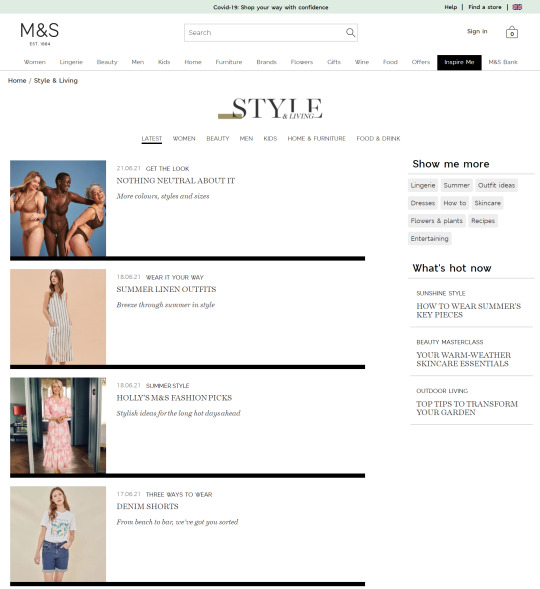
People often look for inspiration when they’re shopping, and these pages provide an effective way to add more internal links to category and product pages. But relying on this approach is one-dimensional, given that these deeper content pages tend to have lower PageRank. An extensive amount of time and effort will, therefore, be required to achieve the desired result.
In comparison, Product Listing Pages usually target broader search terms, and faceted navigations typically exist as passive functions. This is because they’re often blocked from crawlers, making them devoid of any SEO value. Waterstones (a well-known British bookstore) is one retailer that applies this rule for their on-page filters:
In this particular example, I’ve applied a filter to only show me books for 5 – 8 year olds, but the appended URL (https://ift.tt/3xrpOJS) is blocked in the robots.txt file. This is going to prevent such pages from being served in the SERPs despite them having the potential to meet specific customer needs. This shows that there can be a fundamental disconnect in matching customer intent to the pages we’re providing them in the organic results.
From the diagram below, we can see how editorial content typically focuses on the “awareness” and “interest” stages, whilst Product Listing Pages tend to be more in line with the “consideration” and “purchase” phases:
Serving the right content to users throughout their buying journey is pivotal to success. For many retailers, competitors are continuing to prioritize broader, high-volume keywords in saturated markets. They’re targeting the same terms to secure a proportion of the same search traffic. This is a very challenging prospect to face, and without carving out a gap in the marketplace, they won’t necessarily deliver the results they seek to secure. Likewise, relying on informational guides to target long-tail keywords means that you’re missing a large percentage of users who have very specific buying requirements. Yes, they’re ready to make a purchase!
By shifting your focus to address your customer’s real needs and expectations, you’ll be able to deliver a satisfying, frictionless experience at every interaction and all the way through to that final purchase.
The solution
Step 1: Conduct long-tail keyword research
Build a really comprehensive view of your potential customers by harnessing data from a variety of sources, including:
a) Keyword research tools like Moz, Google Keyword Planner, and Answer The Public.
b) The SERPs — get inspiration from the auto-suggest results, People Also Ask, and the related search links at the bottom of the page.
c) Competitor activity — aside from using SEO monitoring software, you can use a data mining extension tool like Scraper, which will extract faceted options directly from competitor Product Listing Pages. These tools are often free to download and allow you to quickly transfer product categories.
d) Your Google Search Console, Analytics, and PPC accounts to determine which keywords and URLs are securing the highest number of visits and web conversions. Internal search data can also give you great consumer insights.
e) Speak to your merchandising team to understand product demands and fulfillment capabilities.
Step 2: Group into meaningful sub-topics
Once you’ve collated all this information into a spreadsheet, you’ll be able to discover long-tail, consideration-orientated keywords. While individually they may not boast huge monthly search estimates, they can collectively highlight where purchase intentions can be better fulfilled.
To help illustrate this point, we can look at a small subset of lingerie keywords and the facets the searches represent:
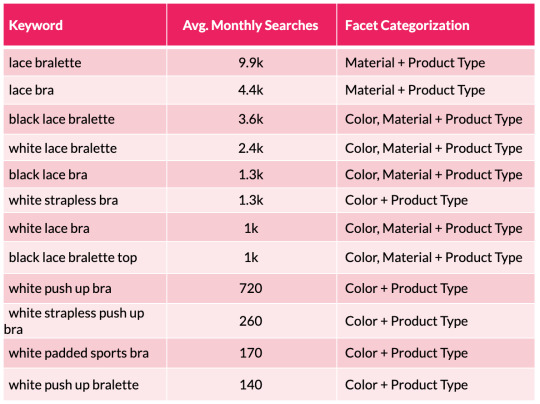
From the table above we can quickly see a pattern emerging with color and material variations appearing across the search terms. We can then substantiate this information with session and revenue estimates with the use of a recognized CTR model. This enables us to help forecast the potential organic uplift and quantify the size of the prize for a number of different scenarios that are on offer from each new facet combination. This may include estimations for securing position 10, 7, 5, 3 and 1 in Google.
One thing to note here is that it’s worth excluding synonyms, as they will falsely inflate your calculations. An example here would be to exclude “storage drawers” (22.2k monthly searchers) when reviewing the performance for “chest of drawers” (201k m/s). Including both variants will cause a false positive result and will lead you to draw incorrect conclusions.
Step 3: Dig deeper into broader terms around offers, ratings, and price
These product filters are found in the “Sort” dropdown box and, from my experience, these are set to “noindex” from the outset as they simply allow users to re-order page results. Certainly, content management systems like Shopify and Shopware have this as a default.
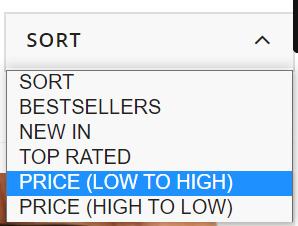
This makes sense since their purpose is to allow visitors to simply sort or narrow page content rather than offering alternative results and additional value (which is offered through faceted navigation). As such, filter typically produce duplicate results which should not be discoverable beyond the immediate moment. But this hard-and-fast rule doesn’t always apply perfectly in the real world. This is why we need to look at our individual industries and understand what’s important to our unique set of customers.
If we look at the world of gifting, we often see people shopping with a particular budget in mind. Therefore, terms like “birthday gift under £20” (40 m/s) or “Secret Santa gift under £10” (2.9k m/s) are reasonably common, and opening up relevant listing pages could be useful for shoppers.
Step 4: The technical steps
Facet taxonomies are hugely complex and the number of attributes that can be strung together increases with the size of the domain. We, therefore, need to carefully manage the flood gates and mitigate against any potential risks including crawl inefficiencies and link equity dilution.
We can do this by:
1. Avoiding thin/doorway pages by regularly re-assessing your product offering. For instance, you may consider there to be little value in creating a new listings page if you’re selling a very small range of low price point products. In this case, you may decide against opening up an additional Product Listing Page when you sell as few as 10 eligible products. However, this is not a fixed rule, so it’s quite possible that your criteria may be lower for particular product lines. Either way, these numbers will change over time. Consider seasonal trends, when new collections are launched, and when they become discontinued. Setting up a product retirement strategy to manage expired products and categories at scale in parallel with this step is also highly recommended.
2. Prevent content cannibalization by arranging selected facets according to their value and significance. “Size” is very important for some electrical goods like TVs, laptops, and cameras, but is less so for beauty accessories or vacuum cleaners. You must also make sure page content is distinctive and reflects the focus of your chosen facet(s). Refer to step 5 for more details.
3. Follow the sequence in which adjectives and facets are typically selected by your customers. This can vary depending on where your audience lives. So, whilst products generally have five or more distinguishable features, English vernacular determines that we use more than four adjectives (e.g. size + color + material + shape) to describe something.
4. Control the controllables by dealing with overlapping variations. This typically occurs when multiples co-exist and each exhibits good search metrics. For instance, it’s reasonable for someone to simultaneously look for several color and/or fabric combinations in the different ways below.
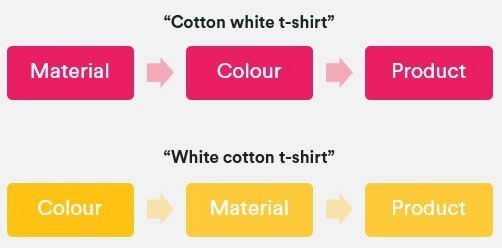
When this situation occurs, we should follow the same linguistic rules as above and choose a preferred sequence. In this case, it would be color + material + product type.
In comparison to the noindex tag suggested for on-page filters you should canonicalize unnecessary facets to their parent page (remembering that this is merely a hint and not a directive). This will enable you to control how crawlers deal with highly comparable result pages and will, therefore, help to prevent your site from being demoted in the SERPs. Dynamic search parameters should continue to be defined with a “noindex, nofollow” meta robots tag, disallowed in the robots.txt file, and configured through Google’s URL parameter tool (within your Search Console account) to tell crawlers the purpose of your parameters and how you would like them to be treated. This is a helpful guide on parameter handling for Googlebots, but bear in mind that this last tip won’t influence how Bing or Yahoo user-agents interpret these pages.
5. Open your facets in phases and cultivate it into a test-and-learn process. This will enable you to identify issues a lot sooner and implement facet-wide solutions in a timely manner. Without having to unravel these additional layers of complexity, problems such as crawl inefficiencies, PageRank dilution, or excessive indexation can be swiftly resolved.
To show you what this could look like, I’ve provided a phasing plan that was created for one of our e-commerce clients. Our research showed a significant SEO opportunity for opening up some of the facets and filters: potential +£263Kpcm for the “colour + type” facet (UK):
What’s more, when we extended our forecast to include other facet combinations, we calculated an additional revenue opportunity of up to +£207K/pcm (before filtering out combinations with no products offering).
Step 5: Optimize your facet URLs
Optimize your new facet category URLs to establish relevancy for your selected search terms. The key on-page elements to focus on include:
URL
Page title
Breadcrumb anchor texts
H tags
Content snippets (e.g. introductory text and FAQ copy)
Image ALT texts
Product names
Link out to similar facet category pages (i.e. via a “You May Also Like” feature box)
David’s Bridal is a good example of a retailer that has done this well. Looking back at the ‘Long Sleeve Wedding Dress’ Product Listing Page, we can see that they’ve curated unique content and followed fundamental optimization tactics on the landing page in a way that feels helpful to the user.
URL: davidsbridal.com/long-sleeve-wedding-dresses
Page Title: Long Sleeve Wedding Dresses & Gowns | David's Bridal
Meta Description: Do you dream of wearing a long sleeve wedding dress on your big day? Shop David's Bridal wide variety of wedding gowns with sleeves in lace & other designs!
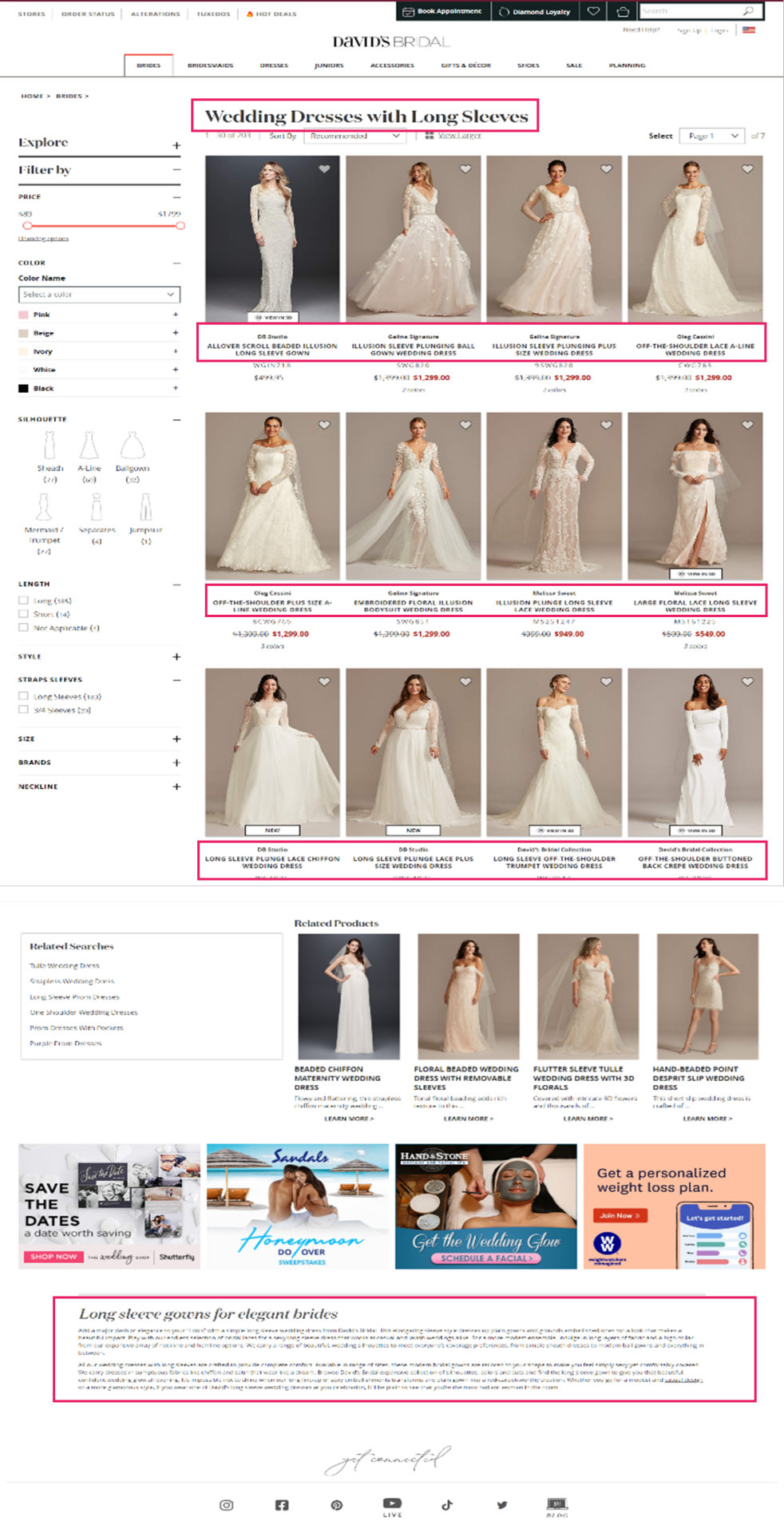
6. Provide accessibility and build page authority
Once you’ve opened up your new facet Product Listing Pages, you need to begin cultivating link equity towards them. This will ensure that they don’t exist as orphan URLs with no PageRank:
Ensure they’re referenced in your product XML sitemap.
If you have one feature per facet URL, then add them to your faceted navigation across CLP and Product Listing Page pages.
If you have two or more features per facet URL, then create a “Popular Searches” or “Related Searches” option within your CLPs.
Utilize your mega menu to showcase your new category landing pages. This will not only allow you to direct a large proportion of link equity, but it will also secure the highest click-through rate amongst your visitors.
Integrate your editorial strategy by creating engaging content with in-copy links. Think about how you can use descriptive long-tail anchor text about the Product Listing Page you want to link to rather than relying on “click here” or “see more”.
Connect to them via href links so you’re not solely relying on links from the main navigation or content hyperlinks. As this is difficult to do at scale, it can be done through modules such as “related categories”, “other subcategories”, “related products”, etc.
Devise strategic outreach campaigns that will secure quality, external backlinks to them.
Implementing this holistic and robust strategy will help you to secure exponential growth from your new commercial landing pages.
Conclusion
There is a great deal of organic opportunity that exists within your faceted navigation if you begin to leverage mid- and long-tail search terms.
Seek out the opportunity from extended keyword research and competitor analysis before deciding which variants fulfill consumer demands and deliver optimal organic sessions and onsite conversions. Configure a single faceted URL for each opportunity and open them up for crawl and indexation. Ensure PageRank is distributed to them (both internally and externally) and develop your landing page content in line with quality optimization practices. This approach will help you to avoid having crawl inefficiencies, over indexation, cannibalization, or having thin doorway pages. In turn, your website will be better suited to attract highly-targeted users and guide them down the purchase funnel.
Maximizing UX and reducing reliance on other marketing channels means that your faceted navigation can truly deliver organic ROI. We have seen this work for our clients.
0 notes
Text
Fulfill Untapped Customer Demands Through Your Faceted Navigation
Faceted navigation allows customers to narrow down search results based on specific product attributes. They typically exist on Product Listing Pages (PLPs) and are a great way to help users intuitively discover products but managing this filtering system is a common SEO challenge. Crawling and indexation need to be controlled.
However, if we look beyond their inherent functionality, facets can offer us considerable potential. By centering your secondary navigation on long-tail keyword opportunities, you’ll be able to strategically utilize consumer intent, secure additional web conversions, and boost revenue levels.
Match consumer intent with long-tail search queries
Having an established brand and a solid domain backlink profile won’t guarantee success. This is great news for smaller brands, as industry giants aren’t necessarily going to win at this game.
If we search for “long sleeve wedding dresses”, we can see how David’s Bridal’s optimized facet page (Domain Authority: 67/100, Page Authority: 47 / 100) has obtained the top ranking position, while Nordstrom’s result (Domain Authority: 87/100, Page Authority: 39/100) appears in the third position for this particular query. We’ll take a look at what makes this page so effective later.
When looking at how we can optimize faceted navigations, it’s important to recognize that product attributes convey consumer needs and aspirations. If, for example, I’m looking for a wedding dress, then I may tailor my search by the color, fabric, neckline shape, and the sleeve length.
According to the search demand curve, long-tail queries account for up to 70% of all organic searches. They are highly targeted queries that offer big traffic-driving opportunities.
In the last few years, we’ve seen a big shift in the industry towards capitalizing this intent with long-form content. Blog articles and style guides have become the go-to methods for many to capture these visitors, as we can see from the examples taken from Marks & Spencers’ "Inspire Me" section:
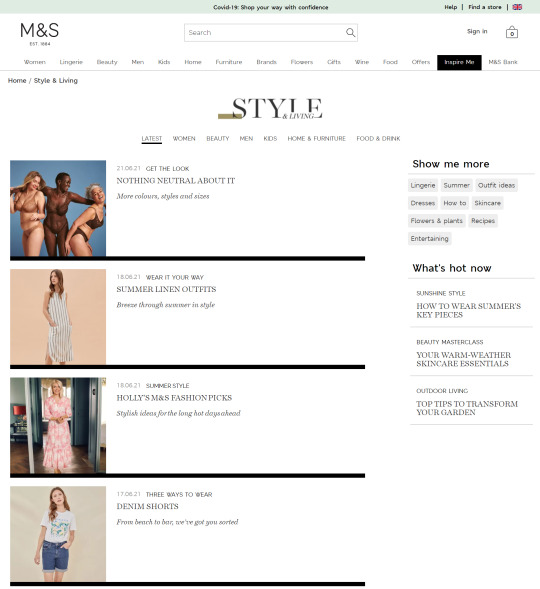
People often look for inspiration when they’re shopping, and these pages provide an effective way to add more internal links to category and product pages. But relying on this approach is one-dimensional, given that these deeper content pages tend to have lower PageRank. An extensive amount of time and effort will, therefore, be required to achieve the desired result.
In comparison, Product Listing Pages usually target broader search terms, and faceted navigations typically exist as passive functions. This is because they’re often blocked from crawlers, making them devoid of any SEO value. Waterstones (a well-known British bookstore) is one retailer that applies this rule for their on-page filters:
In this particular example, I’ve applied a filter to only show me books for 5 – 8 year olds, but the appended URL (https://ift.tt/3xrpOJS) is blocked in the robots.txt file. This is going to prevent such pages from being served in the SERPs despite them having the potential to meet specific customer needs. This shows that there can be a fundamental disconnect in matching customer intent to the pages we’re providing them in the organic results.
From the diagram below, we can see how editorial content typically focuses on the “awareness” and “interest” stages, whilst Product Listing Pages tend to be more in line with the “consideration” and “purchase” phases:
Serving the right content to users throughout their buying journey is pivotal to success. For many retailers, competitors are continuing to prioritize broader, high-volume keywords in saturated markets. They’re targeting the same terms to secure a proportion of the same search traffic. This is a very challenging prospect to face, and without carving out a gap in the marketplace, they won’t necessarily deliver the results they seek to secure. Likewise, relying on informational guides to target long-tail keywords means that you’re missing a large percentage of users who have very specific buying requirements. Yes, they’re ready to make a purchase!
By shifting your focus to address your customer’s real needs and expectations, you’ll be able to deliver a satisfying, frictionless experience at every interaction and all the way through to that final purchase.
The solution
Step 1: Conduct long-tail keyword research
Build a really comprehensive view of your potential customers by harnessing data from a variety of sources, including:
a) Keyword research tools like Moz, Google Keyword Planner, and Answer The Public.
b) The SERPs — get inspiration from the auto-suggest results, People Also Ask, and the related search links at the bottom of the page.
c) Competitor activity — aside from using SEO monitoring software, you can use a data mining extension tool like Scraper, which will extract faceted options directly from competitor Product Listing Pages. These tools are often free to download and allow you to quickly transfer product categories.
d) Your Google Search Console, Analytics, and PPC accounts to determine which keywords and URLs are securing the highest number of visits and web conversions. Internal search data can also give you great consumer insights.
e) Speak to your merchandising team to understand product demands and fulfillment capabilities.
Step 2: Group into meaningful sub-topics
Once you’ve collated all this information into a spreadsheet, you’ll be able to discover long-tail, consideration-orientated keywords. While individually they may not boast huge monthly search estimates, they can collectively highlight where purchase intentions can be better fulfilled.
To help illustrate this point, we can look at a small subset of lingerie keywords and the facets the searches represent:
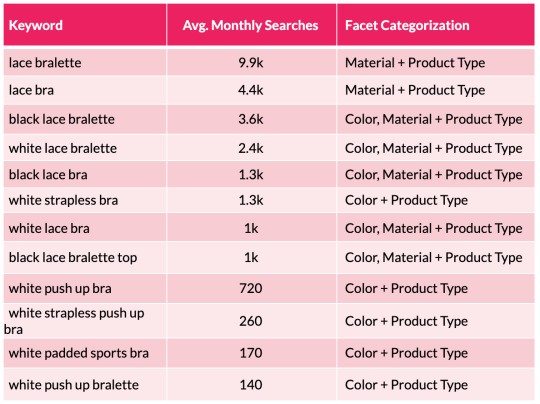
From the table above we can quickly see a pattern emerging with color and material variations appearing across the search terms. We can then substantiate this information with session and revenue estimates with the use of a recognized CTR model. This enables us to help forecast the potential organic uplift and quantify the size of the prize for a number of different scenarios that are on offer from each new facet combination. This may include estimations for securing position 10, 7, 5, 3 and 1 in Google.
One thing to note here is that it’s worth excluding synonyms, as they will falsely inflate your calculations. An example here would be to exclude “storage drawers” (22.2k monthly searchers) when reviewing the performance for “chest of drawers” (201k m/s). Including both variants will cause a false positive result and will lead you to draw incorrect conclusions.
Step 3: Dig deeper into broader terms around offers, ratings, and price
These product filters are found in the “Sort” dropdown box and, from my experience, these are set to “noindex” from the outset as they simply allow users to re-order page results. Certainly, content management systems like Shopify and Shopware have this as a default.
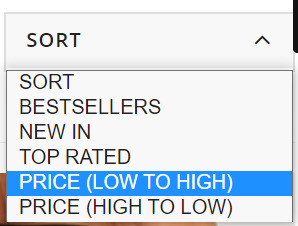
This makes sense since their purpose is to allow visitors to simply sort or narrow page content rather than offering alternative results and additional value (which is offered through faceted navigation). As such, filter typically produce duplicate results which should not be discoverable beyond the immediate moment. But this hard-and-fast rule doesn’t always apply perfectly in the real world. This is why we need to look at our individual industries and understand what’s important to our unique set of customers.
If we look at the world of gifting, we often see people shopping with a particular budget in mind. Therefore, terms like “birthday gift under £20” (40 m/s) or “Secret Santa gift under £10” (2.9k m/s) are reasonably common, and opening up relevant listing pages could be useful for shoppers.
Step 4: The technical steps
Facet taxonomies are hugely complex and the number of attributes that can be strung together increases with the size of the domain. We, therefore, need to carefully manage the flood gates and mitigate against any potential risks including crawl inefficiencies and link equity dilution.
We can do this by:
1. Avoiding thin/doorway pages by regularly re-assessing your product offering. For instance, you may consider there to be little value in creating a new listings page if you’re selling a very small range of low price point products. In this case, you may decide against opening up an additional Product Listing Page when you sell as few as 10 eligible products. However, this is not a fixed rule, so it’s quite possible that your criteria may be lower for particular product lines. Either way, these numbers will change over time. Consider seasonal trends, when new collections are launched, and when they become discontinued. Setting up a product retirement strategy to manage expired products and categories at scale in parallel with this step is also highly recommended.
2. Prevent content cannibalization by arranging selected facets according to their value and significance. “Size” is very important for some electrical goods like TVs, laptops, and cameras, but is less so for beauty accessories or vacuum cleaners. You must also make sure page content is distinctive and reflects the focus of your chosen facet(s). Refer to step 5 for more details.
3. Follow the sequence in which adjectives and facets are typically selected by your customers. This can vary depending on where your audience lives. So, whilst products generally have five or more distinguishable features, English vernacular determines that we use more than four adjectives (e.g. size + color + material + shape) to describe something.
4. Control the controllables by dealing with overlapping variations. This typically occurs when multiples co-exist and each exhibits good search metrics. For instance, it’s reasonable for someone to simultaneously look for several color and/or fabric combinations in the different ways below.
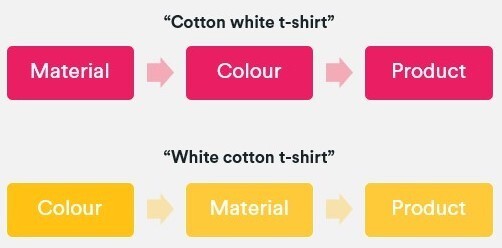
When this situation occurs, we should follow the same linguistic rules as above and choose a preferred sequence. In this case, it would be color + material + product type.
In comparison to the noindex tag suggested for on-page filters you should canonicalize unnecessary facets to their parent page (remembering that this is merely a hint and not a directive). This will enable you to control how crawlers deal with highly comparable result pages and will, therefore, help to prevent your site from being demoted in the SERPs. Dynamic search parameters should continue to be defined with a “noindex, nofollow” meta robots tag, disallowed in the robots.txt file, and configured through Google’s URL parameter tool (within your Search Console account) to tell crawlers the purpose of your parameters and how you would like them to be treated. This is a helpful guide on parameter handling for Googlebots, but bear in mind that this last tip won’t influence how Bing or Yahoo user-agents interpret these pages.
5. Open your facets in phases and cultivate it into a test-and-learn process. This will enable you to identify issues a lot sooner and implement facet-wide solutions in a timely manner. Without having to unravel these additional layers of complexity, problems such as crawl inefficiencies, PageRank dilution, or excessive indexation can be swiftly resolved.
To show you what this could look like, I’ve provided a phasing plan that was created for one of our e-commerce clients. Our research showed a significant SEO opportunity for opening up some of the facets and filters: potential +£263Kpcm for the “colour + type” facet (UK):
What’s more, when we extended our forecast to include other facet combinations, we calculated an additional revenue opportunity of up to +£207K/pcm (before filtering out combinations with no products offering).
Step 5: Optimize your facet URLs
Optimize your new facet category URLs to establish relevancy for your selected search terms. The key on-page elements to focus on include:
URL
Page title
Breadcrumb anchor texts
H tags
Content snippets (e.g. introductory text and FAQ copy)
Image ALT texts
Product names
Link out to similar facet category pages (i.e. via a “You May Also Like” feature box)
David’s Bridal is a good example of a retailer that has done this well. Looking back at the ‘Long Sleeve Wedding Dress’ Product Listing Page, we can see that they’ve curated unique content and followed fundamental optimization tactics on the landing page in a way that feels helpful to the user.
URL: davidsbridal.com/long-sleeve-wedding-dresses
Page Title: Long Sleeve Wedding Dresses & Gowns | David's Bridal
Meta Description: Do you dream of wearing a long sleeve wedding dress on your big day? Shop David's Bridal wide variety of wedding gowns with sleeves in lace & other designs!
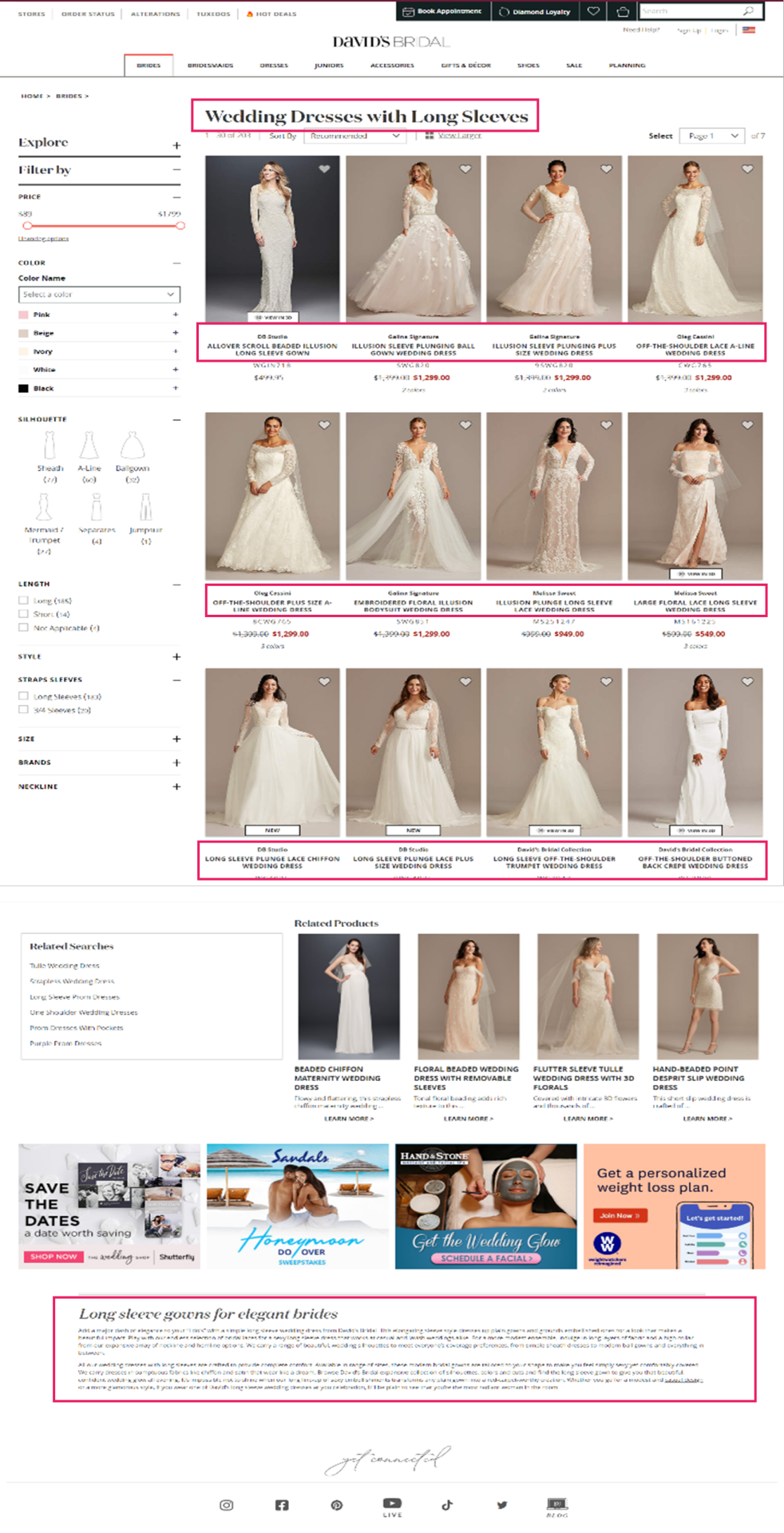
6. Provide accessibility and build page authority
Once you’ve opened up your new facet Product Listing Pages, you need to begin cultivating link equity towards them. This will ensure that they don’t exist as orphan URLs with no PageRank:
Ensure they’re referenced in your product XML sitemap.
If you have one feature per facet URL, then add them to your faceted navigation across CLP and Product Listing Page pages.
If you have two or more features per facet URL, then create a “Popular Searches” or “Related Searches” option within your CLPs.
Utilize your mega menu to showcase your new category landing pages. This will not only allow you to direct a large proportion of link equity, but it will also secure the highest click-through rate amongst your visitors.
Integrate your editorial strategy by creating engaging content with in-copy links. Think about how you can use descriptive long-tail anchor text about the Product Listing Page you want to link to rather than relying on “click here” or “see more”.
Connect to them via href links so you’re not solely relying on links from the main navigation or content hyperlinks. As this is difficult to do at scale, it can be done through modules such as “related categories”, “other subcategories”, “related products”, etc.
Devise strategic outreach campaigns that will secure quality, external backlinks to them.
Implementing this holistic and robust strategy will help you to secure exponential growth from your new commercial landing pages.
Conclusion
There is a great deal of organic opportunity that exists within your faceted navigation if you begin to leverage mid- and long-tail search terms.
Seek out the opportunity from extended keyword research and competitor analysis before deciding which variants fulfill consumer demands and deliver optimal organic sessions and onsite conversions. Configure a single faceted URL for each opportunity and open them up for crawl and indexation. Ensure PageRank is distributed to them (both internally and externally) and develop your landing page content in line with quality optimization practices. This approach will help you to avoid having crawl inefficiencies, over indexation, cannibalization, or having thin doorway pages. In turn, your website will be better suited to attract highly-targeted users and guide them down the purchase funnel.
Maximizing UX and reducing reliance on other marketing channels means that your faceted navigation can truly deliver organic ROI. We have seen this work for our clients.
0 notes
Text
Fulfill Untapped Customer Demands Through Your Faceted Navigation
Faceted navigation allows customers to narrow down search results based on specific product attributes. They typically exist on Product Listing Pages (PLPs) and are a great way to help users intuitively discover products but managing this filtering system is a common SEO challenge. Crawling and indexation need to be controlled.
However, if we look beyond their inherent functionality, facets can offer us considerable potential. By centering your secondary navigation on long-tail keyword opportunities, you’ll be able to strategically utilize consumer intent, secure additional web conversions, and boost revenue levels.
Match consumer intent with long-tail search queries
Having an established brand and a solid domain backlink profile won’t guarantee success. This is great news for smaller brands, as industry giants aren’t necessarily going to win at this game.
If we search for “long sleeve wedding dresses”, we can see how David’s Bridal’s optimized facet page (Domain Authority: 67/100, Page Authority: 47 / 100) has obtained the top ranking position, while Nordstrom’s result (Domain Authority: 87/100, Page Authority: 39/100) appears in the third position for this particular query. We’ll take a look at what makes this page so effective later.
When looking at how we can optimize faceted navigations, it’s important to recognize that product attributes convey consumer needs and aspirations. If, for example, I’m looking for a wedding dress, then I may tailor my search by the color, fabric, neckline shape, and the sleeve length.
According to the search demand curve, long-tail queries account for up to 70% of all organic searches. They are highly targeted queries that offer big traffic-driving opportunities.
In the last few years, we’ve seen a big shift in the industry towards capitalizing this intent with long-form content. Blog articles and style guides have become the go-to methods for many to capture these visitors, as we can see from the examples taken from Marks & Spencers’ "Inspire Me" section:
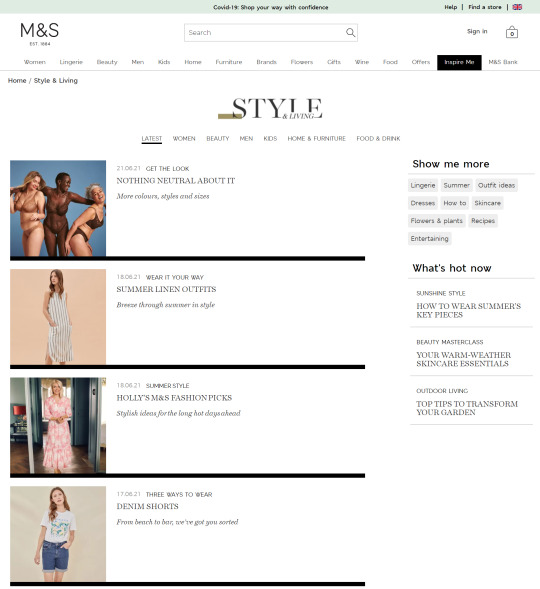
People often look for inspiration when they’re shopping, and these pages provide an effective way to add more internal links to category and product pages. But relying on this approach is one-dimensional, given that these deeper content pages tend to have lower PageRank. An extensive amount of time and effort will, therefore, be required to achieve the desired result.
In comparison, Product Listing Pages usually target broader search terms, and faceted navigations typically exist as passive functions. This is because they’re often blocked from crawlers, making them devoid of any SEO value. Waterstones (a well-known British bookstore) is one retailer that applies this rule for their on-page filters:
In this particular example, I’ve applied a filter to only show me books for 5 – 8 year olds, but the appended URL (https://ift.tt/3xrpOJS) is blocked in the robots.txt file. This is going to prevent such pages from being served in the SERPs despite them having the potential to meet specific customer needs. This shows that there can be a fundamental disconnect in matching customer intent to the pages we’re providing them in the organic results.
From the diagram below, we can see how editorial content typically focuses on the “awareness” and “interest” stages, whilst Product Listing Pages tend to be more in line with the “consideration” and “purchase” phases:
Serving the right content to users throughout their buying journey is pivotal to success. For many retailers, competitors are continuing to prioritize broader, high-volume keywords in saturated markets. They’re targeting the same terms to secure a proportion of the same search traffic. This is a very challenging prospect to face, and without carving out a gap in the marketplace, they won’t necessarily deliver the results they seek to secure. Likewise, relying on informational guides to target long-tail keywords means that you’re missing a large percentage of users who have very specific buying requirements. Yes, they’re ready to make a purchase!
By shifting your focus to address your customer’s real needs and expectations, you’ll be able to deliver a satisfying, frictionless experience at every interaction and all the way through to that final purchase.
The solution
Step 1: Conduct long-tail keyword research
Build a really comprehensive view of your potential customers by harnessing data from a variety of sources, including:
a) Keyword research tools like Moz, Google Keyword Planner, and Answer The Public.
b) The SERPs — get inspiration from the auto-suggest results, People Also Ask, and the related search links at the bottom of the page.
c) Competitor activity — aside from using SEO monitoring software, you can use a data mining extension tool like Scraper, which will extract faceted options directly from competitor Product Listing Pages. These tools are often free to download and allow you to quickly transfer product categories.
d) Your Google Search Console, Analytics, and PPC accounts to determine which keywords and URLs are securing the highest number of visits and web conversions. Internal search data can also give you great consumer insights.
e) Speak to your merchandising team to understand product demands and fulfillment capabilities.
Step 2: Group into meaningful sub-topics
Once you’ve collated all this information into a spreadsheet, you’ll be able to discover long-tail, consideration-orientated keywords. While individually they may not boast huge monthly search estimates, they can collectively highlight where purchase intentions can be better fulfilled.
To help illustrate this point, we can look at a small subset of lingerie keywords and the facets the searches represent:
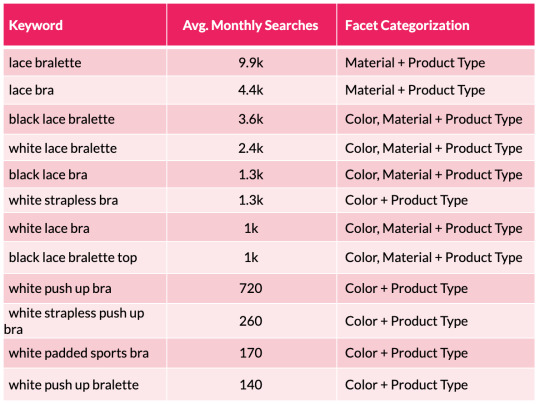
From the table above we can quickly see a pattern emerging with color and material variations appearing across the search terms. We can then substantiate this information with session and revenue estimates with the use of a recognized CTR model. This enables us to help forecast the potential organic uplift and quantify the size of the prize for a number of different scenarios that are on offer from each new facet combination. This may include estimations for securing position 10, 7, 5, 3 and 1 in Google.
One thing to note here is that it’s worth excluding synonyms, as they will falsely inflate your calculations. An example here would be to exclude “storage drawers” (22.2k monthly searchers) when reviewing the performance for “chest of drawers” (201k m/s). Including both variants will cause a false positive result and will lead you to draw incorrect conclusions.
Step 3: Dig deeper into broader terms around offers, ratings, and price
These product filters are found in the “Sort” dropdown box and, from my experience, these are set to “noindex” from the outset as they simply allow users to re-order page results. Certainly, content management systems like Shopify and Shopware have this as a default.
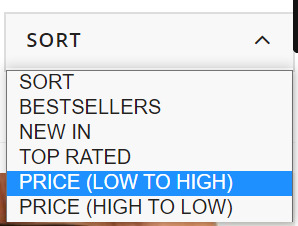
This makes sense since their purpose is to allow visitors to simply sort or narrow page content rather than offering alternative results and additional value (which is offered through faceted navigation). As such, filter typically produce duplicate results which should not be discoverable beyond the immediate moment. But this hard-and-fast rule doesn’t always apply perfectly in the real world. This is why we need to look at our individual industries and understand what’s important to our unique set of customers.
If we look at the world of gifting, we often see people shopping with a particular budget in mind. Therefore, terms like “birthday gift under £20” (40 m/s) or “Secret Santa gift under £10” (2.9k m/s) are reasonably common, and opening up relevant listing pages could be useful for shoppers.
Step 4: The technical steps
Facet taxonomies are hugely complex and the number of attributes that can be strung together increases with the size of the domain. We, therefore, need to carefully manage the flood gates and mitigate against any potential risks including crawl inefficiencies and link equity dilution.
We can do this by:
1. Avoiding thin/doorway pages by regularly re-assessing your product offering. For instance, you may consider there to be little value in creating a new listings page if you’re selling a very small range of low price point products. In this case, you may decide against opening up an additional Product Listing Page when you sell as few as 10 eligible products. However, this is not a fixed rule, so it’s quite possible that your criteria may be lower for particular product lines. Either way, these numbers will change over time. Consider seasonal trends, when new collections are launched, and when they become discontinued. Setting up a product retirement strategy to manage expired products and categories at scale in parallel with this step is also highly recommended.
2. Prevent content cannibalization by arranging selected facets according to their value and significance. “Size” is very important for some electrical goods like TVs, laptops, and cameras, but is less so for beauty accessories or vacuum cleaners. You must also make sure page content is distinctive and reflects the focus of your chosen facet(s). Refer to step 5 for more details.
3. Follow the sequence in which adjectives and facets are typically selected by your customers. This can vary depending on where your audience lives. So, whilst products generally have five or more distinguishable features, English vernacular determines that we use more than four adjectives (e.g. size + color + material + shape) to describe something.
4. Control the controllables by dealing with overlapping variations. This typically occurs when multiples co-exist and each exhibits good search metrics. For instance, it’s reasonable for someone to simultaneously look for several color and/or fabric combinations in the different ways below.

When this situation occurs, we should follow the same linguistic rules as above and choose a preferred sequence. In this case, it would be color + material + product type.
In comparison to the noindex tag suggested for on-page filters you should canonicalize unnecessary facets to their parent page (remembering that this is merely a hint and not a directive). This will enable you to control how crawlers deal with highly comparable result pages and will, therefore, help to prevent your site from being demoted in the SERPs. Dynamic search parameters should continue to be defined with a “noindex, nofollow” meta robots tag, disallowed in the robots.txt file, and configured through Google’s URL parameter tool (within your Search Console account) to tell crawlers the purpose of your parameters and how you would like them to be treated. This is a helpful guide on parameter handling for Googlebots, but bear in mind that this last tip won’t influence how Bing or Yahoo user-agents interpret these pages.
5. Open your facets in phases and cultivate it into a test-and-learn process. This will enable you to identify issues a lot sooner and implement facet-wide solutions in a timely manner. Without having to unravel these additional layers of complexity, problems such as crawl inefficiencies, PageRank dilution, or excessive indexation can be swiftly resolved.
To show you what this could look like, I’ve provided a phasing plan that was created for one of our e-commerce clients. Our research showed a significant SEO opportunity for opening up some of the facets and filters: potential +£263Kpcm for the “colour + type” facet (UK):
What’s more, when we extended our forecast to include other facet combinations, we calculated an additional revenue opportunity of up to +£207K/pcm (before filtering out combinations with no products offering).
Step 5: Optimize your facet URLs
Optimize your new facet category URLs to establish relevancy for your selected search terms. The key on-page elements to focus on include:
URL
Page title
Breadcrumb anchor texts
H tags
Content snippets (e.g. introductory text and FAQ copy)
Image ALT texts
Product names
Link out to similar facet category pages (i.e. via a “You May Also Like” feature box)
David’s Bridal is a good example of a retailer that has done this well. Looking back at the ‘Long Sleeve Wedding Dress’ Product Listing Page, we can see that they’ve curated unique content and followed fundamental optimization tactics on the landing page in a way that feels helpful to the user.
URL: davidsbridal.com/long-sleeve-wedding-dresses
Page Title: Long Sleeve Wedding Dresses & Gowns | David's Bridal
Meta Description: Do you dream of wearing a long sleeve wedding dress on your big day? Shop David's Bridal wide variety of wedding gowns with sleeves in lace & other designs!
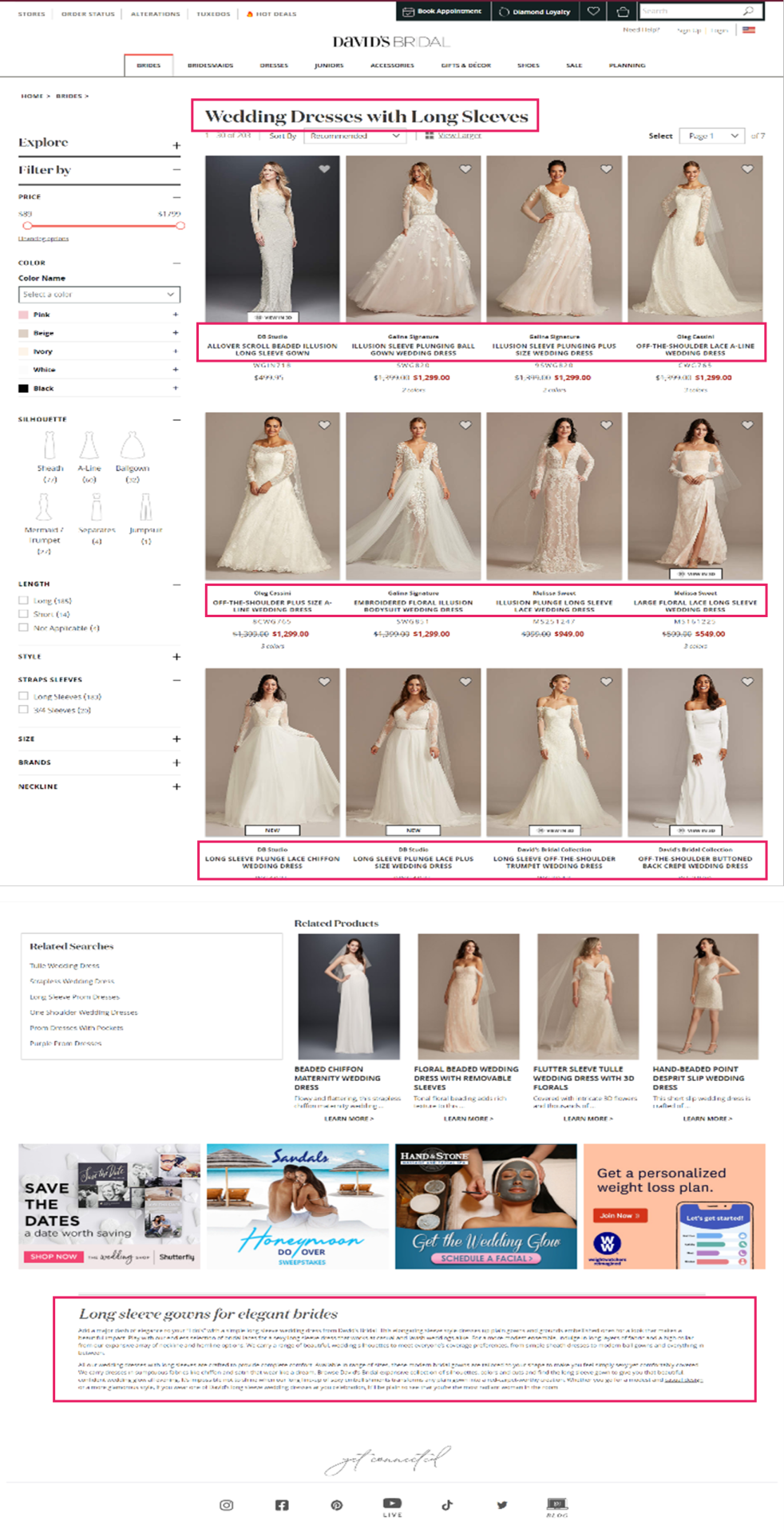
6. Provide accessibility and build page authority
Once you’ve opened up your new facet Product Listing Pages, you need to begin cultivating link equity towards them. This will ensure that they don’t exist as orphan URLs with no PageRank:
Ensure they’re referenced in your product XML sitemap.
If you have one feature per facet URL, then add them to your faceted navigation across CLP and Product Listing Page pages.
If you have two or more features per facet URL, then create a “Popular Searches” or “Related Searches” option within your CLPs.
Utilize your mega menu to showcase your new category landing pages. This will not only allow you to direct a large proportion of link equity, but it will also secure the highest click-through rate amongst your visitors.
Integrate your editorial strategy by creating engaging content with in-copy links. Think about how you can use descriptive long-tail anchor text about the Product Listing Page you want to link to rather than relying on “click here” or “see more”.
Connect to them via href links so you’re not solely relying on links from the main navigation or content hyperlinks. As this is difficult to do at scale, it can be done through modules such as “related categories”, “other subcategories”, “related products”, etc.
Devise strategic outreach campaigns that will secure quality, external backlinks to them.
Implementing this holistic and robust strategy will help you to secure exponential growth from your new commercial landing pages.
Conclusion
There is a great deal of organic opportunity that exists within your faceted navigation if you begin to leverage mid- and long-tail search terms.
Seek out the opportunity from extended keyword research and competitor analysis before deciding which variants fulfill consumer demands and deliver optimal organic sessions and onsite conversions. Configure a single faceted URL for each opportunity and open them up for crawl and indexation. Ensure PageRank is distributed to them (both internally and externally) and develop your landing page content in line with quality optimization practices. This approach will help you to avoid having crawl inefficiencies, over indexation, cannibalization, or having thin doorway pages. In turn, your website will be better suited to attract highly-targeted users and guide them down the purchase funnel.
Maximizing UX and reducing reliance on other marketing channels means that your faceted navigation can truly deliver organic ROI. We have seen this work for our clients.
#túi_giấy_epacking_việt_nam #túi_giấy_epacking #in_túi_giấy_giá_rẻ #in_túi_giấy #epackingvietnam #tuigiayepacking
0 notes
Text
Fulfill Untapped Customer Demands Through Your Faceted Navigation
Faceted navigation allows customers to narrow down search results based on specific product attributes. They typically exist on Product Listing Pages (PLPs) and are a great way to help users intuitively discover products but managing this filtering system is a common SEO challenge. Crawling and indexation need to be controlled.
However, if we look beyond their inherent functionality, facets can offer us considerable potential. By centering your secondary navigation on long-tail keyword opportunities, you’ll be able to strategically utilize consumer intent, secure additional web conversions, and boost revenue levels.
Match consumer intent with long-tail search queries
Having an established brand and a solid domain backlink profile won’t guarantee success. This is great news for smaller brands, as industry giants aren’t necessarily going to win at this game.
If we search for “long sleeve wedding dresses”, we can see how David’s Bridal’s optimized facet page (Domain Authority: 67/100, Page Authority: 47 / 100) has obtained the top ranking position, while Nordstrom’s result (Domain Authority: 87/100, Page Authority: 39/100) appears in the third position for this particular query. We’ll take a look at what makes this page so effective later.
When looking at how we can optimize faceted navigations, it’s important to recognize that product attributes convey consumer needs and aspirations. If, for example, I’m looking for a wedding dress, then I may tailor my search by the color, fabric, neckline shape, and the sleeve length.
According to the search demand curve, long-tail queries account for up to 70% of all organic searches. They are highly targeted queries that offer big traffic-driving opportunities.
In the last few years, we’ve seen a big shift in the industry towards capitalizing this intent with long-form content. Blog articles and style guides have become the go-to methods for many to capture these visitors, as we can see from the examples taken from Marks & Spencers’ "Inspire Me" section:
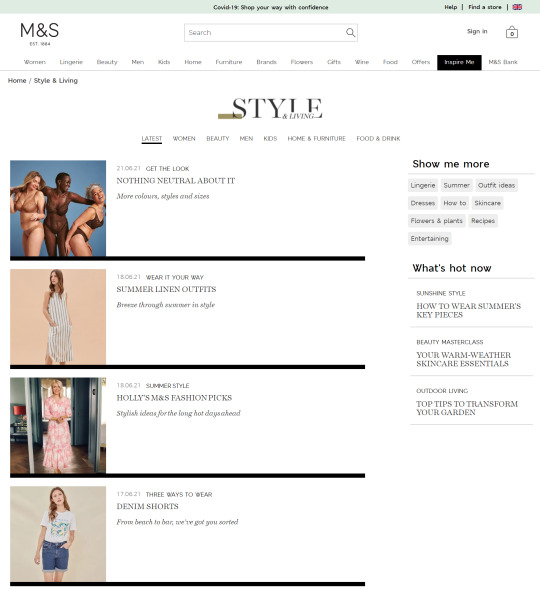
People often look for inspiration when they’re shopping, and these pages provide an effective way to add more internal links to category and product pages. But relying on this approach is one-dimensional, given that these deeper content pages tend to have lower PageRank. An extensive amount of time and effort will, therefore, be required to achieve the desired result.
In comparison, Product Listing Pages usually target broader search terms, and faceted navigations typically exist as passive functions. This is because they’re often blocked from crawlers, making them devoid of any SEO value. Waterstones (a well-known British bookstore) is one retailer that applies this rule for their on-page filters:
In this particular example, I’ve applied a filter to only show me books for 5 – 8 year olds, but the appended URL (https://www.waterstones.com/category/childrens-teenage/facet/498) is blocked in the robots.txt file. This is going to prevent such pages from being served in the SERPs despite them having the potential to meet specific customer needs. This shows that there can be a fundamental disconnect in matching customer intent to the pages we’re providing them in the organic results.
From the diagram below, we can see how editorial content typically focuses on the “awareness” and “interest” stages, whilst Product Listing Pages tend to be more in line with the “consideration” and “purchase” phases:
Serving the right content to users throughout their buying journey is pivotal to success. For many retailers, competitors are continuing to prioritize broader, high-volume keywords in saturated markets. They’re targeting the same terms to secure a proportion of the same search traffic. This is a very challenging prospect to face, and without carving out a gap in the marketplace, they won’t necessarily deliver the results they seek to secure. Likewise, relying on informational guides to target long-tail keywords means that you’re missing a large percentage of users who have very specific buying requirements. Yes, they’re ready to make a purchase!
By shifting your focus to address your customer’s real needs and expectations, you’ll be able to deliver a satisfying, frictionless experience at every interaction and all the way through to that final purchase.
The solution
Step 1: Conduct long-tail keyword research
Build a really comprehensive view of your potential customers by harnessing data from a variety of sources, including:
a) Keyword research tools like Moz, Google Keyword Planner, and Answer The Public.
b) The SERPs — get inspiration from the auto-suggest results, People Also Ask, and the related search links at the bottom of the page.
c) Competitor activity — aside from using SEO monitoring software, you can use a data mining extension tool like Scraper, which will extract faceted options directly from competitor Product Listing Pages. These tools are often free to download and allow you to quickly transfer product categories.
d) Your Google Search Console, Analytics, and PPC accounts to determine which keywords and URLs are securing the highest number of visits and web conversions. Internal search data can also give you great consumer insights.
e) Speak to your merchandising team to understand product demands and fulfillment capabilities.
Step 2: Group into meaningful sub-topics
Once you’ve collated all this information into a spreadsheet, you’ll be able to discover long-tail, consideration-orientated keywords. While individually they may not boast huge monthly search estimates, they can collectively highlight where purchase intentions can be better fulfilled.
To help illustrate this point, we can look at a small subset of lingerie keywords and the facets the searches represent:
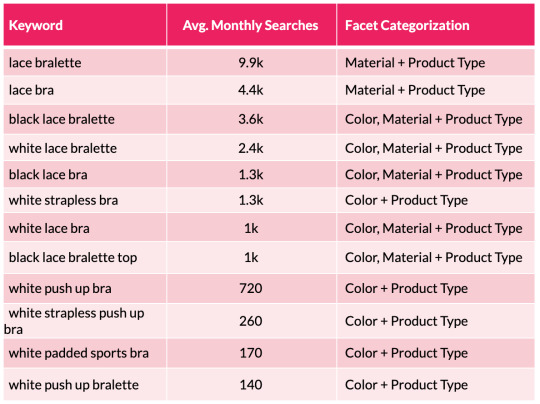
From the table above we can quickly see a pattern emerging with color and material variations appearing across the search terms. We can then substantiate this information with session and revenue estimates with the use of a recognized CTR model. This enables us to help forecast the potential organic uplift and quantify the size of the prize for a number of different scenarios that are on offer from each new facet combination. This may include estimations for securing position 10, 7, 5, 3 and 1 in Google.
One thing to note here is that it’s worth excluding synonyms, as they will falsely inflate your calculations. An example here would be to exclude “storage drawers” (22.2k monthly searchers) when reviewing the performance for “chest of drawers” (201k m/s). Including both variants will cause a false positive result and will lead you to draw incorrect conclusions.
Step 3: Dig deeper into broader terms around offers, ratings, and price
These product filters are found in the “Sort” dropdown box and, from my experience, these are set to “noindex” from the outset as they simply allow users to re-order page results. Certainly, content management systems like Shopify and Shopware have this as a default.
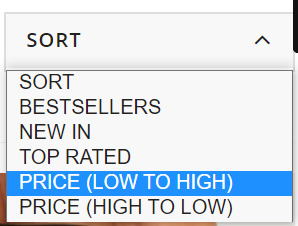
This makes sense since their purpose is to allow visitors to simply sort or narrow page content rather than offering alternative results and additional value (which is offered through faceted navigation). As such, filter typically produce duplicate results which should not be discoverable beyond the immediate moment. But this hard-and-fast rule doesn’t always apply perfectly in the real world. This is why we need to look at our individual industries and understand what’s important to our unique set of customers.
If we look at the world of gifting, we often see people shopping with a particular budget in mind. Therefore, terms like “birthday gift under £20” (40 m/s) or “Secret Santa gift under £10” (2.9k m/s) are reasonably common, and opening up relevant listing pages could be useful for shoppers.
Step 4: The technical steps
Facet taxonomies are hugely complex and the number of attributes that can be strung together increases with the size of the domain. We, therefore, need to carefully manage the flood gates and mitigate against any potential risks including crawl inefficiencies and link equity dilution.
We can do this by:
1. Avoiding thin/doorway pages by regularly re-assessing your product offering. For instance, you may consider there to be little value in creating a new listings page if you’re selling a very small range of low price point products. In this case, you may decide against opening up an additional Product Listing Page when you sell as few as 10 eligible products. However, this is not a fixed rule, so it’s quite possible that your criteria may be lower for particular product lines. Either way, these numbers will change over time. Consider seasonal trends, when new collections are launched, and when they become discontinued. Setting up a product retirement strategy to manage expired products and categories at scale in parallel with this step is also highly recommended.
2. Prevent content cannibalization by arranging selected facets according to their value and significance. “Size” is very important for some electrical goods like TVs, laptops, and cameras, but is less so for beauty accessories or vacuum cleaners. You must also make sure page content is distinctive and reflects the focus of your chosen facet(s). Refer to step 5 for more details.
3. Follow the sequence in which adjectives and facets are typically selected by your customers. This can vary depending on where your audience lives. So, whilst products generally have five or more distinguishable features, English vernacular determines that we use more than four adjectives (e.g. size + color + material + shape) to describe something.
4. Control the controllables by dealing with overlapping variations. This typically occurs when multiples co-exist and each exhibits good search metrics. For instance, it’s reasonable for someone to simultaneously look for several color and/or fabric combinations in the different ways below.
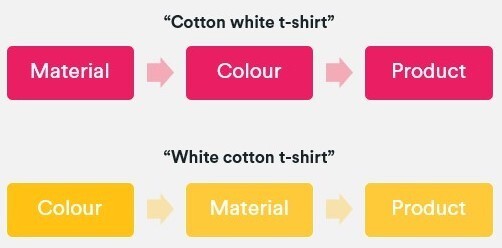
When this situation occurs, we should follow the same linguistic rules as above and choose a preferred sequence. In this case, it would be color + material + product type.
In comparison to the noindex tag suggested for on-page filters you should canonicalize unnecessary facets to their parent page (remembering that this is merely a hint and not a directive). This will enable you to control how crawlers deal with highly comparable result pages and will, therefore, help to prevent your site from being demoted in the SERPs. Dynamic search parameters should continue to be defined with a “noindex, nofollow” meta robots tag, disallowed in the robots.txt file, and configured through Google’s URL parameter tool (within your Search Console account) to tell crawlers the purpose of your parameters and how you would like them to be treated. This is a helpful guide on parameter handling for Googlebots, but bear in mind that this last tip won’t influence how Bing or Yahoo user-agents interpret these pages.
5. Open your facets in phases and cultivate it into a test-and-learn process. This will enable you to identify issues a lot sooner and implement facet-wide solutions in a timely manner. Without having to unravel these additional layers of complexity, problems such as crawl inefficiencies, PageRank dilution, or excessive indexation can be swiftly resolved.
To show you what this could look like, I’ve provided a phasing plan that was created for one of our e-commerce clients. Our research showed a significant SEO opportunity for opening up some of the facets and filters: potential +£263Kpcm for the “colour + type” facet (UK):
What’s more, when we extended our forecast to include other facet combinations, we calculated an additional revenue opportunity of up to +£207K/pcm (before filtering out combinations with no products offering).
Step 5: Optimize your facet URLs
Optimize your new facet category URLs to establish relevancy for your selected search terms. The key on-page elements to focus on include:
URL
Page title
Breadcrumb anchor texts
H tags
Content snippets (e.g. introductory text and FAQ copy)
Image ALT texts
Product names
Link out to similar facet category pages (i.e. via a “You May Also Like” feature box)
David’s Bridal is a good example of a retailer that has done this well. Looking back at the ‘Long Sleeve Wedding Dress’ Product Listing Page, we can see that they’ve curated unique content and followed fundamental optimization tactics on the landing page in a way that feels helpful to the user.
URL: davidsbridal.com/long-sleeve-wedding-dresses
Page Title: Long Sleeve Wedding Dresses & Gowns | David's Bridal
Meta Description: Do you dream of wearing a long sleeve wedding dress on your big day? Shop David's Bridal wide variety of wedding gowns with sleeves in lace & other designs!
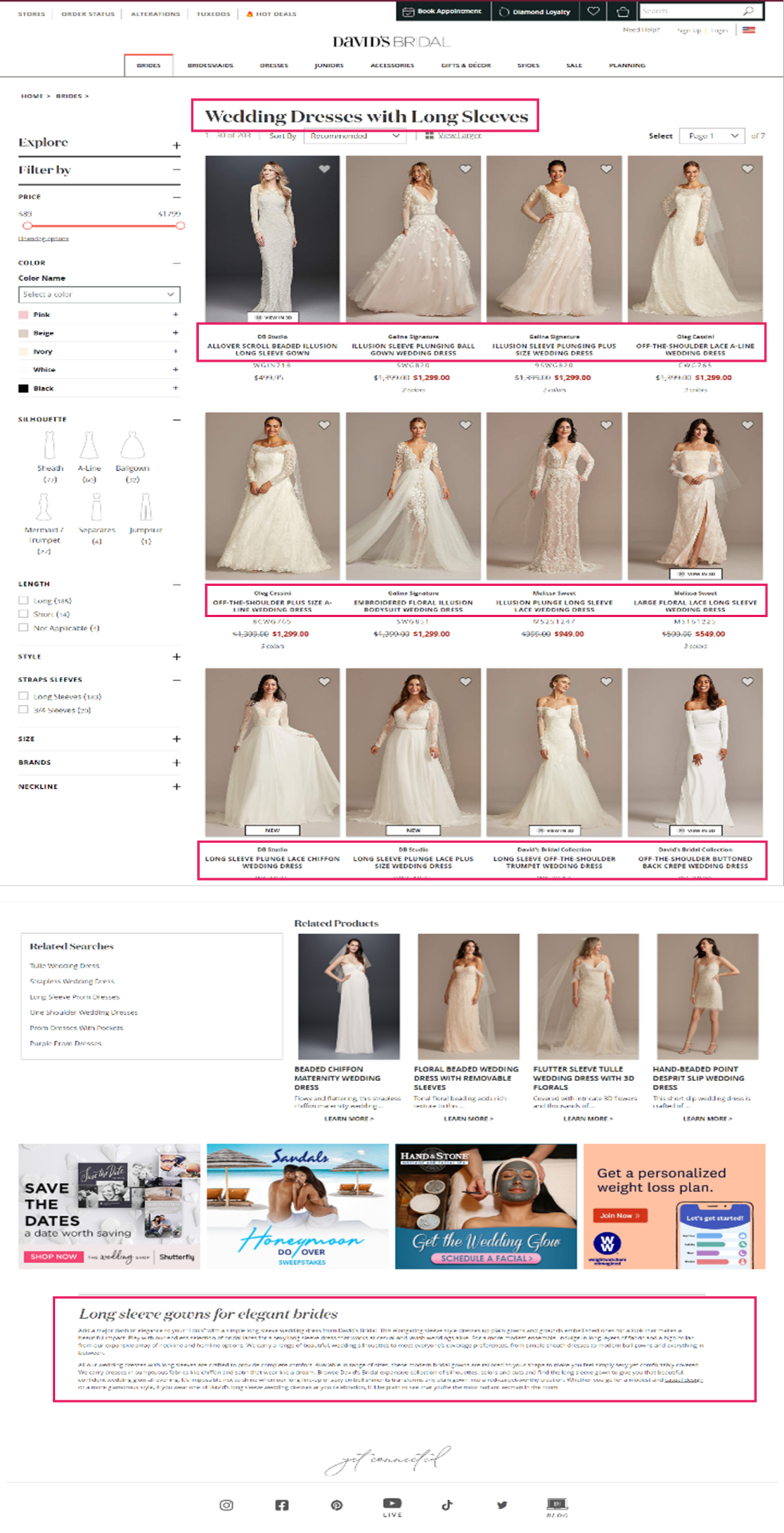
6. Provide accessibility and build page authority
Once you’ve opened up your new facet Product Listing Pages, you need to begin cultivating link equity towards them. This will ensure that they don’t exist as orphan URLs with no PageRank:
Ensure they’re referenced in your product XML sitemap.
If you have one feature per facet URL, then add them to your faceted navigation across CLP and Product Listing Page pages.
If you have two or more features per facet URL, then create a “Popular Searches” or “Related Searches” option within your CLPs.
Utilize your mega menu to showcase your new category landing pages. This will not only allow you to direct a large proportion of link equity, but it will also secure the highest click-through rate amongst your visitors.
Integrate your editorial strategy by creating engaging content with in-copy links. Think about how you can use descriptive long-tail anchor text about the Product Listing Page you want to link to rather than relying on “click here” or “see more”.
Connect to them via href links so you’re not solely relying on links from the main navigation or content hyperlinks. As this is difficult to do at scale, it can be done through modules such as “related categories”, “other subcategories”, “related products”, etc.
Devise strategic outreach campaigns that will secure quality, external backlinks to them.
Implementing this holistic and robust strategy will help you to secure exponential growth from your new commercial landing pages.
Conclusion
There is a great deal of organic opportunity that exists within your faceted navigation if you begin to leverage mid- and long-tail search terms.
Seek out the opportunity from extended keyword research and competitor analysis before deciding which variants fulfill consumer demands and deliver optimal organic sessions and onsite conversions. Configure a single faceted URL for each opportunity and open them up for crawl and indexation. Ensure PageRank is distributed to them (both internally and externally) and develop your landing page content in line with quality optimization practices. This approach will help you to avoid having crawl inefficiencies, over indexation, cannibalization, or having thin doorway pages. In turn, your website will be better suited to attract highly-targeted users and guide them down the purchase funnel.
Maximizing UX and reducing reliance on other marketing channels means that your faceted navigation can truly deliver organic ROI. We have seen this work for our clients.
0 notes
Text
Fulfill Untapped Customer Demands Through Your Faceted Navigation
Faceted navigation allows customers to narrow down search results based on specific product attributes. They typically exist on Product Listing Pages (PLPs) and are a great way to help users intuitively discover products but managing this filtering system is a common SEO challenge. Crawling and indexation need to be controlled.
However, if we look beyond their inherent functionality, facets can offer us considerable potential. By centering your secondary navigation on long-tail keyword opportunities, you’ll be able to strategically utilize consumer intent, secure additional web conversions, and boost revenue levels.
Match consumer intent with long-tail search queries
Having an established brand and a solid domain backlink profile won’t guarantee success. This is great news for smaller brands, as industry giants aren’t necessarily going to win at this game.
If we search for “long sleeve wedding dresses”, we can see how David’s Bridal’s optimized facet page (Domain Authority: 67/100, Page Authority: 47 / 100) has obtained the top ranking position, while Nordstrom’s result (Domain Authority: 87/100, Page Authority: 39/100) appears in the third position for this particular query. We’ll take a look at what makes this page so effective later.
When looking at how we can optimize faceted navigations, it’s important to recognize that product attributes convey consumer needs and aspirations. If, for example, I’m looking for a wedding dress, then I may tailor my search by the color, fabric, neckline shape, and the sleeve length.
According to the search demand curve, long-tail queries account for up to 70% of all organic searches. They are highly targeted queries that offer big traffic-driving opportunities.
In the last few years, we’ve seen a big shift in the industry towards capitalizing this intent with long-form content. Blog articles and style guides have become the go-to methods for many to capture these visitors, as we can see from the examples taken from Marks & Spencers’ "Inspire Me" section:
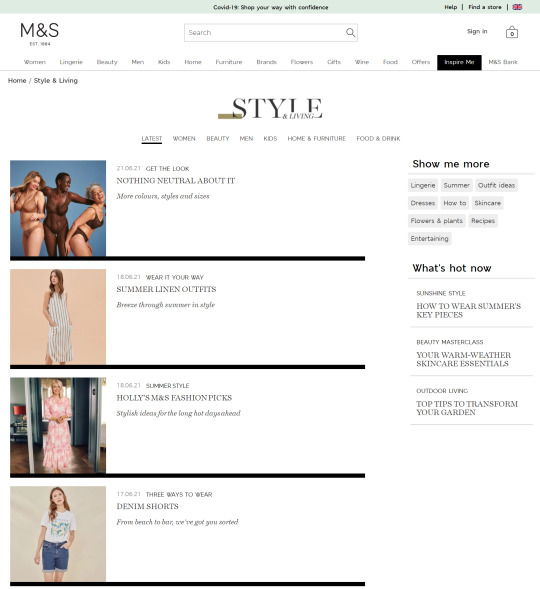
People often look for inspiration when they’re shopping, and these pages provide an effective way to add more internal links to category and product pages. But relying on this approach is one-dimensional, given that these deeper content pages tend to have lower PageRank. An extensive amount of time and effort will, therefore, be required to achieve the desired result.
In comparison, Product Listing Pages usually target broader search terms, and faceted navigations typically exist as passive functions. This is because they’re often blocked from crawlers, making them devoid of any SEO value. Waterstones (a well-known British bookstore) is one retailer that applies this rule for their on-page filters:
In this particular example, I’ve applied a filter to only show me books for 5 – 8 year olds, but the appended URL (https://bit.ly/2VccAT1) is blocked in the robots.txt file. This is going to prevent such pages from being served in the SERPs despite them having the potential to meet specific customer needs. This shows that there can be a fundamental disconnect in matching customer intent to the pages we’re providing them in the organic results.
From the diagram below, we can see how editorial content typically focuses on the “awareness” and “interest” stages, whilst Product Listing Pages tend to be more in line with the “consideration” and “purchase” phases:
Serving the right content to users throughout their buying journey is pivotal to success. For many retailers, competitors are continuing to prioritize broader, high-volume keywords in saturated markets. They’re targeting the same terms to secure a proportion of the same search traffic. This is a very challenging prospect to face, and without carving out a gap in the marketplace, they won’t necessarily deliver the results they seek to secure. Likewise, relying on informational guides to target long-tail keywords means that you’re missing a large percentage of users who have very specific buying requirements. Yes, they’re ready to make a purchase!
By shifting your focus to address your customer’s real needs and expectations, you’ll be able to deliver a satisfying, frictionless experience at every interaction and all the way through to that final purchase.
The solution
Step 1: Conduct long-tail keyword research
Build a really comprehensive view of your potential customers by harnessing data from a variety of sources, including:
a) Keyword research tools like Moz, Google Keyword Planner, and Answer The Public.
b) The SERPs — get inspiration from the auto-suggest results, People Also Ask, and the related search links at the bottom of the page.
c) Competitor activity — aside from using SEO monitoring software, you can use a data mining extension tool like Scraper, which will extract faceted options directly from competitor Product Listing Pages. These tools are often free to download and allow you to quickly transfer product categories.
d) Your Google Search Console, Analytics, and PPC accounts to determine which keywords and URLs are securing the highest number of visits and web conversions. Internal search data can also give you great consumer insights.
e) Speak to your merchandising team to understand product demands and fulfillment capabilities.
Step 2: Group into meaningful sub-topics
Once you’ve collated all this information into a spreadsheet, you’ll be able to discover long-tail, consideration-orientated keywords. While individually they may not boast huge monthly search estimates, they can collectively highlight where purchase intentions can be better fulfilled.
To help illustrate this point, we can look at a small subset of lingerie keywords and the facets the searches represent:
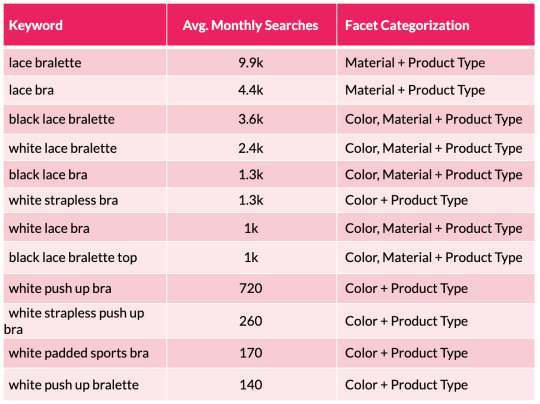
From the table above we can quickly see a pattern emerging with color and material variations appearing across the search terms. We can then substantiate this information with session and revenue estimates with the use of a recognized CTR model. This enables us to help forecast the potential organic uplift and quantify the size of the prize for a number of different scenarios that are on offer from each new facet combination. This may include estimations for securing position 10, 7, 5, 3 and 1 in Google.
One thing to note here is that it’s worth excluding synonyms, as they will falsely inflate your calculations. An example here would be to exclude “storage drawers” (22.2k monthly searchers) when reviewing the performance for “chest of drawers” (201k m/s). Including both variants will cause a false positive result and will lead you to draw incorrect conclusions.
Step 3: Dig deeper into broader terms around offers, ratings, and price
These product filters are found in the “Sort” dropdown box and, from my experience, these are set to “noindex” from the outset as they simply allow users to re-order page results. Certainly, content management systems like Shopify and Shopware have this as a default.
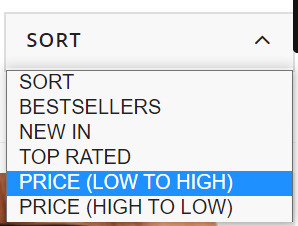
This makes sense since their purpose is to allow visitors to simply sort or narrow page content rather than offering alternative results and additional value (which is offered through faceted navigation). As such, filter typically produce duplicate results which should not be discoverable beyond the immediate moment. But this hard-and-fast rule doesn’t always apply perfectly in the real world. This is why we need to look at our individual industries and understand what’s important to our unique set of customers.
If we look at the world of gifting, we often see people shopping with a particular budget in mind. Therefore, terms like “birthday gift under £20” (40 m/s) or “Secret Santa gift under £10” (2.9k m/s) are reasonably common, and opening up relevant listing pages could be useful for shoppers.
Step 4: The technical steps
Facet taxonomies are hugely complex and the number of attributes that can be strung together increases with the size of the domain. We, therefore, need to carefully manage the flood gates and mitigate against any potential risks including crawl inefficiencies and link equity dilution.
We can do this by:
1. Avoiding thin/doorway pages by regularly re-assessing your product offering. For instance, you may consider there to be little value in creating a new listings page if you’re selling a very small range of low price point products. In this case, you may decide against opening up an additional Product Listing Page when you sell as few as 10 eligible products. However, this is not a fixed rule, so it’s quite possible that your criteria may be lower for particular product lines. Either way, these numbers will change over time. Consider seasonal trends, when new collections are launched, and when they become discontinued. Setting up a product retirement strategy to manage expired products and categories at scale in parallel with this step is also highly recommended.
2. Prevent content cannibalization by arranging selected facets according to their value and significance. “Size” is very important for some electrical goods like TVs, laptops, and cameras, but is less so for beauty accessories or vacuum cleaners. You must also make sure page content is distinctive and reflects the focus of your chosen facet(s). Refer to step 5 for more details.
3. Follow the sequence in which adjectives and facets are typically selected by your customers. This can vary depending on where your audience lives. So, whilst products generally have five or more distinguishable features, English vernacular determines that we use more than four adjectives (e.g. size + color + material + shape) to describe something.
4. Control the controllables by dealing with overlapping variations. This typically occurs when multiples co-exist and each exhibits good search metrics. For instance, it’s reasonable for someone to simultaneously look for several color and/or fabric combinations in the different ways below.

When this situation occurs, we should follow the same linguistic rules as above and choose a preferred sequence. In this case, it would be color + material + product type.
In comparison to the noindex tag suggested for on-page filters you should canonicalize unnecessary facets to their parent page (remembering that this is merely a hint and not a directive). This will enable you to control how crawlers deal with highly comparable result pages and will, therefore, help to prevent your site from being demoted in the SERPs. Dynamic search parameters should continue to be defined with a “noindex, nofollow” meta robots tag, disallowed in the robots.txt file, and configured through Google’s URL parameter tool (within your Search Console account) to tell crawlers the purpose of your parameters and how you would like them to be treated. This is a helpful guide on parameter handling for Googlebots, but bear in mind that this last tip won’t influence how Bing or Yahoo user-agents interpret these pages.
5. Open your facets in phases and cultivate it into a test-and-learn process. This will enable you to identify issues a lot sooner and implement facet-wide solutions in a timely manner. Without having to unravel these additional layers of complexity, problems such as crawl inefficiencies, PageRank dilution, or excessive indexation can be swiftly resolved.
To show you what this could look like, I’ve provided a phasing plan that was created for one of our e-commerce clients. Our research showed a significant SEO opportunity for opening up some of the facets and filters: potential +£263Kpcm for the “colour + type” facet (UK):
What’s more, when we extended our forecast to include other facet combinations, we calculated an additional revenue opportunity of up to +£207K/pcm (before filtering out combinations with no products offering).
Step 5: Optimize your facet URLs
Optimize your new facet category URLs to establish relevancy for your selected search terms. The key on-page elements to focus on include:
URL
Page title
Breadcrumb anchor texts
H tags
Content snippets (e.g. introductory text and FAQ copy)
Image ALT texts
Product names
Link out to similar facet category pages (i.e. via a “You May Also Like” feature box)
David’s Bridal is a good example of a retailer that has done this well. Looking back at the ‘Long Sleeve Wedding Dress’ Product Listing Page, we can see that they’ve curated unique content and followed fundamental optimization tactics on the landing page in a way that feels helpful to the user.
URL: davidsbridal.com/long-sleeve-wedding-dresses
Page Title: Long Sleeve Wedding Dresses & Gowns | David's Bridal
Meta Description: Do you dream of wearing a long sleeve wedding dress on your big day? Shop David's Bridal wide variety of wedding gowns with sleeves in lace & other designs!
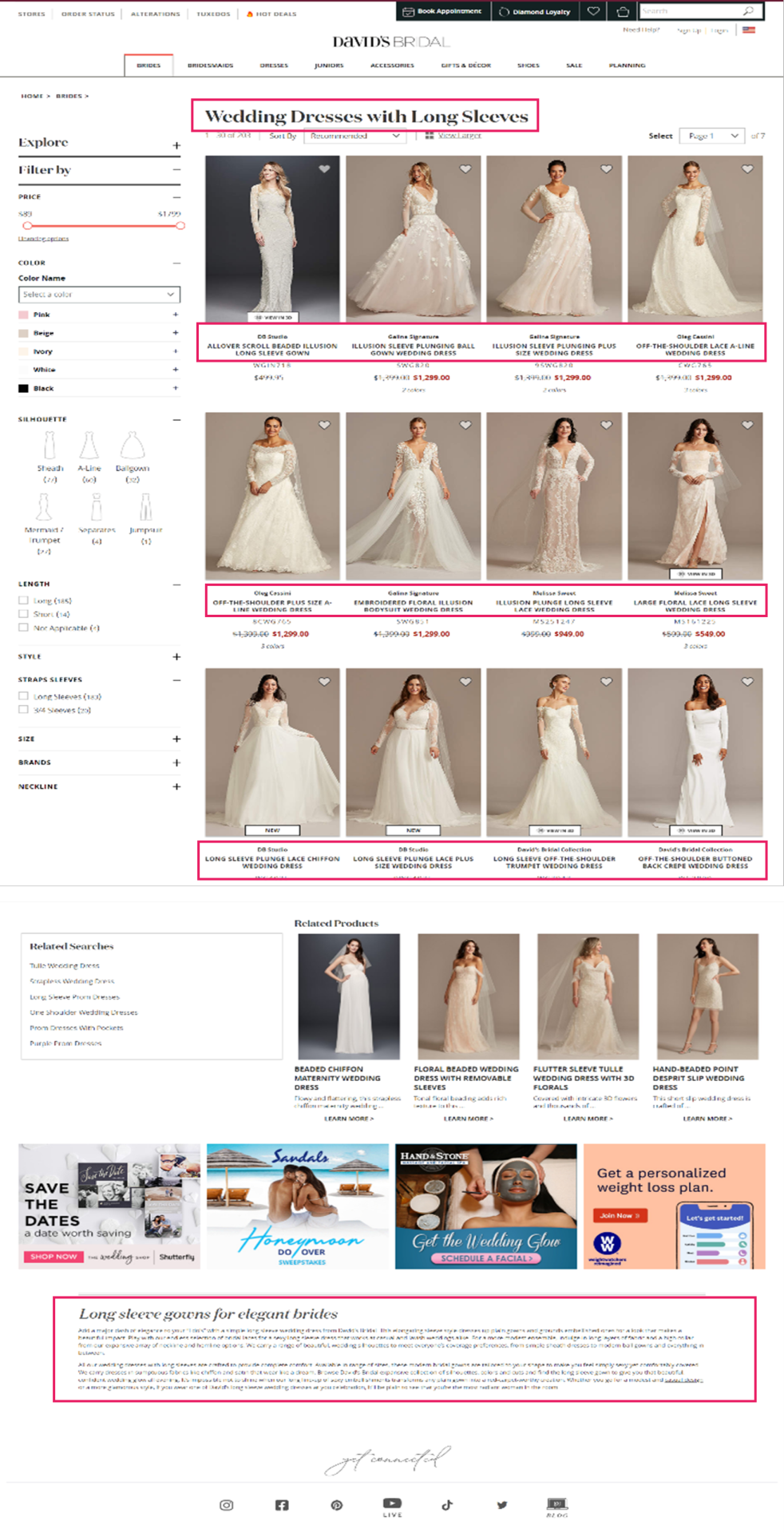
6. Provide accessibility and build page authority
Once you’ve opened up your new facet Product Listing Pages, you need to begin cultivating link equity towards them. This will ensure that they don’t exist as orphan URLs with no PageRank:
Ensure they’re referenced in your product XML sitemap.
If you have one feature per facet URL, then add them to your faceted navigation across CLP and Product Listing Page pages.
If you have two or more features per facet URL, then create a “Popular Searches” or “Related Searches” option within your CLPs.
Utilize your mega menu to showcase your new category landing pages. This will not only allow you to direct a large proportion of link equity, but it will also secure the highest click-through rate amongst your visitors.
Integrate your editorial strategy by creating engaging content with in-copy links. Think about how you can use descriptive long-tail anchor text about the Product Listing Page you want to link to rather than relying on “click here” or “see more”.
Connect to them via href links so you’re not solely relying on links from the main navigation or content hyperlinks. As this is difficult to do at scale, it can be done through modules such as “related categories”, “other subcategories”, “related products”, etc.
Devise strategic outreach campaigns that will secure quality, external backlinks to them.
Implementing this holistic and robust strategy will help you to secure exponential growth from your new commercial landing pages.
Conclusion
There is a great deal of organic opportunity that exists within your faceted navigation if you begin to leverage mid- and long-tail search terms.
Seek out the opportunity from extended keyword research and competitor analysis before deciding which variants fulfill consumer demands and deliver optimal organic sessions and onsite conversions. Configure a single faceted URL for each opportunity and open them up for crawl and indexation. Ensure PageRank is distributed to them (both internally and externally) and develop your landing page content in line with quality optimization practices. This approach will help you to avoid having crawl inefficiencies, over indexation, cannibalization, or having thin doorway pages. In turn, your website will be better suited to attract highly-targeted users and guide them down the purchase funnel.
Maximizing UX and reducing reliance on other marketing channels means that your faceted navigation can truly deliver organic ROI. We have seen this work for our clients.
0 notes
Text
Fulfill Untapped Customer Demands Through Your Faceted Navigation
Faceted navigation allows customers to narrow down search results based on specific product attributes. They typically exist on Product Listing Pages (PLPs) and are a great way to help users intuitively discover products but managing this filtering system is a common SEO challenge. Crawling and indexation need to be controlled.
However, if we look beyond their inherent functionality, facets can offer us considerable potential. By centering your secondary navigation on long-tail keyword opportunities, you’ll be able to strategically utilize consumer intent, secure additional web conversions, and boost revenue levels.
Match consumer intent with long-tail search queries
Having an established brand and a solid domain backlink profile won’t guarantee success. This is great news for smaller brands, as industry giants aren’t necessarily going to win at this game.
If we search for “long sleeve wedding dresses”, we can see how David’s Bridal’s optimized facet page (Domain Authority: 67/100, Page Authority: 47 / 100) has obtained the top ranking position, while Nordstrom’s result (Domain Authority: 87/100, Page Authority: 39/100) appears in the third position for this particular query. We’ll take a look at what makes this page so effective later.
When looking at how we can optimize faceted navigations, it’s important to recognize that product attributes convey consumer needs and aspirations. If, for example, I’m looking for a wedding dress, then I may tailor my search by the color, fabric, neckline shape, and the sleeve length.
According to the search demand curve, long-tail queries account for up to 70% of all organic searches. They are highly targeted queries that offer big traffic-driving opportunities.
In the last few years, we’ve seen a big shift in the industry towards capitalizing this intent with long-form content. Blog articles and style guides have become the go-to methods for many to capture these visitors, as we can see from the examples taken from Marks & Spencers’ "Inspire Me" section:
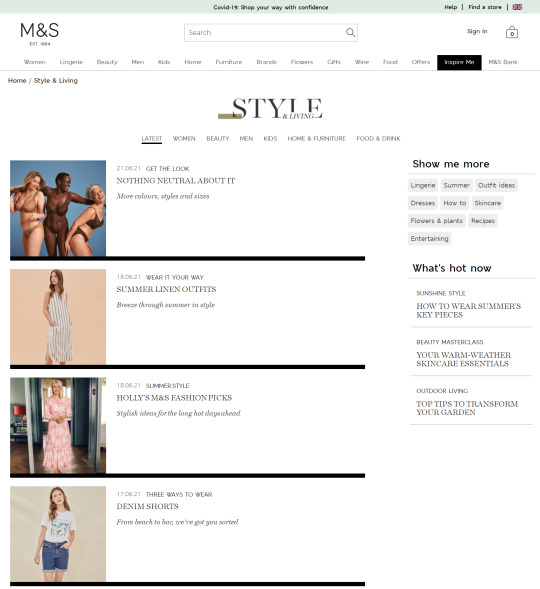
People often look for inspiration when they’re shopping, and these pages provide an effective way to add more internal links to category and product pages. But relying on this approach is one-dimensional, given that these deeper content pages tend to have lower PageRank. An extensive amount of time and effort will, therefore, be required to achieve the desired result.
In comparison, Product Listing Pages usually target broader search terms, and faceted navigations typically exist as passive functions. This is because they’re often blocked from crawlers, making them devoid of any SEO value. Waterstones (a well-known British bookstore) is one retailer that applies this rule for their on-page filters:
In this particular example, I’ve applied a filter to only show me books for 5 – 8 year olds, but the appended URL (https://ift.tt/3xrpOJS) is blocked in the robots.txt file. This is going to prevent such pages from being served in the SERPs despite them having the potential to meet specific customer needs. This shows that there can be a fundamental disconnect in matching customer intent to the pages we’re providing them in the organic results.
From the diagram below, we can see how editorial content typically focuses on the “awareness” and “interest” stages, whilst Product Listing Pages tend to be more in line with the “consideration” and “purchase” phases:
Serving the right content to users throughout their buying journey is pivotal to success. For many retailers, competitors are continuing to prioritize broader, high-volume keywords in saturated markets. They’re targeting the same terms to secure a proportion of the same search traffic. This is a very challenging prospect to face, and without carving out a gap in the marketplace, they won’t necessarily deliver the results they seek to secure. Likewise, relying on informational guides to target long-tail keywords means that you’re missing a large percentage of users who have very specific buying requirements. Yes, they’re ready to make a purchase!
By shifting your focus to address your customer’s real needs and expectations, you’ll be able to deliver a satisfying, frictionless experience at every interaction and all the way through to that final purchase.
The solution
Step 1: Conduct long-tail keyword research
Build a really comprehensive view of your potential customers by harnessing data from a variety of sources, including:
a) Keyword research tools like Moz, Google Keyword Planner, and Answer The Public.
b) The SERPs — get inspiration from the auto-suggest results, People Also Ask, and the related search links at the bottom of the page.
c) Competitor activity — aside from using SEO monitoring software, you can use a data mining extension tool like Scraper, which will extract faceted options directly from competitor Product Listing Pages. These tools are often free to download and allow you to quickly transfer product categories.
d) Your Google Search Console, Analytics, and PPC accounts to determine which keywords and URLs are securing the highest number of visits and web conversions. Internal search data can also give you great consumer insights.
e) Speak to your merchandising team to understand product demands and fulfillment capabilities.
Step 2: Group into meaningful sub-topics
Once you’ve collated all this information into a spreadsheet, you’ll be able to discover long-tail, consideration-orientated keywords. While individually they may not boast huge monthly search estimates, they can collectively highlight where purchase intentions can be better fulfilled.
To help illustrate this point, we can look at a small subset of lingerie keywords and the facets the searches represent:
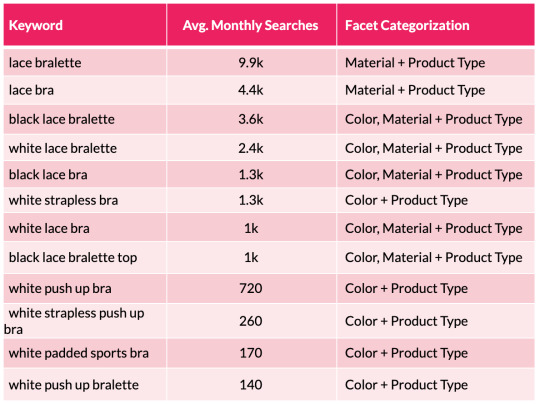
From the table above we can quickly see a pattern emerging with color and material variations appearing across the search terms. We can then substantiate this information with session and revenue estimates with the use of a recognized CTR model. This enables us to help forecast the potential organic uplift and quantify the size of the prize for a number of different scenarios that are on offer from each new facet combination. This may include estimations for securing position 10, 7, 5, 3 and 1 in Google.
One thing to note here is that it’s worth excluding synonyms, as they will falsely inflate your calculations. An example here would be to exclude “storage drawers” (22.2k monthly searchers) when reviewing the performance for “chest of drawers” (201k m/s). Including both variants will cause a false positive result and will lead you to draw incorrect conclusions.
Step 3: Dig deeper into broader terms around offers, ratings, and price
These product filters are found in the “Sort” dropdown box and, from my experience, these are set to “noindex” from the outset as they simply allow users to re-order page results. Certainly, content management systems like Shopify and Shopware have this as a default.
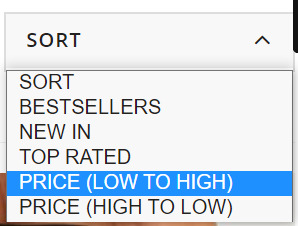
This makes sense since their purpose is to allow visitors to simply sort or narrow page content rather than offering alternative results and additional value (which is offered through faceted navigation). As such, filter typically produce duplicate results which should not be discoverable beyond the immediate moment. But this hard-and-fast rule doesn’t always apply perfectly in the real world. This is why we need to look at our individual industries and understand what’s important to our unique set of customers.
If we look at the world of gifting, we often see people shopping with a particular budget in mind. Therefore, terms like “birthday gift under £20” (40 m/s) or “Secret Santa gift under £10” (2.9k m/s) are reasonably common, and opening up relevant listing pages could be useful for shoppers.
Step 4: The technical steps
Facet taxonomies are hugely complex and the number of attributes that can be strung together increases with the size of the domain. We, therefore, need to carefully manage the flood gates and mitigate against any potential risks including crawl inefficiencies and link equity dilution.
We can do this by:
1. Avoiding thin/doorway pages by regularly re-assessing your product offering. For instance, you may consider there to be little value in creating a new listings page if you’re selling a very small range of low price point products. In this case, you may decide against opening up an additional Product Listing Page when you sell as few as 10 eligible products. However, this is not a fixed rule, so it’s quite possible that your criteria may be lower for particular product lines. Either way, these numbers will change over time. Consider seasonal trends, when new collections are launched, and when they become discontinued. Setting up a product retirement strategy to manage expired products and categories at scale in parallel with this step is also highly recommended.
2. Prevent content cannibalization by arranging selected facets according to their value and significance. “Size” is very important for some electrical goods like TVs, laptops, and cameras, but is less so for beauty accessories or vacuum cleaners. You must also make sure page content is distinctive and reflects the focus of your chosen facet(s). Refer to step 5 for more details.
3. Follow the sequence in which adjectives and facets are typically selected by your customers. This can vary depending on where your audience lives. So, whilst products generally have five or more distinguishable features, English vernacular determines that we use more than four adjectives (e.g. size + color + material + shape) to describe something.
4. Control the controllables by dealing with overlapping variations. This typically occurs when multiples co-exist and each exhibits good search metrics. For instance, it’s reasonable for someone to simultaneously look for several color and/or fabric combinations in the different ways below.
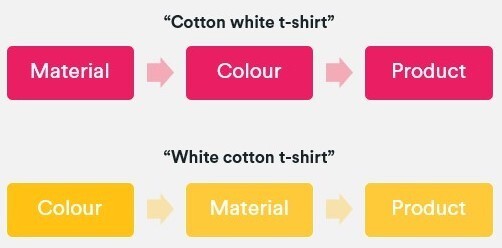
When this situation occurs, we should follow the same linguistic rules as above and choose a preferred sequence. In this case, it would be color + material + product type.
In comparison to the noindex tag suggested for on-page filters you should canonicalize unnecessary facets to their parent page (remembering that this is merely a hint and not a directive). This will enable you to control how crawlers deal with highly comparable result pages and will, therefore, help to prevent your site from being demoted in the SERPs. Dynamic search parameters should continue to be defined with a “noindex, nofollow” meta robots tag, disallowed in the robots.txt file, and configured through Google’s URL parameter tool (within your Search Console account) to tell crawlers the purpose of your parameters and how you would like them to be treated. This is a helpful guide on parameter handling for Googlebots, but bear in mind that this last tip won’t influence how Bing or Yahoo user-agents interpret these pages.
5. Open your facets in phases and cultivate it into a test-and-learn process. This will enable you to identify issues a lot sooner and implement facet-wide solutions in a timely manner. Without having to unravel these additional layers of complexity, problems such as crawl inefficiencies, PageRank dilution, or excessive indexation can be swiftly resolved.
To show you what this could look like, I’ve provided a phasing plan that was created for one of our e-commerce clients. Our research showed a significant SEO opportunity for opening up some of the facets and filters: potential +£263Kpcm for the “colour + type” facet (UK):
What’s more, when we extended our forecast to include other facet combinations, we calculated an additional revenue opportunity of up to +£207K/pcm (before filtering out combinations with no products offering).
Step 5: Optimize your facet URLs
Optimize your new facet category URLs to establish relevancy for your selected search terms. The key on-page elements to focus on include:
URL
Page title
Breadcrumb anchor texts
H tags
Content snippets (e.g. introductory text and FAQ copy)
Image ALT texts
Product names
Link out to similar facet category pages (i.e. via a “You May Also Like” feature box)
David’s Bridal is a good example of a retailer that has done this well. Looking back at the ‘Long Sleeve Wedding Dress’ Product Listing Page, we can see that they’ve curated unique content and followed fundamental optimization tactics on the landing page in a way that feels helpful to the user.
URL: davidsbridal.com/long-sleeve-wedding-dresses
Page Title: Long Sleeve Wedding Dresses & Gowns | David's Bridal
Meta Description: Do you dream of wearing a long sleeve wedding dress on your big day? Shop David's Bridal wide variety of wedding gowns with sleeves in lace & other designs!
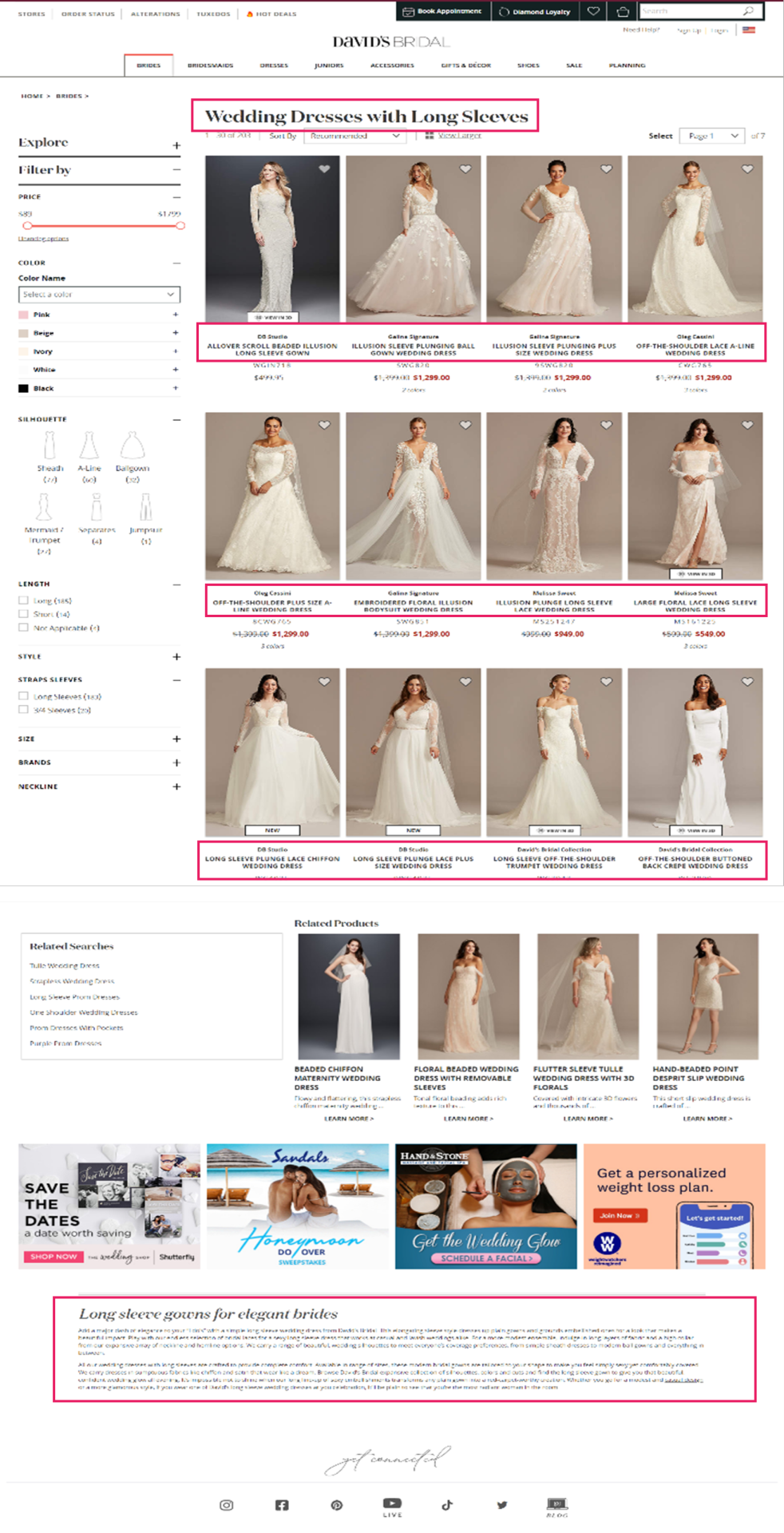
6. Provide accessibility and build page authority
Once you’ve opened up your new facet Product Listing Pages, you need to begin cultivating link equity towards them. This will ensure that they don’t exist as orphan URLs with no PageRank:
Ensure they’re referenced in your product XML sitemap.
If you have one feature per facet URL, then add them to your faceted navigation across CLP and Product Listing Page pages.
If you have two or more features per facet URL, then create a “Popular Searches” or “Related Searches” option within your CLPs.
Utilize your mega menu to showcase your new category landing pages. This will not only allow you to direct a large proportion of link equity, but it will also secure the highest click-through rate amongst your visitors.
Integrate your editorial strategy by creating engaging content with in-copy links. Think about how you can use descriptive long-tail anchor text about the Product Listing Page you want to link to rather than relying on “click here” or “see more”.
Connect to them via href links so you’re not solely relying on links from the main navigation or content hyperlinks. As this is difficult to do at scale, it can be done through modules such as “related categories”, “other subcategories”, “related products”, etc.
Devise strategic outreach campaigns that will secure quality, external backlinks to them.
Implementing this holistic and robust strategy will help you to secure exponential growth from your new commercial landing pages.
Conclusion
There is a great deal of organic opportunity that exists within your faceted navigation if you begin to leverage mid- and long-tail search terms.
Seek out the opportunity from extended keyword research and competitor analysis before deciding which variants fulfill consumer demands and deliver optimal organic sessions and onsite conversions. Configure a single faceted URL for each opportunity and open them up for crawl and indexation. Ensure PageRank is distributed to them (both internally and externally) and develop your landing page content in line with quality optimization practices. This approach will help you to avoid having crawl inefficiencies, over indexation, cannibalization, or having thin doorway pages. In turn, your website will be better suited to attract highly-targeted users and guide them down the purchase funnel.
Maximizing UX and reducing reliance on other marketing channels means that your faceted navigation can truly deliver organic ROI. We have seen this work for our clients.
0 notes
Text
Fulfill Untapped Customer Demands Through Your Faceted Navigation
Faceted navigation allows customers to narrow down search results based on specific product attributes. They typically exist on Product Listing Pages (PLPs) and are a great way to help users intuitively discover products but managing this filtering system is a common SEO challenge. Crawling and indexation need to be controlled.
However, if we look beyond their inherent functionality, facets can offer us considerable potential. By centering your secondary navigation on long-tail keyword opportunities, you’ll be able to strategically utilize consumer intent, secure additional web conversions, and boost revenue levels.
Match consumer intent with long-tail search queries
Having an established brand and a solid domain backlink profile won’t guarantee success. This is great news for smaller brands, as industry giants aren’t necessarily going to win at this game.
If we search for “long sleeve wedding dresses”, we can see how David’s Bridal’s optimized facet page (Domain Authority: 67/100, Page Authority: 47 / 100) has obtained the top ranking position, while Nordstrom’s result (Domain Authority: 87/100, Page Authority: 39/100) appears in the third position for this particular query. We’ll take a look at what makes this page so effective later.
When looking at how we can optimize faceted navigations, it’s important to recognize that product attributes convey consumer needs and aspirations. If, for example, I’m looking for a wedding dress, then I may tailor my search by the color, fabric, neckline shape, and the sleeve length.
According to the search demand curve, long-tail queries account for up to 70% of all organic searches. They are highly targeted queries that offer big traffic-driving opportunities.
In the last few years, we’ve seen a big shift in the industry towards capitalizing this intent with long-form content. Blog articles and style guides have become the go-to methods for many to capture these visitors, as we can see from the examples taken from Marks & Spencers’ "Inspire Me" section:
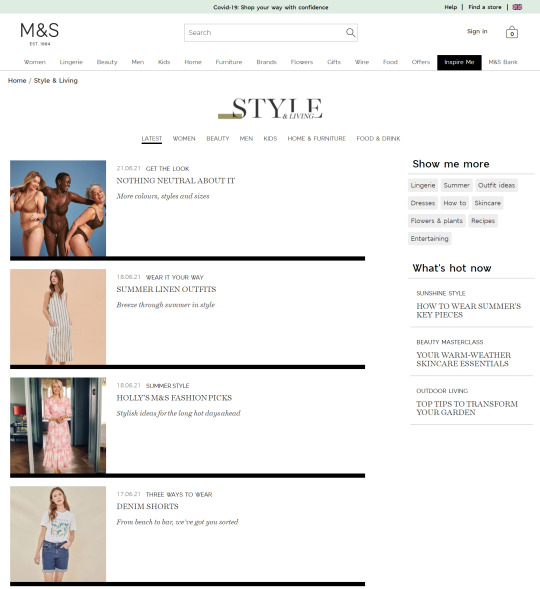
People often look for inspiration when they’re shopping, and these pages provide an effective way to add more internal links to category and product pages. But relying on this approach is one-dimensional, given that these deeper content pages tend to have lower PageRank. An extensive amount of time and effort will, therefore, be required to achieve the desired result.
In comparison, Product Listing Pages usually target broader search terms, and faceted navigations typically exist as passive functions. This is because they’re often blocked from crawlers, making them devoid of any SEO value. Waterstones (a well-known British bookstore) is one retailer that applies this rule for their on-page filters:
In this particular example, I’ve applied a filter to only show me books for 5 – 8 year olds, but the appended URL (https://ift.tt/3xrpOJS) is blocked in the robots.txt file. This is going to prevent such pages from being served in the SERPs despite them having the potential to meet specific customer needs. This shows that there can be a fundamental disconnect in matching customer intent to the pages we’re providing them in the organic results.
From the diagram below, we can see how editorial content typically focuses on the “awareness” and “interest” stages, whilst Product Listing Pages tend to be more in line with the “consideration” and “purchase” phases:
Serving the right content to users throughout their buying journey is pivotal to success. For many retailers, competitors are continuing to prioritize broader, high-volume keywords in saturated markets. They’re targeting the same terms to secure a proportion of the same search traffic. This is a very challenging prospect to face, and without carving out a gap in the marketplace, they won’t necessarily deliver the results they seek to secure. Likewise, relying on informational guides to target long-tail keywords means that you’re missing a large percentage of users who have very specific buying requirements. Yes, they’re ready to make a purchase!
By shifting your focus to address your customer’s real needs and expectations, you’ll be able to deliver a satisfying, frictionless experience at every interaction and all the way through to that final purchase.
The solution
Step 1: Conduct long-tail keyword research
Build a really comprehensive view of your potential customers by harnessing data from a variety of sources, including:
a) Keyword research tools like Moz, Google Keyword Planner, and Answer The Public.
b) The SERPs — get inspiration from the auto-suggest results, People Also Ask, and the related search links at the bottom of the page.
c) Competitor activity — aside from using SEO monitoring software, you can use a data mining extension tool like Scraper, which will extract faceted options directly from competitor Product Listing Pages. These tools are often free to download and allow you to quickly transfer product categories.
d) Your Google Search Console, Analytics, and PPC accounts to determine which keywords and URLs are securing the highest number of visits and web conversions. Internal search data can also give you great consumer insights.
e) Speak to your merchandising team to understand product demands and fulfillment capabilities.
Step 2: Group into meaningful sub-topics
Once you’ve collated all this information into a spreadsheet, you’ll be able to discover long-tail, consideration-orientated keywords. While individually they may not boast huge monthly search estimates, they can collectively highlight where purchase intentions can be better fulfilled.
To help illustrate this point, we can look at a small subset of lingerie keywords and the facets the searches represent:
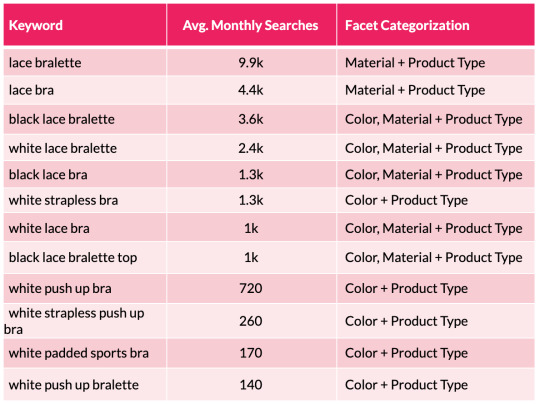
From the table above we can quickly see a pattern emerging with color and material variations appearing across the search terms. We can then substantiate this information with session and revenue estimates with the use of a recognized CTR model. This enables us to help forecast the potential organic uplift and quantify the size of the prize for a number of different scenarios that are on offer from each new facet combination. This may include estimations for securing position 10, 7, 5, 3 and 1 in Google.
One thing to note here is that it’s worth excluding synonyms, as they will falsely inflate your calculations. An example here would be to exclude “storage drawers” (22.2k monthly searchers) when reviewing the performance for “chest of drawers” (201k m/s). Including both variants will cause a false positive result and will lead you to draw incorrect conclusions.
Step 3: Dig deeper into broader terms around offers, ratings, and price
These product filters are found in the “Sort” dropdown box and, from my experience, these are set to “noindex” from the outset as they simply allow users to re-order page results. Certainly, content management systems like Shopify and Shopware have this as a default.
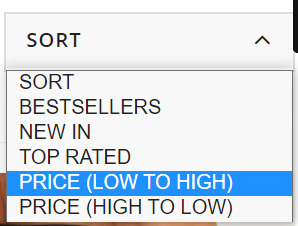
This makes sense since their purpose is to allow visitors to simply sort or narrow page content rather than offering alternative results and additional value (which is offered through faceted navigation). As such, filter typically produce duplicate results which should not be discoverable beyond the immediate moment. But this hard-and-fast rule doesn’t always apply perfectly in the real world. This is why we need to look at our individual industries and understand what’s important to our unique set of customers.
If we look at the world of gifting, we often see people shopping with a particular budget in mind. Therefore, terms like “birthday gift under £20” (40 m/s) or “Secret Santa gift under £10” (2.9k m/s) are reasonably common, and opening up relevant listing pages could be useful for shoppers.
Step 4: The technical steps
Facet taxonomies are hugely complex and the number of attributes that can be strung together increases with the size of the domain. We, therefore, need to carefully manage the flood gates and mitigate against any potential risks including crawl inefficiencies and link equity dilution.
We can do this by:
1. Avoiding thin/doorway pages by regularly re-assessing your product offering. For instance, you may consider there to be little value in creating a new listings page if you’re selling a very small range of low price point products. In this case, you may decide against opening up an additional Product Listing Page when you sell as few as 10 eligible products. However, this is not a fixed rule, so it’s quite possible that your criteria may be lower for particular product lines. Either way, these numbers will change over time. Consider seasonal trends, when new collections are launched, and when they become discontinued. Setting up a product retirement strategy to manage expired products and categories at scale in parallel with this step is also highly recommended.
2. Prevent content cannibalization by arranging selected facets according to their value and significance. “Size” is very important for some electrical goods like TVs, laptops, and cameras, but is less so for beauty accessories or vacuum cleaners. You must also make sure page content is distinctive and reflects the focus of your chosen facet(s). Refer to step 5 for more details.
3. Follow the sequence in which adjectives and facets are typically selected by your customers. This can vary depending on where your audience lives. So, whilst products generally have five or more distinguishable features, English vernacular determines that we use more than four adjectives (e.g. size + color + material + shape) to describe something.
4. Control the controllables by dealing with overlapping variations. This typically occurs when multiples co-exist and each exhibits good search metrics. For instance, it’s reasonable for someone to simultaneously look for several color and/or fabric combinations in the different ways below.
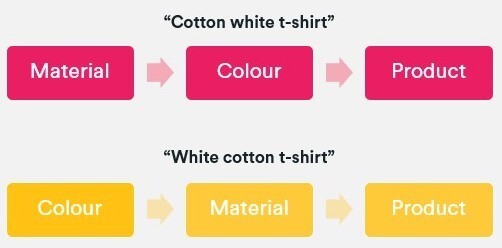
When this situation occurs, we should follow the same linguistic rules as above and choose a preferred sequence. In this case, it would be color + material + product type.
In comparison to the noindex tag suggested for on-page filters you should canonicalize unnecessary facets to their parent page (remembering that this is merely a hint and not a directive). This will enable you to control how crawlers deal with highly comparable result pages and will, therefore, help to prevent your site from being demoted in the SERPs. Dynamic search parameters should continue to be defined with a “noindex, nofollow” meta robots tag, disallowed in the robots.txt file, and configured through Google’s URL parameter tool (within your Search Console account) to tell crawlers the purpose of your parameters and how you would like them to be treated. This is a helpful guide on parameter handling for Googlebots, but bear in mind that this last tip won’t influence how Bing or Yahoo user-agents interpret these pages.
5. Open your facets in phases and cultivate it into a test-and-learn process. This will enable you to identify issues a lot sooner and implement facet-wide solutions in a timely manner. Without having to unravel these additional layers of complexity, problems such as crawl inefficiencies, PageRank dilution, or excessive indexation can be swiftly resolved.
To show you what this could look like, I’ve provided a phasing plan that was created for one of our e-commerce clients. Our research showed a significant SEO opportunity for opening up some of the facets and filters: potential +£263Kpcm for the “colour + type” facet (UK):
What’s more, when we extended our forecast to include other facet combinations, we calculated an additional revenue opportunity of up to +£207K/pcm (before filtering out combinations with no products offering).
Step 5: Optimize your facet URLs
Optimize your new facet category URLs to establish relevancy for your selected search terms. The key on-page elements to focus on include:
URL
Page title
Breadcrumb anchor texts
H tags
Content snippets (e.g. introductory text and FAQ copy)
Image ALT texts
Product names
Link out to similar facet category pages (i.e. via a “You May Also Like” feature box)
David’s Bridal is a good example of a retailer that has done this well. Looking back at the ‘Long Sleeve Wedding Dress’ Product Listing Page, we can see that they’ve curated unique content and followed fundamental optimization tactics on the landing page in a way that feels helpful to the user.
URL: davidsbridal.com/long-sleeve-wedding-dresses
Page Title: Long Sleeve Wedding Dresses & Gowns | David's Bridal
Meta Description: Do you dream of wearing a long sleeve wedding dress on your big day? Shop David's Bridal wide variety of wedding gowns with sleeves in lace & other designs!
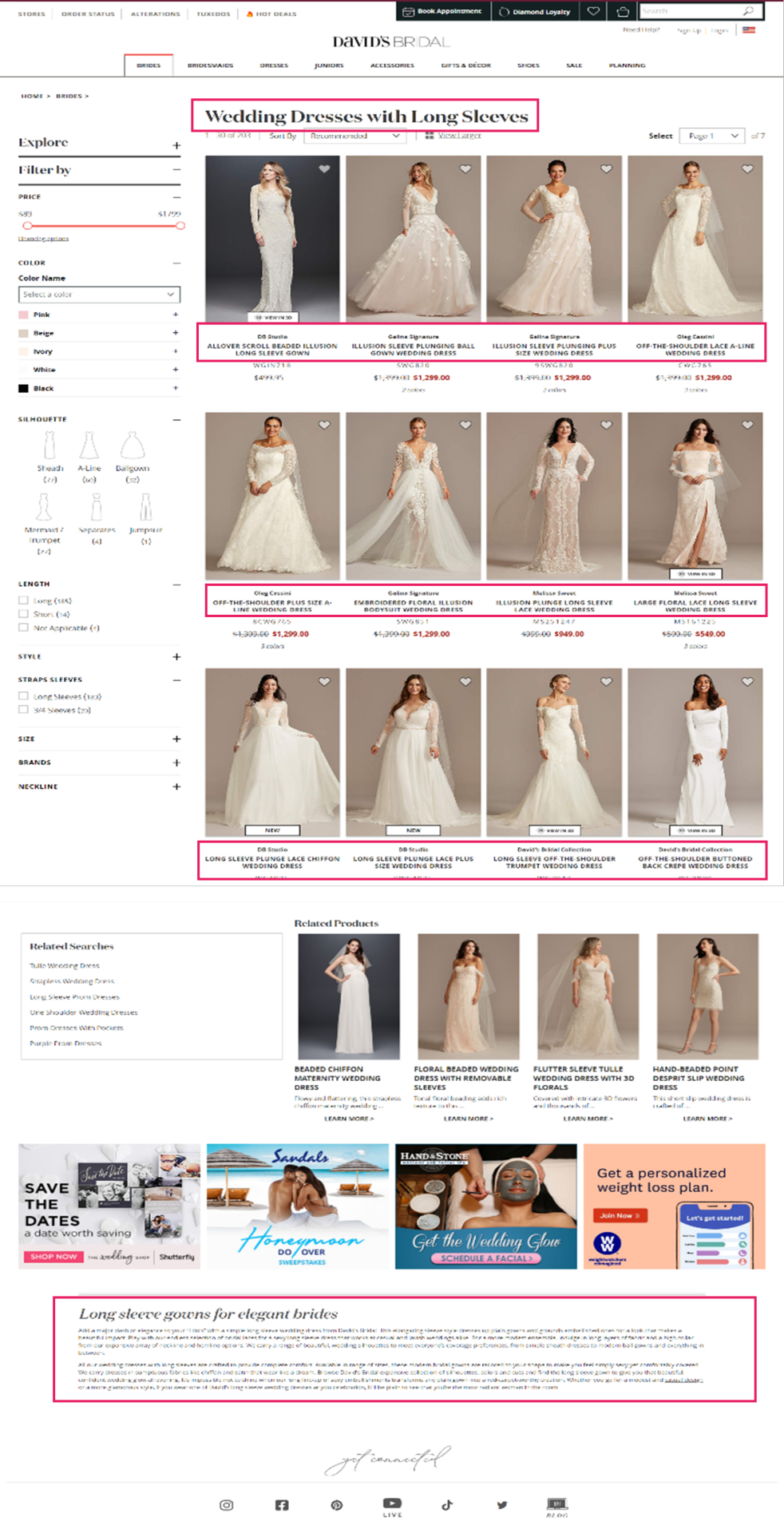
6. Provide accessibility and build page authority
Once you’ve opened up your new facet Product Listing Pages, you need to begin cultivating link equity towards them. This will ensure that they don’t exist as orphan URLs with no PageRank:
Ensure they’re referenced in your product XML sitemap.
If you have one feature per facet URL, then add them to your faceted navigation across CLP and Product Listing Page pages.
If you have two or more features per facet URL, then create a “Popular Searches” or “Related Searches” option within your CLPs.
Utilize your mega menu to showcase your new category landing pages. This will not only allow you to direct a large proportion of link equity, but it will also secure the highest click-through rate amongst your visitors.
Integrate your editorial strategy by creating engaging content with in-copy links. Think about how you can use descriptive long-tail anchor text about the Product Listing Page you want to link to rather than relying on “click here” or “see more”.
Connect to them via href links so you’re not solely relying on links from the main navigation or content hyperlinks. As this is difficult to do at scale, it can be done through modules such as “related categories”, “other subcategories”, “related products”, etc.
Devise strategic outreach campaigns that will secure quality, external backlinks to them.
Implementing this holistic and robust strategy will help you to secure exponential growth from your new commercial landing pages.
Conclusion
There is a great deal of organic opportunity that exists within your faceted navigation if you begin to leverage mid- and long-tail search terms.
Seek out the opportunity from extended keyword research and competitor analysis before deciding which variants fulfill consumer demands and deliver optimal organic sessions and onsite conversions. Configure a single faceted URL for each opportunity and open them up for crawl and indexation. Ensure PageRank is distributed to them (both internally and externally) and develop your landing page content in line with quality optimization practices. This approach will help you to avoid having crawl inefficiencies, over indexation, cannibalization, or having thin doorway pages. In turn, your website will be better suited to attract highly-targeted users and guide them down the purchase funnel.
Maximizing UX and reducing reliance on other marketing channels means that your faceted navigation can truly deliver organic ROI. We have seen this work for our clients.
0 notes
Text
Fulfill Untapped Customer Demands Through Your Faceted Navigation
Faceted navigation allows customers to narrow down search results based on specific product attributes. They typically exist on Product Listing Pages (PLPs) and are a great way to help users intuitively discover products but managing this filtering system is a common SEO challenge. Crawling and indexation need to be controlled.
However, if we look beyond their inherent functionality, facets can offer us considerable potential. By centering your secondary navigation on long-tail keyword opportunities, you’ll be able to strategically utilize consumer intent, secure additional web conversions, and boost revenue levels.
Match consumer intent with long-tail search queries
Having an established brand and a solid domain backlink profile won’t guarantee success. This is great news for smaller brands, as industry giants aren’t necessarily going to win at this game.
If we search for “long sleeve wedding dresses”, we can see how David’s Bridal’s optimized facet page (Domain Authority: 67/100, Page Authority: 47 / 100) has obtained the top ranking position, while Nordstrom’s result (Domain Authority: 87/100, Page Authority: 39/100) appears in the third position for this particular query. We’ll take a look at what makes this page so effective later.
When looking at how we can optimize faceted navigations, it’s important to recognize that product attributes convey consumer needs and aspirations. If, for example, I’m looking for a wedding dress, then I may tailor my search by the color, fabric, neckline shape, and the sleeve length.
According to the search demand curve, long-tail queries account for up to 70% of all organic searches. They are highly targeted queries that offer big traffic-driving opportunities.
In the last few years, we’ve seen a big shift in the industry towards capitalizing this intent with long-form content. Blog articles and style guides have become the go-to methods for many to capture these visitors, as we can see from the examples taken from Marks & Spencers’ "Inspire Me" section:
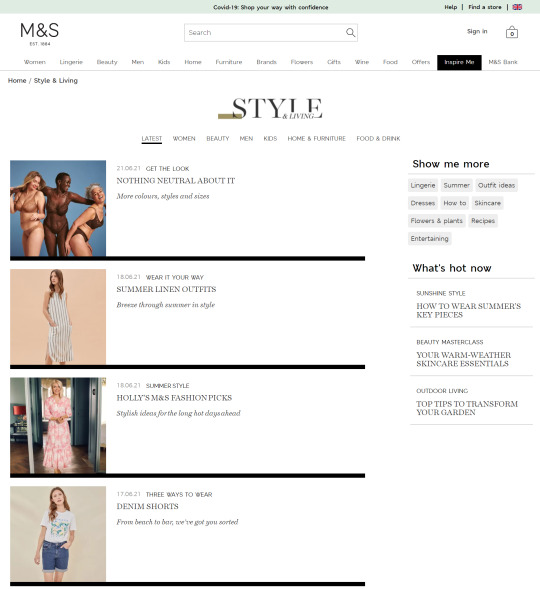
People often look for inspiration when they’re shopping, and these pages provide an effective way to add more internal links to category and product pages. But relying on this approach is one-dimensional, given that these deeper content pages tend to have lower PageRank. An extensive amount of time and effort will, therefore, be required to achieve the desired result.
In comparison, Product Listing Pages usually target broader search terms, and faceted navigations typically exist as passive functions. This is because they’re often blocked from crawlers, making them devoid of any SEO value. Waterstones (a well-known British bookstore) is one retailer that applies this rule for their on-page filters:
In this particular example, I’ve applied a filter to only show me books for 5 – 8 year olds, but the appended URL (https://ift.tt/3xrpOJS) is blocked in the robots.txt file. This is going to prevent such pages from being served in the SERPs despite them having the potential to meet specific customer needs. This shows that there can be a fundamental disconnect in matching customer intent to the pages we’re providing them in the organic results.
From the diagram below, we can see how editorial content typically focuses on the “awareness” and “interest” stages, whilst Product Listing Pages tend to be more in line with the “consideration” and “purchase” phases:
Serving the right content to users throughout their buying journey is pivotal to success. For many retailers, competitors are continuing to prioritize broader, high-volume keywords in saturated markets. They’re targeting the same terms to secure a proportion of the same search traffic. This is a very challenging prospect to face, and without carving out a gap in the marketplace, they won’t necessarily deliver the results they seek to secure. Likewise, relying on informational guides to target long-tail keywords means that you’re missing a large percentage of users who have very specific buying requirements. Yes, they’re ready to make a purchase!
By shifting your focus to address your customer’s real needs and expectations, you’ll be able to deliver a satisfying, frictionless experience at every interaction and all the way through to that final purchase.
The solution
Step 1: Conduct long-tail keyword research
Build a really comprehensive view of your potential customers by harnessing data from a variety of sources, including:
a) Keyword research tools like Moz, Google Keyword Planner, and Answer The Public.
b) The SERPs — get inspiration from the auto-suggest results, People Also Ask, and the related search links at the bottom of the page.
c) Competitor activity — aside from using SEO monitoring software, you can use a data mining extension tool like Scraper, which will extract faceted options directly from competitor Product Listing Pages. These tools are often free to download and allow you to quickly transfer product categories.
d) Your Google Search Console, Analytics, and PPC accounts to determine which keywords and URLs are securing the highest number of visits and web conversions. Internal search data can also give you great consumer insights.
e) Speak to your merchandising team to understand product demands and fulfillment capabilities.
Step 2: Group into meaningful sub-topics
Once you’ve collated all this information into a spreadsheet, you’ll be able to discover long-tail, consideration-orientated keywords. While individually they may not boast huge monthly search estimates, they can collectively highlight where purchase intentions can be better fulfilled.
To help illustrate this point, we can look at a small subset of lingerie keywords and the facets the searches represent:
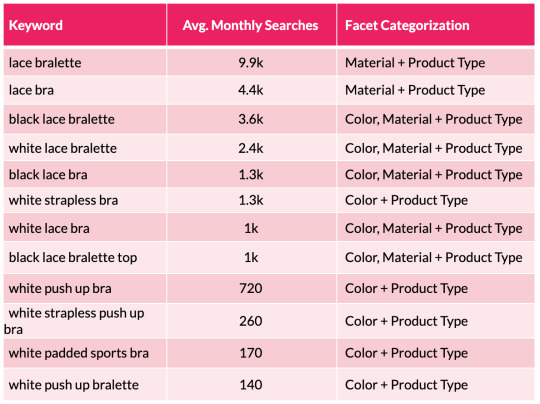
From the table above we can quickly see a pattern emerging with color and material variations appearing across the search terms. We can then substantiate this information with session and revenue estimates with the use of a recognized CTR model. This enables us to help forecast the potential organic uplift and quantify the size of the prize for a number of different scenarios that are on offer from each new facet combination. This may include estimations for securing position 10, 7, 5, 3 and 1 in Google.
One thing to note here is that it’s worth excluding synonyms, as they will falsely inflate your calculations. An example here would be to exclude “storage drawers” (22.2k monthly searchers) when reviewing the performance for “chest of drawers” (201k m/s). Including both variants will cause a false positive result and will lead you to draw incorrect conclusions.
Step 3: Dig deeper into broader terms around offers, ratings, and price
These product filters are found in the “Sort” dropdown box and, from my experience, these are set to “noindex” from the outset as they simply allow users to re-order page results. Certainly, content management systems like Shopify and Shopware have this as a default.
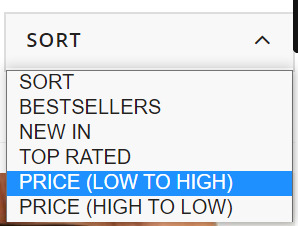
This makes sense since their purpose is to allow visitors to simply sort or narrow page content rather than offering alternative results and additional value (which is offered through faceted navigation). As such, filter typically produce duplicate results which should not be discoverable beyond the immediate moment. But this hard-and-fast rule doesn’t always apply perfectly in the real world. This is why we need to look at our individual industries and understand what’s important to our unique set of customers.
If we look at the world of gifting, we often see people shopping with a particular budget in mind. Therefore, terms like “birthday gift under £20” (40 m/s) or “Secret Santa gift under £10” (2.9k m/s) are reasonably common, and opening up relevant listing pages could be useful for shoppers.
Step 4: The technical steps
Facet taxonomies are hugely complex and the number of attributes that can be strung together increases with the size of the domain. We, therefore, need to carefully manage the flood gates and mitigate against any potential risks including crawl inefficiencies and link equity dilution.
We can do this by:
1. Avoiding thin/doorway pages by regularly re-assessing your product offering. For instance, you may consider there to be little value in creating a new listings page if you’re selling a very small range of low price point products. In this case, you may decide against opening up an additional Product Listing Page when you sell as few as 10 eligible products. However, this is not a fixed rule, so it’s quite possible that your criteria may be lower for particular product lines. Either way, these numbers will change over time. Consider seasonal trends, when new collections are launched, and when they become discontinued. Setting up a product retirement strategy to manage expired products and categories at scale in parallel with this step is also highly recommended.
2. Prevent content cannibalization by arranging selected facets according to their value and significance. “Size” is very important for some electrical goods like TVs, laptops, and cameras, but is less so for beauty accessories or vacuum cleaners. You must also make sure page content is distinctive and reflects the focus of your chosen facet(s). Refer to step 5 for more details.
3. Follow the sequence in which adjectives and facets are typically selected by your customers. This can vary depending on where your audience lives. So, whilst products generally have five or more distinguishable features, English vernacular determines that we use more than four adjectives (e.g. size + color + material + shape) to describe something.
4. Control the controllables by dealing with overlapping variations. This typically occurs when multiples co-exist and each exhibits good search metrics. For instance, it’s reasonable for someone to simultaneously look for several color and/or fabric combinations in the different ways below.
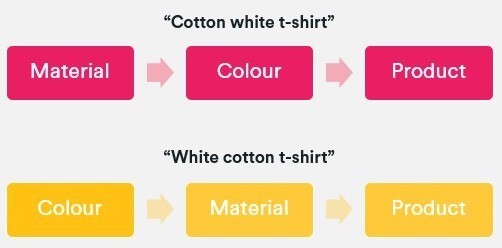
When this situation occurs, we should follow the same linguistic rules as above and choose a preferred sequence. In this case, it would be color + material + product type.
In comparison to the noindex tag suggested for on-page filters you should canonicalize unnecessary facets to their parent page (remembering that this is merely a hint and not a directive). This will enable you to control how crawlers deal with highly comparable result pages and will, therefore, help to prevent your site from being demoted in the SERPs. Dynamic search parameters should continue to be defined with a “noindex, nofollow” meta robots tag, disallowed in the robots.txt file, and configured through Google’s URL parameter tool (within your Search Console account) to tell crawlers the purpose of your parameters and how you would like them to be treated. This is a helpful guide on parameter handling for Googlebots, but bear in mind that this last tip won’t influence how Bing or Yahoo user-agents interpret these pages.
5. Open your facets in phases and cultivate it into a test-and-learn process. This will enable you to identify issues a lot sooner and implement facet-wide solutions in a timely manner. Without having to unravel these additional layers of complexity, problems such as crawl inefficiencies, PageRank dilution, or excessive indexation can be swiftly resolved.
To show you what this could look like, I’ve provided a phasing plan that was created for one of our e-commerce clients. Our research showed a significant SEO opportunity for opening up some of the facets and filters: potential +£263Kpcm for the “colour + type” facet (UK):
What’s more, when we extended our forecast to include other facet combinations, we calculated an additional revenue opportunity of up to +£207K/pcm (before filtering out combinations with no products offering).
Step 5: Optimize your facet URLs
Optimize your new facet category URLs to establish relevancy for your selected search terms. The key on-page elements to focus on include:
URL
Page title
Breadcrumb anchor texts
H tags
Content snippets (e.g. introductory text and FAQ copy)
Image ALT texts
Product names
Link out to similar facet category pages (i.e. via a “You May Also Like” feature box)
David’s Bridal is a good example of a retailer that has done this well. Looking back at the ‘Long Sleeve Wedding Dress’ Product Listing Page, we can see that they’ve curated unique content and followed fundamental optimization tactics on the landing page in a way that feels helpful to the user.
URL: davidsbridal.com/long-sleeve-wedding-dresses
Page Title: Long Sleeve Wedding Dresses & Gowns | David's Bridal
Meta Description: Do you dream of wearing a long sleeve wedding dress on your big day? Shop David's Bridal wide variety of wedding gowns with sleeves in lace & other designs!
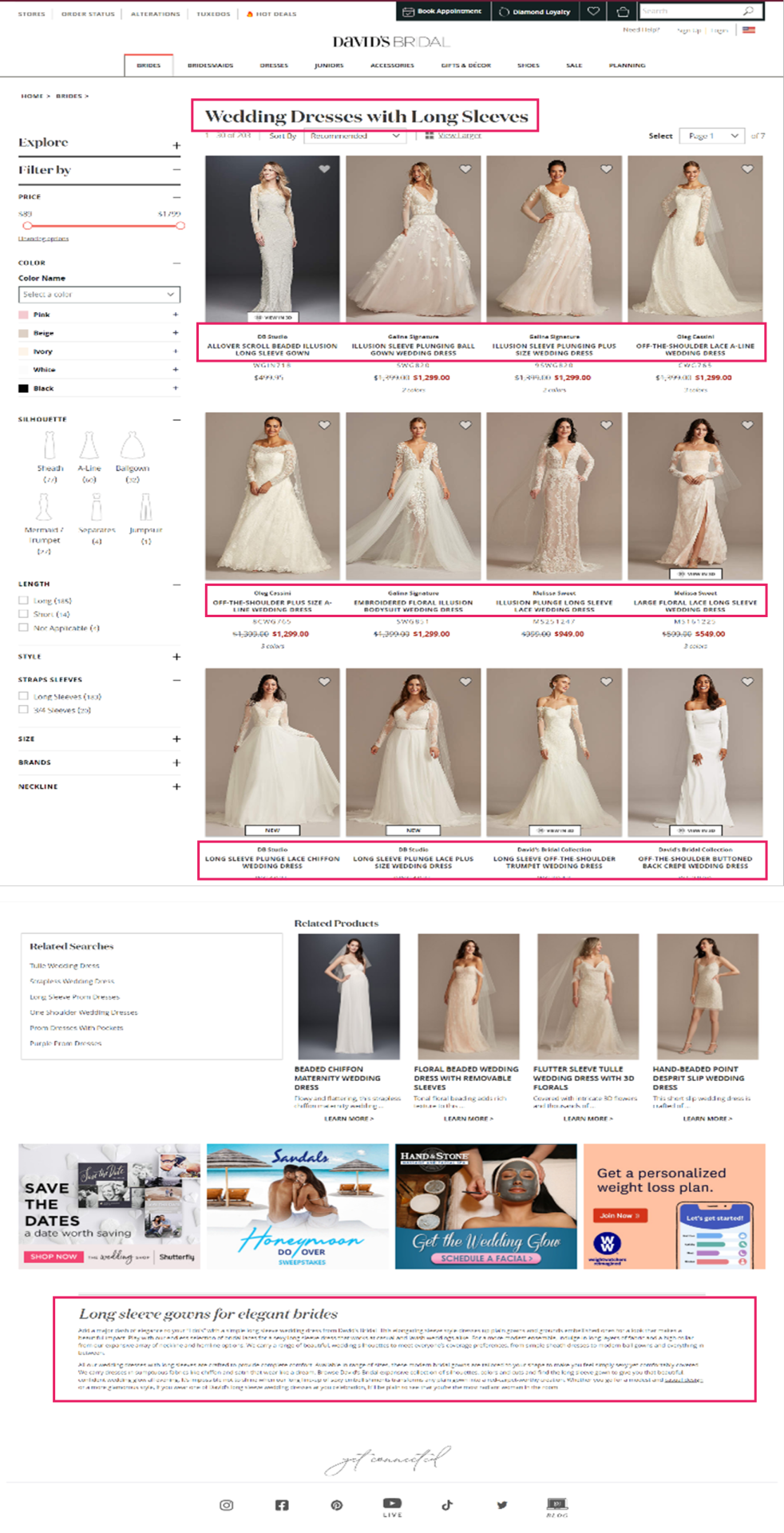
6. Provide accessibility and build page authority
Once you’ve opened up your new facet Product Listing Pages, you need to begin cultivating link equity towards them. This will ensure that they don’t exist as orphan URLs with no PageRank:
Ensure they’re referenced in your product XML sitemap.
If you have one feature per facet URL, then add them to your faceted navigation across CLP and Product Listing Page pages.
If you have two or more features per facet URL, then create a “Popular Searches” or “Related Searches” option within your CLPs.
Utilize your mega menu to showcase your new category landing pages. This will not only allow you to direct a large proportion of link equity, but it will also secure the highest click-through rate amongst your visitors.
Integrate your editorial strategy by creating engaging content with in-copy links. Think about how you can use descriptive long-tail anchor text about the Product Listing Page you want to link to rather than relying on “click here” or “see more”.
Connect to them via href links so you’re not solely relying on links from the main navigation or content hyperlinks. As this is difficult to do at scale, it can be done through modules such as “related categories”, “other subcategories”, “related products”, etc.
Devise strategic outreach campaigns that will secure quality, external backlinks to them.
Implementing this holistic and robust strategy will help you to secure exponential growth from your new commercial landing pages.
Conclusion
There is a great deal of organic opportunity that exists within your faceted navigation if you begin to leverage mid- and long-tail search terms.
Seek out the opportunity from extended keyword research and competitor analysis before deciding which variants fulfill consumer demands and deliver optimal organic sessions and onsite conversions. Configure a single faceted URL for each opportunity and open them up for crawl and indexation. Ensure PageRank is distributed to them (both internally and externally) and develop your landing page content in line with quality optimization practices. This approach will help you to avoid having crawl inefficiencies, over indexation, cannibalization, or having thin doorway pages. In turn, your website will be better suited to attract highly-targeted users and guide them down the purchase funnel.
Maximizing UX and reducing reliance on other marketing channels means that your faceted navigation can truly deliver organic ROI. We have seen this work for our clients.
0 notes
Note
for the fanfic meme: 10, 19, 23?
shortest wip of the year
So, besides a Jaladdin fic that is, like, three sentences and more of an abomination than a WIP, here: “How did you learn to read?” He asks it when they’re in bed together, Ronan a comfortable weight against his chest.
“Mm?” Ronan is never at his most aware when they’re like this, even though he’s sure to ask a hundred questions in several hours when Lazare is trying to sleep.
“In Paris, I know most men can write their names,” Lazare says, “However, in the country, it is considerably more rare. Especially for a peasant.”
It’s from the Between the Waves verse, set in between Ah, Ça Ira and PLP.
any new fics to start next year
I’m REALLY hoping to work more with MA next year. I have a few Ideas floating around that would work with Margrid/Orléans, both in terms of the canonical verse and in terms of a modern AU.
I would like to do more with Irish Mythology, if I’m not too burned out. Just...in general. More.
Also...Yuletide is probably going to bring a few more fics to light. I can’t say too much more than that, but at least one fic is guaranteed to come around the start of the new year, and a few others might pop up either then or shortly around then.
I’ve been toying with a 1789 Ladyhawke AU that I would LOVE to write. I’m not sure how much more I can do besides reiterate how much I want to write it, but I would be very interested in it.
I’m really interested in a fic where Aladdin and Jafar actually have to work together, because I think that, with their shared background, they could make for REALLY good partners in crime.
And, I’m obviously going to be fitting SOME time in to do exchanges, so there will probably end up being a few of the usual suspects in there. (Terra Nova tends to probably be my biggest Exchange Fic option here.)
fics you wanted to write but didn’t
AH YES, INTO THE REALM OF REGRETS.
There are a few fics that I’m still holding out hope for completing, but there are some that...I can’t do them justice, in the time left, so they might have to become New Year’s Resolutions.
A fic for @galentines dealing with The Polyamorous Pirate Trio: The Early Days (I HAVE NOT GIVEN UP, MY PLANS JUST MIGHT BE SLIGHTLY WAYLAID)
Fairytale AU for 1789- Partially written out, just needs to fill in a few gaps, but unfortunately filling gaps in is...well, not as fun as writing the fun scenes. Working on it.
When I was drafting out Cú Chulainn/Ferdiad for the exchange, I actually drafted out a fic where Lugh and CC have to try to bring Ferdiad back, and it was written in that kind of lofty Old Irish style. I still really, really like it and it will probably come out one day, but that is an EXHAUSTING style to write in and tbh I don’t care enough about Cú Chulainn/Ferdiad on their own to work with it. (Also: I wasn’t sure about its appropriateness for the exchange given that a certain OTHER character who I DO care very much for ended up taking over, as he is wont to do.)
This one has haunted me for about 2/3 years now, but there’s an Aífe/Emer fic that I partially wrote out, but because of the inherent trauma of Aífe’s story + my worries about the potential controversy over depicting Cú Chulainn as he exactly is, it’s been shelved. Which is a pity because, imo, some of my better writing’s in there.
Angsty MA...thing where Margrid’s in love with Fersen and Orléans is in love with Antoinette and they basically go for one another as a consolation only to accidentally catch feelings.
At least two or three things for the Between the Waves verse, though a PART of why they aren’t finished is simply because I feel like I might need to get one or two more chapters of PLP done before then (so. See you all in about. A year and a half.) Thus far, in terms of WIPs I have a Lazare POV (shown above), an Artois POV, an Olympe POV, and one whose very existence is a spoiler for the rest.
I feel like I could do both Bres/Sreng and Donal/Tiernan/Gráinne fics for a college AU set in an Unnamed Cozy College In The South Of Ireland, but. I think I might have to wait until AFTER I’m out of said college before I write it. For now. Though my finger might still slip before the year’s out; I’ve been known to do some questionable things when I’m mildly sleep deprived.
And a fic for Lord C/Lady C from Toho RetJ because fuck it, I’m INVESTED now, and Oka Kojiro did NOT have to go that hard for the role.
And....so many others. RIP, my cryogenically frozen children, you will be reborn again.
4 notes
·
View notes
Text
Fulfill Untapped Customer Demands Through Your Faceted Navigation
Faceted navigation allows customers to narrow down search results based on specific product attributes. They typically exist on Product Listing Pages (PLPs) and are a great way to help users intuitively discover products but managing this filtering system is a common SEO challenge. Crawling and indexation need to be controlled.
However, if we look beyond their inherent functionality, facets can offer us considerable potential. By centering your secondary navigation on long-tail keyword opportunities, you’ll be able to strategically utilize consumer intent, secure additional web conversions, and boost revenue levels.
Match consumer intent with long-tail search queries
Having an established brand and a solid domain backlink profile won’t guarantee success. This is great news for smaller brands, as industry giants aren’t necessarily going to win at this game.
If we search for “long sleeve wedding dresses”, we can see how David’s Bridal’s optimized facet page (Domain Authority: 67/100, Page Authority: 47 / 100) has obtained the top ranking position, while Nordstrom’s result (Domain Authority: 87/100, Page Authority: 39/100) appears in the third position for this particular query. We’ll take a look at what makes this page so effective later.
When looking at how we can optimize faceted navigations, it’s important to recognize that product attributes convey consumer needs and aspirations. If, for example, I’m looking for a wedding dress, then I may tailor my search by the color, fabric, neckline shape, and the sleeve length.
According to the search demand curve, long-tail queries account for up to 70% of all organic searches. They are highly targeted queries that offer big traffic-driving opportunities.
In the last few years, we’ve seen a big shift in the industry towards capitalizing this intent with long-form content. Blog articles and style guides have become the go-to methods for many to capture these visitors, as we can see from the examples taken from Marks & Spencers’ "Inspire Me" section:
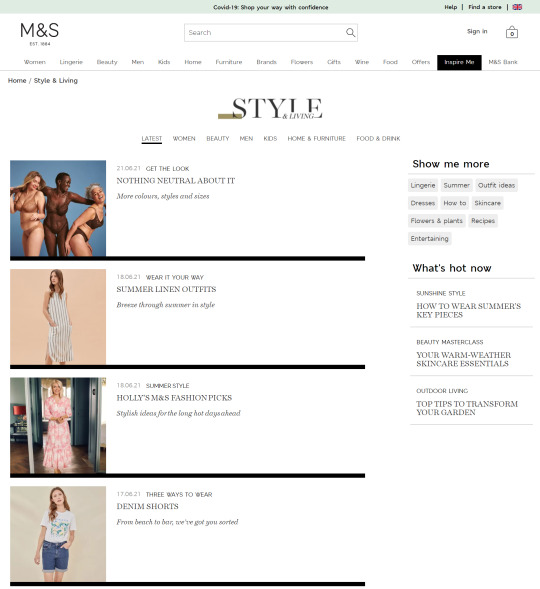
People often look for inspiration when they’re shopping, and these pages provide an effective way to add more internal links to category and product pages. But relying on this approach is one-dimensional, given that these deeper content pages tend to have lower PageRank. An extensive amount of time and effort will, therefore, be required to achieve the desired result.
In comparison, Product Listing Pages usually target broader search terms, and faceted navigations typically exist as passive functions. This is because they’re often blocked from crawlers, making them devoid of any SEO value. Waterstones (a well-known British bookstore) is one retailer that applies this rule for their on-page filters:
In this particular example, I’ve applied a filter to only show me books for 5 – 8 year olds, but the appended URL (https://ift.tt/3xrpOJS) is blocked in the robots.txt file. This is going to prevent such pages from being served in the SERPs despite them having the potential to meet specific customer needs. This shows that there can be a fundamental disconnect in matching customer intent to the pages we’re providing them in the organic results.
From the diagram below, we can see how editorial content typically focuses on the “awareness” and “interest” stages, whilst Product Listing Pages tend to be more in line with the “consideration” and “purchase” phases:
Serving the right content to users throughout their buying journey is pivotal to success. For many retailers, competitors are continuing to prioritize broader, high-volume keywords in saturated markets. They’re targeting the same terms to secure a proportion of the same search traffic. This is a very challenging prospect to face, and without carving out a gap in the marketplace, they won’t necessarily deliver the results they seek to secure. Likewise, relying on informational guides to target long-tail keywords means that you’re missing a large percentage of users who have very specific buying requirements. Yes, they’re ready to make a purchase!
By shifting your focus to address your customer’s real needs and expectations, you’ll be able to deliver a satisfying, frictionless experience at every interaction and all the way through to that final purchase.
The solution
Step 1: Conduct long-tail keyword research
Build a really comprehensive view of your potential customers by harnessing data from a variety of sources, including:
a) Keyword research tools like Moz, Google Keyword Planner, and Answer The Public.
b) The SERPs — get inspiration from the auto-suggest results, People Also Ask, and the related search links at the bottom of the page.
c) Competitor activity — aside from using SEO monitoring software, you can use a data mining extension tool like Scraper, which will extract faceted options directly from competitor Product Listing Pages. These tools are often free to download and allow you to quickly transfer product categories.
d) Your Google Search Console, Analytics, and PPC accounts to determine which keywords and URLs are securing the highest number of visits and web conversions. Internal search data can also give you great consumer insights.
e) Speak to your merchandising team to understand product demands and fulfillment capabilities.
Step 2: Group into meaningful sub-topics
Once you’ve collated all this information into a spreadsheet, you’ll be able to discover long-tail, consideration-orientated keywords. While individually they may not boast huge monthly search estimates, they can collectively highlight where purchase intentions can be better fulfilled.
To help illustrate this point, we can look at a small subset of lingerie keywords and the facets the searches represent:

From the table above we can quickly see a pattern emerging with color and material variations appearing across the search terms. We can then substantiate this information with session and revenue estimates with the use of a recognized CTR model. This enables us to help forecast the potential organic uplift and quantify the size of the prize for a number of different scenarios that are on offer from each new facet combination. This may include estimations for securing position 10, 7, 5, 3 and 1 in Google.
One thing to note here is that it’s worth excluding synonyms, as they will falsely inflate your calculations. An example here would be to exclude “storage drawers” (22.2k monthly searchers) when reviewing the performance for “chest of drawers” (201k m/s). Including both variants will cause a false positive result and will lead you to draw incorrect conclusions.
Step 3: Dig deeper into broader terms around offers, ratings, and price
These product filters are found in the “Sort” dropdown box and, from my experience, these are set to “noindex” from the outset as they simply allow users to re-order page results. Certainly, content management systems like Shopify and Shopware have this as a default.
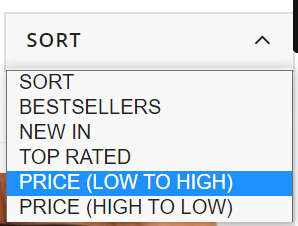
This makes sense since their purpose is to allow visitors to simply sort or narrow page content rather than offering alternative results and additional value (which is offered through faceted navigation). As such, filter typically produce duplicate results which should not be discoverable beyond the immediate moment. But this hard-and-fast rule doesn’t always apply perfectly in the real world. This is why we need to look at our individual industries and understand what’s important to our unique set of customers.
If we look at the world of gifting, we often see people shopping with a particular budget in mind. Therefore, terms like “birthday gift under £20” (40 m/s) or “Secret Santa gift under £10” (2.9k m/s) are reasonably common, and opening up relevant listing pages could be useful for shoppers.
Step 4: The technical steps
Facet taxonomies are hugely complex and the number of attributes that can be strung together increases with the size of the domain. We, therefore, need to carefully manage the flood gates and mitigate against any potential risks including crawl inefficiencies and link equity dilution.
We can do this by:
1. Avoiding thin/doorway pages by regularly re-assessing your product offering. For instance, you may consider there to be little value in creating a new listings page if you’re selling a very small range of low price point products. In this case, you may decide against opening up an additional Product Listing Page when you sell as few as 10 eligible products. However, this is not a fixed rule, so it’s quite possible that your criteria may be lower for particular product lines. Either way, these numbers will change over time. Consider seasonal trends, when new collections are launched, and when they become discontinued. Setting up a product retirement strategy to manage expired products and categories at scale in parallel with this step is also highly recommended.
2. Prevent content cannibalization by arranging selected facets according to their value and significance. “Size” is very important for some electrical goods like TVs, laptops, and cameras, but is less so for beauty accessories or vacuum cleaners. You must also make sure page content is distinctive and reflects the focus of your chosen facet(s). Refer to step 5 for more details.
3. Follow the sequence in which adjectives and facets are typically selected by your customers. This can vary depending on where your audience lives. So, whilst products generally have five or more distinguishable features, English vernacular determines that we use more than four adjectives (e.g. size + color + material + shape) to describe something.
4. Control the controllables by dealing with overlapping variations. This typically occurs when multiples co-exist and each exhibits good search metrics. For instance, it’s reasonable for someone to simultaneously look for several color and/or fabric combinations in the different ways below.
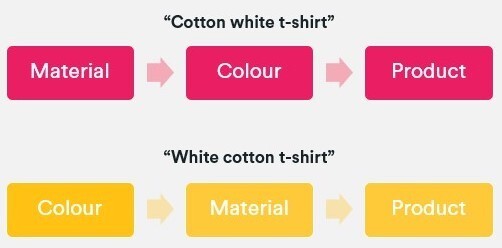
When this situation occurs, we should follow the same linguistic rules as above and choose a preferred sequence. In this case, it would be color + material + product type.
In comparison to the noindex tag suggested for on-page filters you should canonicalize unnecessary facets to their parent page (remembering that this is merely a hint and not a directive). This will enable you to control how crawlers deal with highly comparable result pages and will, therefore, help to prevent your site from being demoted in the SERPs. Dynamic search parameters should continue to be defined with a “noindex, nofollow” meta robots tag, disallowed in the robots.txt file, and configured through Google’s URL parameter tool (within your Search Console account) to tell crawlers the purpose of your parameters and how you would like them to be treated. This is a helpful guide on parameter handling for Googlebots, but bear in mind that this last tip won’t influence how Bing or Yahoo user-agents interpret these pages.
5. Open your facets in phases and cultivate it into a test-and-learn process. This will enable you to identify issues a lot sooner and implement facet-wide solutions in a timely manner. Without having to unravel these additional layers of complexity, problems such as crawl inefficiencies, PageRank dilution, or excessive indexation can be swiftly resolved.
To show you what this could look like, I’ve provided a phasing plan that was created for one of our e-commerce clients. Our research showed a significant SEO opportunity for opening up some of the facets and filters: potential +£263Kpcm for the “colour + type” facet (UK):
What’s more, when we extended our forecast to include other facet combinations, we calculated an additional revenue opportunity of up to +£207K/pcm (before filtering out combinations with no products offering).
Step 5: Optimize your facet URLs
Optimize your new facet category URLs to establish relevancy for your selected search terms. The key on-page elements to focus on include:
URL
Page title
Breadcrumb anchor texts
H tags
Content snippets (e.g. introductory text and FAQ copy)
Image ALT texts
Product names
Link out to similar facet category pages (i.e. via a “You May Also Like” feature box)
David’s Bridal is a good example of a retailer that has done this well. Looking back at the ‘Long Sleeve Wedding Dress’ Product Listing Page, we can see that they’ve curated unique content and followed fundamental optimization tactics on the landing page in a way that feels helpful to the user.
URL: davidsbridal.com/long-sleeve-wedding-dresses
Page Title: Long Sleeve Wedding Dresses & Gowns | David's Bridal
Meta Description: Do you dream of wearing a long sleeve wedding dress on your big day? Shop David's Bridal wide variety of wedding gowns with sleeves in lace & other designs!
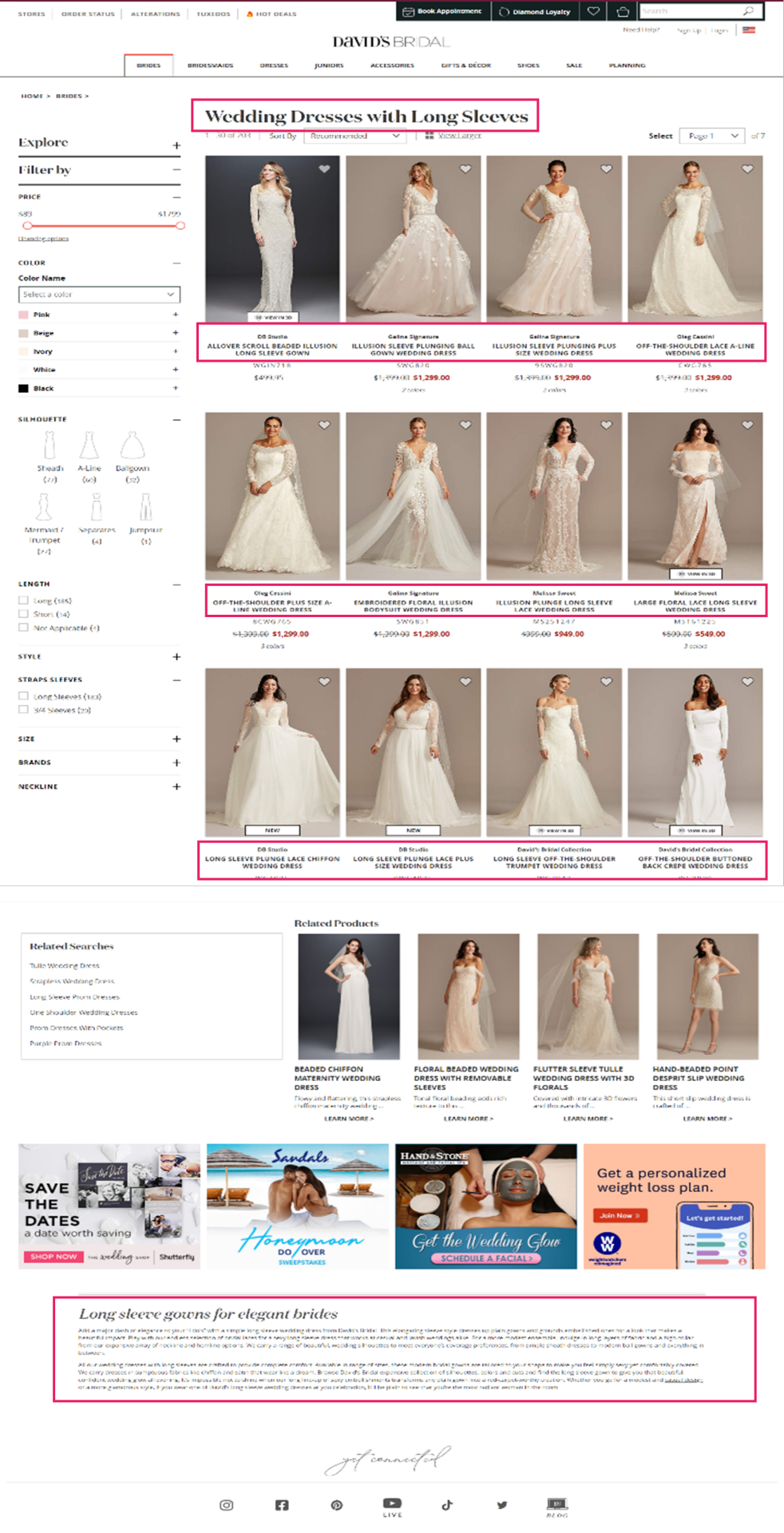
6. Provide accessibility and build page authority
Once you’ve opened up your new facet Product Listing Pages, you need to begin cultivating link equity towards them. This will ensure that they don’t exist as orphan URLs with no PageRank:
Ensure they’re referenced in your product XML sitemap.
If you have one feature per facet URL, then add them to your faceted navigation across CLP and Product Listing Page pages.
If you have two or more features per facet URL, then create a “Popular Searches” or “Related Searches” option within your CLPs.
Utilize your mega menu to showcase your new category landing pages. This will not only allow you to direct a large proportion of link equity, but it will also secure the highest click-through rate amongst your visitors.
Integrate your editorial strategy by creating engaging content with in-copy links. Think about how you can use descriptive long-tail anchor text about the Product Listing Page you want to link to rather than relying on “click here” or “see more”.
Connect to them via href links so you’re not solely relying on links from the main navigation or content hyperlinks. As this is difficult to do at scale, it can be done through modules such as “related categories”, “other subcategories”, “related products”, etc.
Devise strategic outreach campaigns that will secure quality, external backlinks to them.
Implementing this holistic and robust strategy will help you to secure exponential growth from your new commercial landing pages.
Conclusion
There is a great deal of organic opportunity that exists within your faceted navigation if you begin to leverage mid- and long-tail search terms.
Seek out the opportunity from extended keyword research and competitor analysis before deciding which variants fulfill consumer demands and deliver optimal organic sessions and onsite conversions. Configure a single faceted URL for each opportunity and open them up for crawl and indexation. Ensure PageRank is distributed to them (both internally and externally) and develop your landing page content in line with quality optimization practices. This approach will help you to avoid having crawl inefficiencies, over indexation, cannibalization, or having thin doorway pages. In turn, your website will be better suited to attract highly-targeted users and guide them down the purchase funnel.
Maximizing UX and reducing reliance on other marketing channels means that your faceted navigation can truly deliver organic ROI. We have seen this work for our clients.
https://ift.tt/3qUUr85
0 notes
Text
Fulfill Untapped Customer Demands Through Your Faceted Navigation
Faceted navigation allows customers to narrow down search results based on specific product attributes. They typically exist on Product Listing Pages (PLPs) and are a great way to help users intuitively discover products but managing this filtering system is a common SEO challenge. Crawling and indexation need to be controlled.
However, if we look beyond their inherent functionality, facets can offer us considerable potential. By centering your secondary navigation on long-tail keyword opportunities, you’ll be able to strategically utilize consumer intent, secure additional web conversions, and boost revenue levels.
Match consumer intent with long-tail search queries
Having an established brand and a solid domain backlink profile won’t guarantee success. This is great news for smaller brands, as industry giants aren’t necessarily going to win at this game.
If we search for “long sleeve wedding dresses”, we can see how David’s Bridal’s optimized facet page (Domain Authority: 67/100, Page Authority: 47 / 100) has obtained the top ranking position, while Nordstrom’s result (Domain Authority: 87/100, Page Authority: 39/100) appears in the third position for this particular query. We’ll take a look at what makes this page so effective later.
When looking at how we can optimize faceted navigations, it’s important to recognize that product attributes convey consumer needs and aspirations. If, for example, I’m looking for a wedding dress, then I may tailor my search by the color, fabric, neckline shape, and the sleeve length.
According to the search demand curve, long-tail queries account for up to 70% of all organic searches. They are highly targeted queries that offer big traffic-driving opportunities.
In the last few years, we’ve seen a big shift in the industry towards capitalizing this intent with long-form content. Blog articles and style guides have become the go-to methods for many to capture these visitors, as we can see from the examples taken from Marks & Spencers’ "Inspire Me" section:
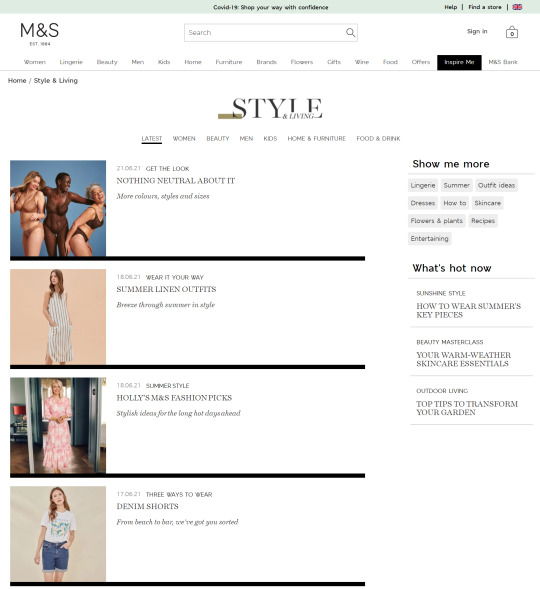
People often look for inspiration when they’re shopping, and these pages provide an effective way to add more internal links to category and product pages. But relying on this approach is one-dimensional, given that these deeper content pages tend to have lower PageRank. An extensive amount of time and effort will, therefore, be required to achieve the desired result.
In comparison, Product Listing Pages usually target broader search terms, and faceted navigations typically exist as passive functions. This is because they’re often blocked from crawlers, making them devoid of any SEO value. Waterstones (a well-known British bookstore) is one retailer that applies this rule for their on-page filters:
In this particular example, I’ve applied a filter to only show me books for 5 – 8 year olds, but the appended URL (https://www.waterstones.com/category/childrens-teenage/facet/498) is blocked in the robots.txt file. This is going to prevent such pages from being served in the SERPs despite them having the potential to meet specific customer needs. This shows that there can be a fundamental disconnect in matching customer intent to the pages we’re providing them in the organic results.
From the diagram below, we can see how editorial content typically focuses on the “awareness” and “interest” stages, whilst Product Listing Pages tend to be more in line with the “consideration” and “purchase” phases:
Serving the right content to users throughout their buying journey is pivotal to success. For many retailers, competitors are continuing to prioritize broader, high-volume keywords in saturated markets. They’re targeting the same terms to secure a proportion of the same search traffic. This is a very challenging prospect to face, and without carving out a gap in the marketplace, they won’t necessarily deliver the results they seek to secure. Likewise, relying on informational guides to target long-tail keywords means that you’re missing a large percentage of users who have very specific buying requirements. Yes, they’re ready to make a purchase!
By shifting your focus to address your customer’s real needs and expectations, you’ll be able to deliver a satisfying, frictionless experience at every interaction and all the way through to that final purchase.
The solution
Step 1: Conduct long-tail keyword research
Build a really comprehensive view of your potential customers by harnessing data from a variety of sources, including:
a) Keyword research tools like Moz, Google Keyword Planner, and Answer The Public.
b) The SERPs — get inspiration from the auto-suggest results, People Also Ask, and the related search links at the bottom of the page.
c) Competitor activity — aside from using SEO monitoring software, you can use a data mining extension tool like Scraper, which will extract faceted options directly from competitor Product Listing Pages. These tools are often free to download and allow you to quickly transfer product categories.
d) Your Google Search Console, Analytics, and PPC accounts to determine which keywords and URLs are securing the highest number of visits and web conversions. Internal search data can also give you great consumer insights.
e) Speak to your merchandising team to understand product demands and fulfillment capabilities.
Step 2: Group into meaningful sub-topics
Once you’ve collated all this information into a spreadsheet, you’ll be able to discover long-tail, consideration-orientated keywords. While individually they may not boast huge monthly search estimates, they can collectively highlight where purchase intentions can be better fulfilled.
To help illustrate this point, we can look at a small subset of lingerie keywords and the facets the searches represent:

From the table above we can quickly see a pattern emerging with color and material variations appearing across the search terms. We can then substantiate this information with session and revenue estimates with the use of a recognized CTR model. This enables us to help forecast the potential organic uplift and quantify the size of the prize for a number of different scenarios that are on offer from each new facet combination. This may include estimations for securing position 10, 7, 5, 3 and 1 in Google.
One thing to note here is that it’s worth excluding synonyms, as they will falsely inflate your calculations. An example here would be to exclude “storage drawers” (22.2k monthly searchers) when reviewing the performance for “chest of drawers” (201k m/s). Including both variants will cause a false positive result and will lead you to draw incorrect conclusions.
Step 3: Dig deeper into broader terms around offers, ratings, and price
These product filters are found in the “Sort” dropdown box and, from my experience, these are set to “noindex” from the outset as they simply allow users to re-order page results. Certainly, content management systems like Shopify and Shopware have this as a default.
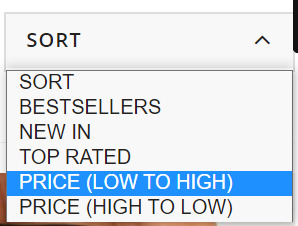
This makes sense since their purpose is to allow visitors to simply sort or narrow page content rather than offering alternative results and additional value (which is offered through faceted navigation). As such, filter typically produce duplicate results which should not be discoverable beyond the immediate moment. But this hard-and-fast rule doesn’t always apply perfectly in the real world. This is why we need to look at our individual industries and understand what’s important to our unique set of customers.
If we look at the world of gifting, we often see people shopping with a particular budget in mind. Therefore, terms like “birthday gift under £20” (40 m/s) or “Secret Santa gift under £10” (2.9k m/s) are reasonably common, and opening up relevant listing pages could be useful for shoppers.
Step 4: The technical steps
Facet taxonomies are hugely complex and the number of attributes that can be strung together increases with the size of the domain. We, therefore, need to carefully manage the flood gates and mitigate against any potential risks including crawl inefficiencies and link equity dilution.
We can do this by:
1. Avoiding thin/doorway pages by regularly re-assessing your product offering. For instance, you may consider there to be little value in creating a new listings page if you’re selling a very small range of low price point products. In this case, you may decide against opening up an additional Product Listing Page when you sell as few as 10 eligible products. However, this is not a fixed rule, so it’s quite possible that your criteria may be lower for particular product lines. Either way, these numbers will change over time. Consider seasonal trends, when new collections are launched, and when they become discontinued. Setting up a product retirement strategy to manage expired products and categories at scale in parallel with this step is also highly recommended.
2. Prevent content cannibalization by arranging selected facets according to their value and significance. “Size” is very important for some electrical goods like TVs, laptops, and cameras, but is less so for beauty accessories or vacuum cleaners. You must also make sure page content is distinctive and reflects the focus of your chosen facet(s). Refer to step 5 for more details.
3. Follow the sequence in which adjectives and facets are typically selected by your customers. This can vary depending on where your audience lives. So, whilst products generally have five or more distinguishable features, English vernacular determines that we use more than four adjectives (e.g. size + color + material + shape) to describe something.
4. Control the controllables by dealing with overlapping variations. This typically occurs when multiples co-exist and each exhibits good search metrics. For instance, it’s reasonable for someone to simultaneously look for several color and/or fabric combinations in the different ways below.
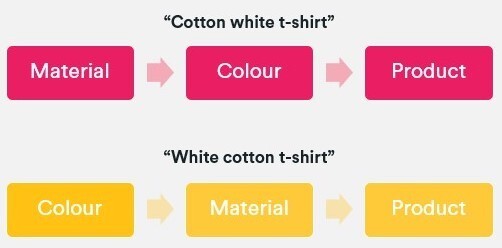
When this situation occurs, we should follow the same linguistic rules as above and choose a preferred sequence. In this case, it would be color + material + product type.
In comparison to the noindex tag suggested for on-page filters you should canonicalize unnecessary facets to their parent page (remembering that this is merely a hint and not a directive). This will enable you to control how crawlers deal with highly comparable result pages and will, therefore, help to prevent your site from being demoted in the SERPs. Dynamic search parameters should continue to be defined with a “noindex, nofollow” meta robots tag, disallowed in the robots.txt file, and configured through Google’s URL parameter tool (within your Search Console account) to tell crawlers the purpose of your parameters and how you would like them to be treated. This is a helpful guide on parameter handling for Googlebots, but bear in mind that this last tip won’t influence how Bing or Yahoo user-agents interpret these pages.
5. Open your facets in phases and cultivate it into a test-and-learn process. This will enable you to identify issues a lot sooner and implement facet-wide solutions in a timely manner. Without having to unravel these additional layers of complexity, problems such as crawl inefficiencies, PageRank dilution, or excessive indexation can be swiftly resolved.
To show you what this could look like, I’ve provided a phasing plan that was created for one of our e-commerce clients. Our research showed a significant SEO opportunity for opening up some of the facets and filters: potential +£263Kpcm for the “colour + type” facet (UK):
What’s more, when we extended our forecast to include other facet combinations, we calculated an additional revenue opportunity of up to +£207K/pcm (before filtering out combinations with no products offering).
Step 5: Optimize your facet URLs
Optimize your new facet category URLs to establish relevancy for your selected search terms. The key on-page elements to focus on include:
URL
Page title
Breadcrumb anchor texts
H tags
Content snippets (e.g. introductory text and FAQ copy)
Image ALT texts
Product names
Link out to similar facet category pages (i.e. via a “You May Also Like” feature box)
David’s Bridal is a good example of a retailer that has done this well. Looking back at the ‘Long Sleeve Wedding Dress’ Product Listing Page, we can see that they’ve curated unique content and followed fundamental optimization tactics on the landing page in a way that feels helpful to the user.
URL: davidsbridal.com/long-sleeve-wedding-dresses
Page Title: Long Sleeve Wedding Dresses & Gowns | David's Bridal
Meta Description: Do you dream of wearing a long sleeve wedding dress on your big day? Shop David's Bridal wide variety of wedding gowns with sleeves in lace & other designs!
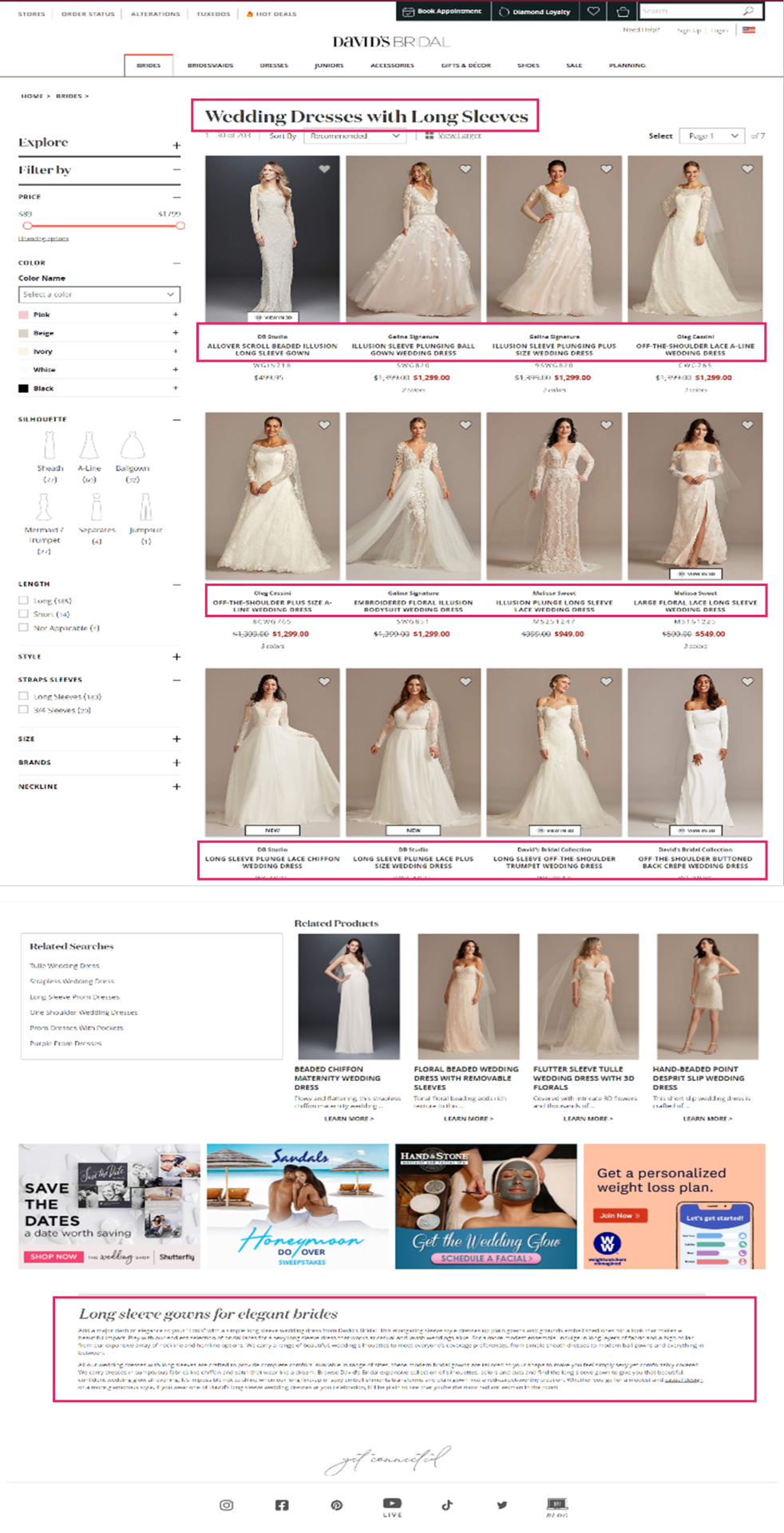
6. Provide accessibility and build page authority
Once you’ve opened up your new facet Product Listing Pages, you need to begin cultivating link equity towards them. This will ensure that they don’t exist as orphan URLs with no PageRank:
Ensure they’re referenced in your product XML sitemap.
If you have one feature per facet URL, then add them to your faceted navigation across CLP and Product Listing Page pages.
If you have two or more features per facet URL, then create a “Popular Searches” or “Related Searches” option within your CLPs.
Utilize your mega menu to showcase your new category landing pages. This will not only allow you to direct a large proportion of link equity, but it will also secure the highest click-through rate amongst your visitors.
Integrate your editorial strategy by creating engaging content with in-copy links. Think about how you can use descriptive long-tail anchor text about the Product Listing Page you want to link to rather than relying on “click here” or “see more”.
Connect to them via href links so you’re not solely relying on links from the main navigation or content hyperlinks. As this is difficult to do at scale, it can be done through modules such as “related categories”, “other subcategories”, “related products”, etc.
Devise strategic outreach campaigns that will secure quality, external backlinks to them.
Implementing this holistic and robust strategy will help you to secure exponential growth from your new commercial landing pages.
Conclusion
There is a great deal of organic opportunity that exists within your faceted navigation if you begin to leverage mid- and long-tail search terms.
Seek out the opportunity from extended keyword research and competitor analysis before deciding which variants fulfill consumer demands and deliver optimal organic sessions and onsite conversions. Configure a single faceted URL for each opportunity and open them up for crawl and indexation. Ensure PageRank is distributed to them (both internally and externally) and develop your landing page content in line with quality optimization practices. This approach will help you to avoid having crawl inefficiencies, over indexation, cannibalization, or having thin doorway pages. In turn, your website will be better suited to attract highly-targeted users and guide them down the purchase funnel.
Maximizing UX and reducing reliance on other marketing channels means that your faceted navigation can truly deliver organic ROI. We have seen this work for our clients.
0 notes
Text
Fulfill Untapped Customer Demands Through Your Faceted Navigation
Faceted navigation allows customers to narrow down search results based on specific product attributes. They typically exist on Product Listing Pages (PLPs) and are a great way to help users intuitively discover products but managing this filtering system is a common SEO challenge. Crawling and indexation need to be controlled.
However, if we look beyond their inherent functionality, facets can offer us considerable potential. By centering your secondary navigation on long-tail keyword opportunities, you’ll be able to strategically utilize consumer intent, secure additional web conversions, and boost revenue levels.
Match consumer intent with long-tail search queries
Having an established brand and a solid domain backlink profile won’t guarantee success. This is great news for smaller brands, as industry giants aren’t necessarily going to win at this game.
If we search for “long sleeve wedding dresses”, we can see how David’s Bridal’s optimized facet page (Domain Authority: 67/100, Page Authority: 47 / 100) has obtained the top ranking position, while Nordstrom’s result (Domain Authority: 87/100, Page Authority: 39/100) appears in the third position for this particular query. We’ll take a look at what makes this page so effective later.
When looking at how we can optimize faceted navigations, it’s important to recognize that product attributes convey consumer needs and aspirations. If, for example, I’m looking for a wedding dress, then I may tailor my search by the color, fabric, neckline shape, and the sleeve length.
According to the search demand curve, long-tail queries account for up to 70% of all organic searches. They are highly targeted queries that offer big traffic-driving opportunities.
In the last few years, we’ve seen a big shift in the industry towards capitalizing this intent with long-form content. Blog articles and style guides have become the go-to methods for many to capture these visitors, as we can see from the examples taken from Marks & Spencers’ "Inspire Me" section:
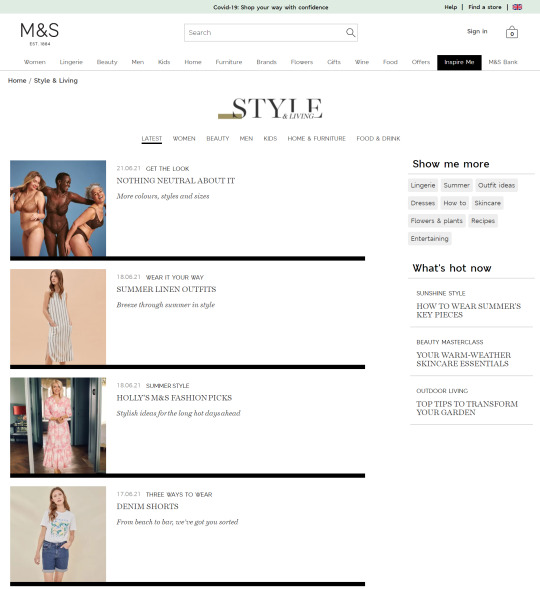
People often look for inspiration when they’re shopping, and these pages provide an effective way to add more internal links to category and product pages. But relying on this approach is one-dimensional, given that these deeper content pages tend to have lower PageRank. An extensive amount of time and effort will, therefore, be required to achieve the desired result.
In comparison, Product Listing Pages usually target broader search terms, and faceted navigations typically exist as passive functions. This is because they’re often blocked from crawlers, making them devoid of any SEO value. Waterstones (a well-known British bookstore) is one retailer that applies this rule for their on-page filters:
In this particular example, I’ve applied a filter to only show me books for 5 – 8 year olds, but the appended URL (https://www.waterstones.com/category/childrens-teenage/facet/498) is blocked in the robots.txt file. This is going to prevent such pages from being served in the SERPs despite them having the potential to meet specific customer needs. This shows that there can be a fundamental disconnect in matching customer intent to the pages we’re providing them in the organic results.
From the diagram below, we can see how editorial content typically focuses on the “awareness” and “interest” stages, whilst Product Listing Pages tend to be more in line with the “consideration” and “purchase” phases:
Serving the right content to users throughout their buying journey is pivotal to success. For many retailers, competitors are continuing to prioritize broader, high-volume keywords in saturated markets. They’re targeting the same terms to secure a proportion of the same search traffic. This is a very challenging prospect to face, and without carving out a gap in the marketplace, they won’t necessarily deliver the results they seek to secure. Likewise, relying on informational guides to target long-tail keywords means that you’re missing a large percentage of users who have very specific buying requirements. Yes, they’re ready to make a purchase!
By shifting your focus to address your customer’s real needs and expectations, you’ll be able to deliver a satisfying, frictionless experience at every interaction and all the way through to that final purchase.
The solution
Step 1: Conduct long-tail keyword research
Build a really comprehensive view of your potential customers by harnessing data from a variety of sources, including:
a) Keyword research tools like Moz, Google Keyword Planner, and Answer The Public.
b) The SERPs — get inspiration from the auto-suggest results, People Also Ask, and the related search links at the bottom of the page.
c) Competitor activity — aside from using SEO monitoring software, you can use a data mining extension tool like Scraper, which will extract faceted options directly from competitor Product Listing Pages. These tools are often free to download and allow you to quickly transfer product categories.
d) Your Google Search Console, Analytics, and PPC accounts to determine which keywords and URLs are securing the highest number of visits and web conversions. Internal search data can also give you great consumer insights.
e) Speak to your merchandising team to understand product demands and fulfillment capabilities.
Step 2: Group into meaningful sub-topics
Once you’ve collated all this information into a spreadsheet, you’ll be able to discover long-tail, consideration-orientated keywords. While individually they may not boast huge monthly search estimates, they can collectively highlight where purchase intentions can be better fulfilled.
To help illustrate this point, we can look at a small subset of lingerie keywords and the facets the searches represent:
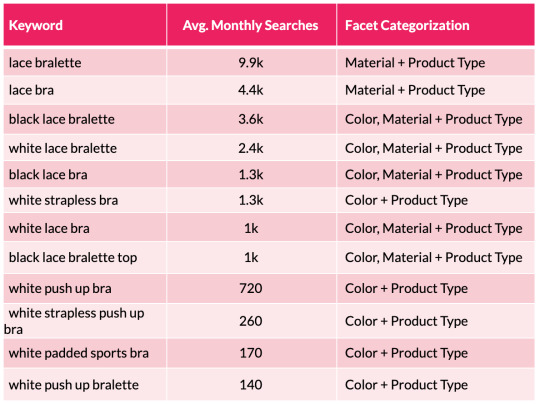
From the table above we can quickly see a pattern emerging with color and material variations appearing across the search terms. We can then substantiate this information with session and revenue estimates with the use of a recognized CTR model. This enables us to help forecast the potential organic uplift and quantify the size of the prize for a number of different scenarios that are on offer from each new facet combination. This may include estimations for securing position 10, 7, 5, 3 and 1 in Google.
One thing to note here is that it’s worth excluding synonyms, as they will falsely inflate your calculations. An example here would be to exclude “storage drawers” (22.2k monthly searchers) when reviewing the performance for “chest of drawers” (201k m/s). Including both variants will cause a false positive result and will lead you to draw incorrect conclusions.
Step 3: Dig deeper into broader terms around offers, ratings, and price
These product filters are found in the “Sort” dropdown box and, from my experience, these are set to “noindex” from the outset as they simply allow users to re-order page results. Certainly, content management systems like Shopify and Shopware have this as a default.
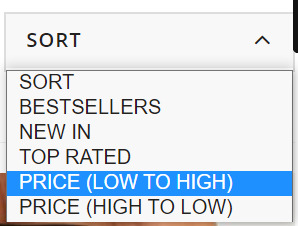
This makes sense since their purpose is to allow visitors to simply sort or narrow page content rather than offering alternative results and additional value (which is offered through faceted navigation). As such, filter typically produce duplicate results which should not be discoverable beyond the immediate moment. But this hard-and-fast rule doesn’t always apply perfectly in the real world. This is why we need to look at our individual industries and understand what’s important to our unique set of customers.
If we look at the world of gifting, we often see people shopping with a particular budget in mind. Therefore, terms like “birthday gift under £20” (40 m/s) or “Secret Santa gift under £10” (2.9k m/s) are reasonably common, and opening up relevant listing pages could be useful for shoppers.
Step 4: The technical steps
Facet taxonomies are hugely complex and the number of attributes that can be strung together increases with the size of the domain. We, therefore, need to carefully manage the flood gates and mitigate against any potential risks including crawl inefficiencies and link equity dilution.
We can do this by:
1. Avoiding thin/doorway pages by regularly re-assessing your product offering. For instance, you may consider there to be little value in creating a new listings page if you’re selling a very small range of low price point products. In this case, you may decide against opening up an additional Product Listing Page when you sell as few as 10 eligible products. However, this is not a fixed rule, so it’s quite possible that your criteria may be lower for particular product lines. Either way, these numbers will change over time. Consider seasonal trends, when new collections are launched, and when they become discontinued. Setting up a product retirement strategy to manage expired products and categories at scale in parallel with this step is also highly recommended.
2. Prevent content cannibalization by arranging selected facets according to their value and significance. “Size” is very important for some electrical goods like TVs, laptops, and cameras, but is less so for beauty accessories or vacuum cleaners. You must also make sure page content is distinctive and reflects the focus of your chosen facet(s). Refer to step 5 for more details.
3. Follow the sequence in which adjectives and facets are typically selected by your customers. This can vary depending on where your audience lives. So, whilst products generally have five or more distinguishable features, English vernacular determines that we use more than four adjectives (e.g. size + color + material + shape) to describe something.
4. Control the controllables by dealing with overlapping variations. This typically occurs when multiples co-exist and each exhibits good search metrics. For instance, it’s reasonable for someone to simultaneously look for several color and/or fabric combinations in the different ways below.

When this situation occurs, we should follow the same linguistic rules as above and choose a preferred sequence. In this case, it would be color + material + product type.
In comparison to the noindex tag suggested for on-page filters you should canonicalize unnecessary facets to their parent page (remembering that this is merely a hint and not a directive). This will enable you to control how crawlers deal with highly comparable result pages and will, therefore, help to prevent your site from being demoted in the SERPs. Dynamic search parameters should continue to be defined with a “noindex, nofollow” meta robots tag, disallowed in the robots.txt file, and configured through Google’s URL parameter tool (within your Search Console account) to tell crawlers the purpose of your parameters and how you would like them to be treated. This is a helpful guide on parameter handling for Googlebots, but bear in mind that this last tip won’t influence how Bing or Yahoo user-agents interpret these pages.
5. Open your facets in phases and cultivate it into a test-and-learn process. This will enable you to identify issues a lot sooner and implement facet-wide solutions in a timely manner. Without having to unravel these additional layers of complexity, problems such as crawl inefficiencies, PageRank dilution, or excessive indexation can be swiftly resolved.
To show you what this could look like, I’ve provided a phasing plan that was created for one of our e-commerce clients. Our research showed a significant SEO opportunity for opening up some of the facets and filters: potential +£263Kpcm for the “colour + type” facet (UK):
What’s more, when we extended our forecast to include other facet combinations, we calculated an additional revenue opportunity of up to +£207K/pcm (before filtering out combinations with no products offering).
Step 5: Optimize your facet URLs
Optimize your new facet category URLs to establish relevancy for your selected search terms. The key on-page elements to focus on include:
URL
Page title
Breadcrumb anchor texts
H tags
Content snippets (e.g. introductory text and FAQ copy)
Image ALT texts
Product names
Link out to similar facet category pages (i.e. via a “You May Also Like” feature box)
David’s Bridal is a good example of a retailer that has done this well. Looking back at the ‘Long Sleeve Wedding Dress’ Product Listing Page, we can see that they’ve curated unique content and followed fundamental optimization tactics on the landing page in a way that feels helpful to the user.
URL: davidsbridal.com/long-sleeve-wedding-dresses
Page Title: Long Sleeve Wedding Dresses & Gowns | David's Bridal
Meta Description: Do you dream of wearing a long sleeve wedding dress on your big day? Shop David's Bridal wide variety of wedding gowns with sleeves in lace & other designs!
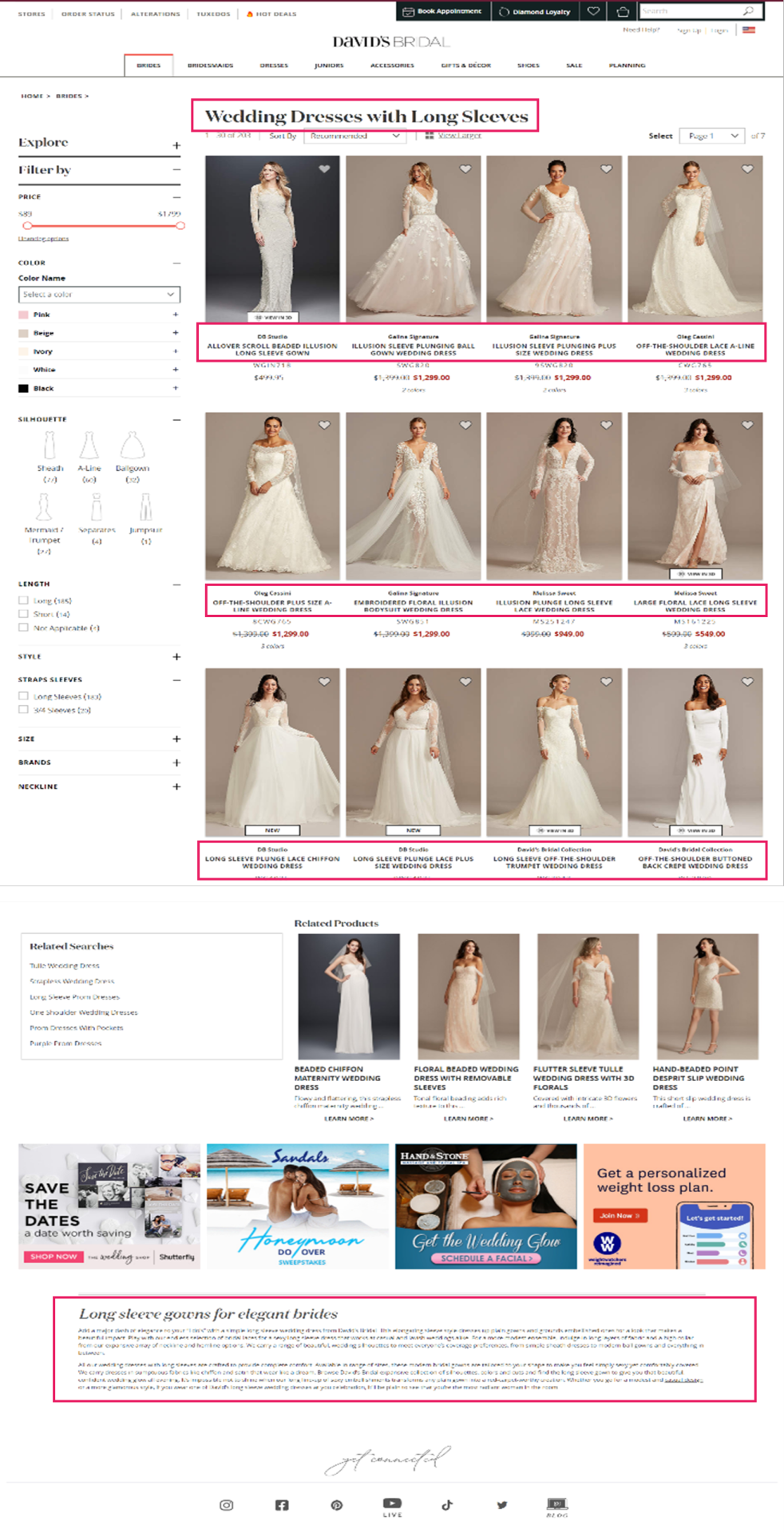
6. Provide accessibility and build page authority
Once you’ve opened up your new facet Product Listing Pages, you need to begin cultivating link equity towards them. This will ensure that they don’t exist as orphan URLs with no PageRank:
Ensure they’re referenced in your product XML sitemap.
If you have one feature per facet URL, then add them to your faceted navigation across CLP and Product Listing Page pages.
If you have two or more features per facet URL, then create a “Popular Searches” or “Related Searches” option within your CLPs.
Utilize your mega menu to showcase your new category landing pages. This will not only allow you to direct a large proportion of link equity, but it will also secure the highest click-through rate amongst your visitors.
Integrate your editorial strategy by creating engaging content with in-copy links. Think about how you can use descriptive long-tail anchor text about the Product Listing Page you want to link to rather than relying on “click here” or “see more”.
Connect to them via href links so you’re not solely relying on links from the main navigation or content hyperlinks. As this is difficult to do at scale, it can be done through modules such as “related categories”, “other subcategories”, “related products”, etc.
Devise strategic outreach campaigns that will secure quality, external backlinks to them.
Implementing this holistic and robust strategy will help you to secure exponential growth from your new commercial landing pages.
Conclusion
There is a great deal of organic opportunity that exists within your faceted navigation if you begin to leverage mid- and long-tail search terms.
Seek out the opportunity from extended keyword research and competitor analysis before deciding which variants fulfill consumer demands and deliver optimal organic sessions and onsite conversions. Configure a single faceted URL for each opportunity and open them up for crawl and indexation. Ensure PageRank is distributed to them (both internally and externally) and develop your landing page content in line with quality optimization practices. This approach will help you to avoid having crawl inefficiencies, over indexation, cannibalization, or having thin doorway pages. In turn, your website will be better suited to attract highly-targeted users and guide them down the purchase funnel.
Maximizing UX and reducing reliance on other marketing channels means that your faceted navigation can truly deliver organic ROI. We have seen this work for our clients.
0 notes